VOLUME
ISSUE 06
Citation: Déjà Vu
An odd intuitive feeling warms our heart and consciousness – déjà vu.
As migrating strangers, in search of a purpose, become common bedfellows of past and future they cite, recite, incite, and prophesize a paradox; A paradox which is a reverberating soundscape of change, of return. One where both cancel each other out in an audiotized schematic, whirling away only to remain a citation in memory. To attempt to cite, translate, decipher and re-member that moment of paradox fails as the speed of technologized everyday resists the mere attempt.
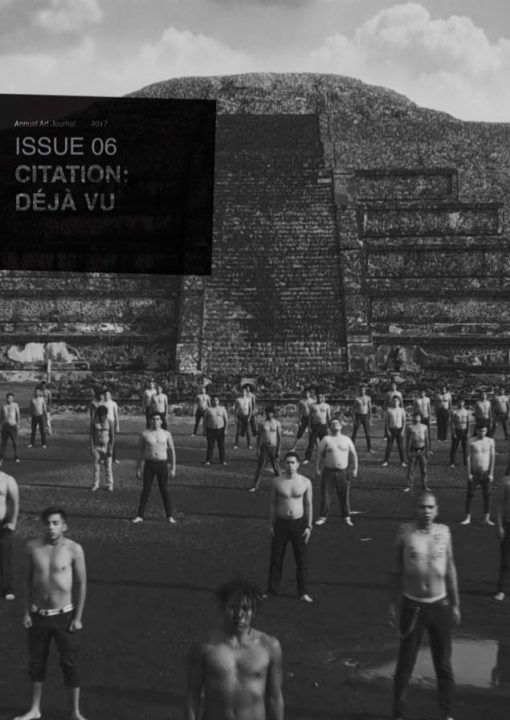
ISSUE 06
2017
Citation: Déjà Vu
ISSN : 23154802
Introduction
Essays
Exhibition
Conversation
Contributors’ Bios
Introduction
Introduction: Citation: déjà vu
Essays
Need for Mondrian
‘public preposition’ – déjà vu? – collecting memories!
Art History and the Contemporary in Southeast Asia
Souvenirs from the Past that Never Was
Everything Old is New Again: Musical Appropriation in the 19th and mid-20th centuries
Creative Futures
Aspirants
Exhibition
SOMETIMES I REPEAT MYSELF
Conversation
Contributors’ Bios
Contributors’ Bios
Introduction
Editor
Venka Purushothaman
Associate Editor
Susie Wong
Copy Editor
Jean Wong
Advisor
Milenko Prvački
Manager
Layna Ajera
Contributors
Mitha Budhyarto
Joseph Curiale
Patrick D. Flores
Frank DeMeglio
Janis Jefferies
Mischa Kuball
Vanessa Joan Müller
Timothy O’Dwyer
Sava Stepanov
Jessica Berlanga Taylor
Susie Wong
June Yap
Introduction
Introduction: Citation: déjà vu
déjà vu.
As migrating strangers, in search of a purpose, become common bedfellows of past and future, they cite, recite, incite, and prophesise a paradox. A turbulent world remembered, as lines of humanity cross their geographical, existential and mediatised borders; as they open and close, appear and disappear: The strong flex, the small quiver.
We cite these moments. We recall we have been there before. A paradox which is a reverberating soundscape of change, of return. One where each cancels the other out in an audiotised schematic, whirling away only to remain a citation in memory. To attempt to cite, translate, decipher and re-member that moment of paradox fails as the speed of technologised everyday resists the mere attempt. One can instance the the speed. For example, the immediate availability of information today facilitated by technology demands a response of urgency providing little scope for referencing, citing and contextualising, which are being replaced by speculation, tip-offs and banter.
ISSUE 6 presents a rich and diverse set of artists, artist-scholars, curators, and researchers reflecting on and contextualising the issue of citation: déjà vu as they see it, and critically and refreshingly use it as a platform to reflect on the current conditions of the world.
We know the future because we have been there.
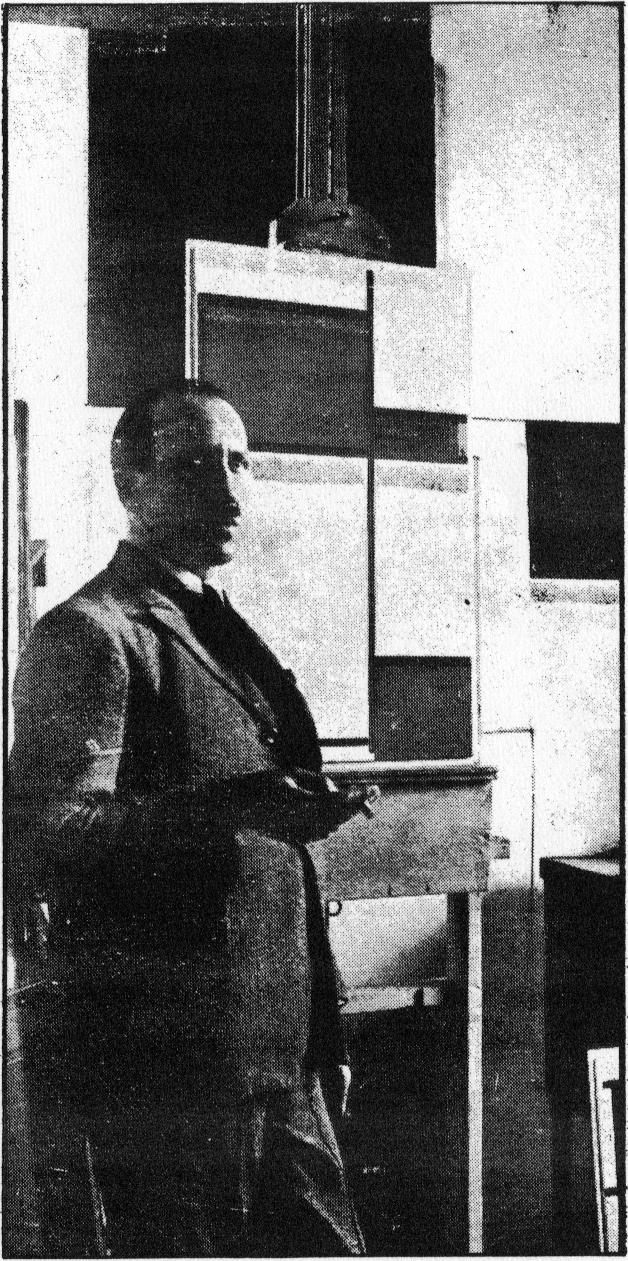
P. Mondrian in his studio in Paris. 1923.
Photo: Anonymous. From De Stijl, vol. VI, nr. 6/7 (1924): p. 86. Public Domain.
Essays
Need for Mondrian
By the end of the second decade of the 20th century, Piet Mondrian was already a formed landscape painter, slightly under the influence of Van Gogh, the Fauves and Pointillists. In 1911, at the Moderne Kunst Kring (Modern Art Circle) exhibition in Amsterdam, he became acquainted with the Cubist paintings of Picasso and Braque. For him, this was truly a watershed moment. Intrigued by new artistic tendencies, he moved to Paris that same year, joined the Cubists, socialised with them, and changed his painting style. In one of his reviews, Apollinaire soon noted Mondrian’s “very abstract Cubism.”1 Mondrian’s approach to Cubism is analytical – he radically dissolves a motif, insisting on the autonomous reality of image rather than the analysis of reality. Even at that time, Mondrian was systematic and gradually moved into the realm of abstraction. From the early 1912 to the summer of 1914, he got closer to the Purist understanding of line drawings – insisting on the inviolability of vertical and horizontal lines, and eliminating curved and even diagonal lines.
In 1914, because of his father’s illness, he was forced to leave Paris and return to the Netherlands. His father, a teacher and a religious fanatic, neglected the material aspect of existence, impoverishing the family because of his asceticism.2 Emerging from a rigid Protestant spirit, with an adopted Calvinist worldview, Mondrian’s Cubism of the time “was rational but not enough because it did not lead to the ultimate limit of reduction,” observed leading Italian art historian, Giulio Carlo Argan.3 Hence, Mondrian insisted on a drastic reduction: all was based on the rectangular positions of horizontal and vertical lines or regular square and rectangular planes, some of which he painted with primary red, blue and yellow. The solid, grid-like linear scheme became the conceptual basis of his paintings and his entire artistic philosophy. Mondrian’s contemporary, Herbert Read, identified the origin of this attitude. Forgoing all etiquette, he wrote: “Mondrian was not an intellectual in the conventional sense of the word and had no wide range of knowledge or experience. But he had mastered a vocabulary taken from a single source – the Dutch philosopher M.H.J. Schoenmaekers (Mathieu Hubertus Josephus Schoenmaekers).”4 Be as it may, Schoenmaekers appeared as an ideal interlocutor, because much of his philosophical discourse coincided with the Mondrian pictorial concept at the time. This refers, in particular, to the above-mentioned geometric linearism. In the book Principles of Plastic Mathematics (1916), Schoenmaekers wrote: “Nature is alive and unpredictable in its diversity, but basically it always works with absolute regularity, i.e. with plastic regularity,”5 whereas Mondrian, as pointed out by Herbert Read, “defines Neoplasticism as means by which the changeable nature can be reduced to the plastic expression of certain relations. Just like math, art becomes an intuitive means for presenting the basic characteristics of the cosmos.”6
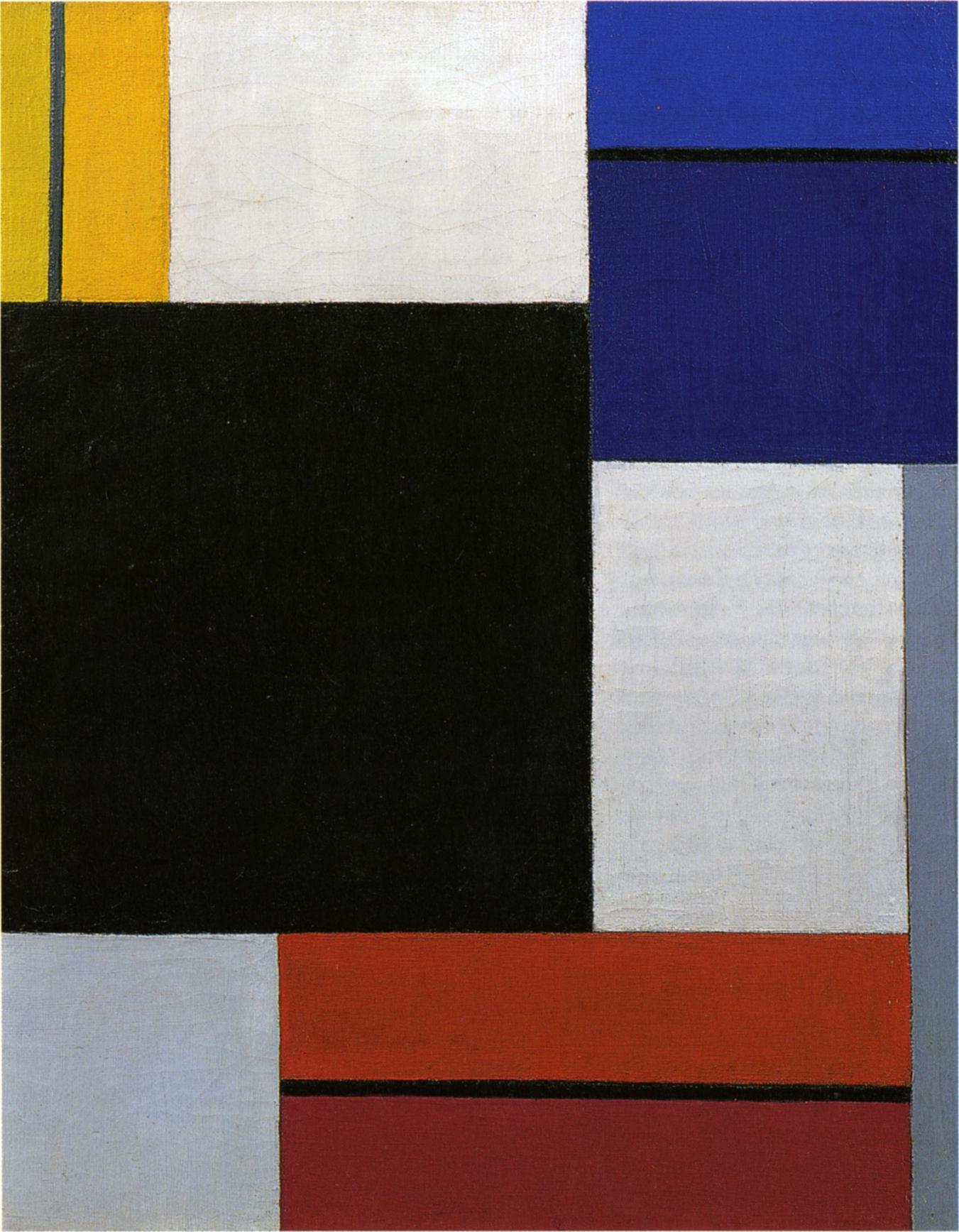
Theo van Doesburg, Composition XXI, 1923. Public domain.
Mondrian met Schoenmaekers in Laren, a small Dutch town about 30 kilometers east of Amsterdam, where he lived during the Great War. During the First World War, Laren was considered an artistic colony and was even called the “little Paris.” During his stay in Laren, Mondrian did not paint. Rather, he devoted himself to philosophical discussions with Schoenmaekers and wrote articles on the theory of painting. There, he also met Theo van Doesburg and Bart van der Leck, Dutch artists with similar ideas about the image. They were both painters of abstraction based on a rectangular geometry, primary colours, and balanced relations within the image. Thanks to Doesburg’s initiative, the three of them soon became the pillars ofDe Stijl group.7
Although Doesburg was the initiator and leader of De Stijl, the most important member of the group since its foundation was Piet Mondrian. He saw art as a possibility for realising the ideals of universal order and harmony, and it is on these principles that the whole group operated. Mondrian discussed this utopian obsession in the article, Neoplasticism in Painting, published in installments in the first 12 issues of De Stijl journal. The principal aspiration of Mondrian and other members of the group was to impose the principles of geometric painting and architecture onto society. However, one should bear in mind that these ideas were conceived in a specific social context. Mondrian’s Neoplasticism has a genuine civic origin. As Karl Ruhrberg shrewdly observes, both Mondrian’s oeuvre and the whole De Stijl concept are reflections of the Dutch landscape stolen from the sea by man. They symbolise the supremacy of the human spirit which brings order to unbridled, unregulated nature. “This does not mean that painters secretly reproduce nature. On the contrary, it means that neoplasticistic painting is the fruit of the very same spirit that creates order. Peace, harmony and discipline are characteristics of this art and its utopian goal is the complete harmony of the world.”8
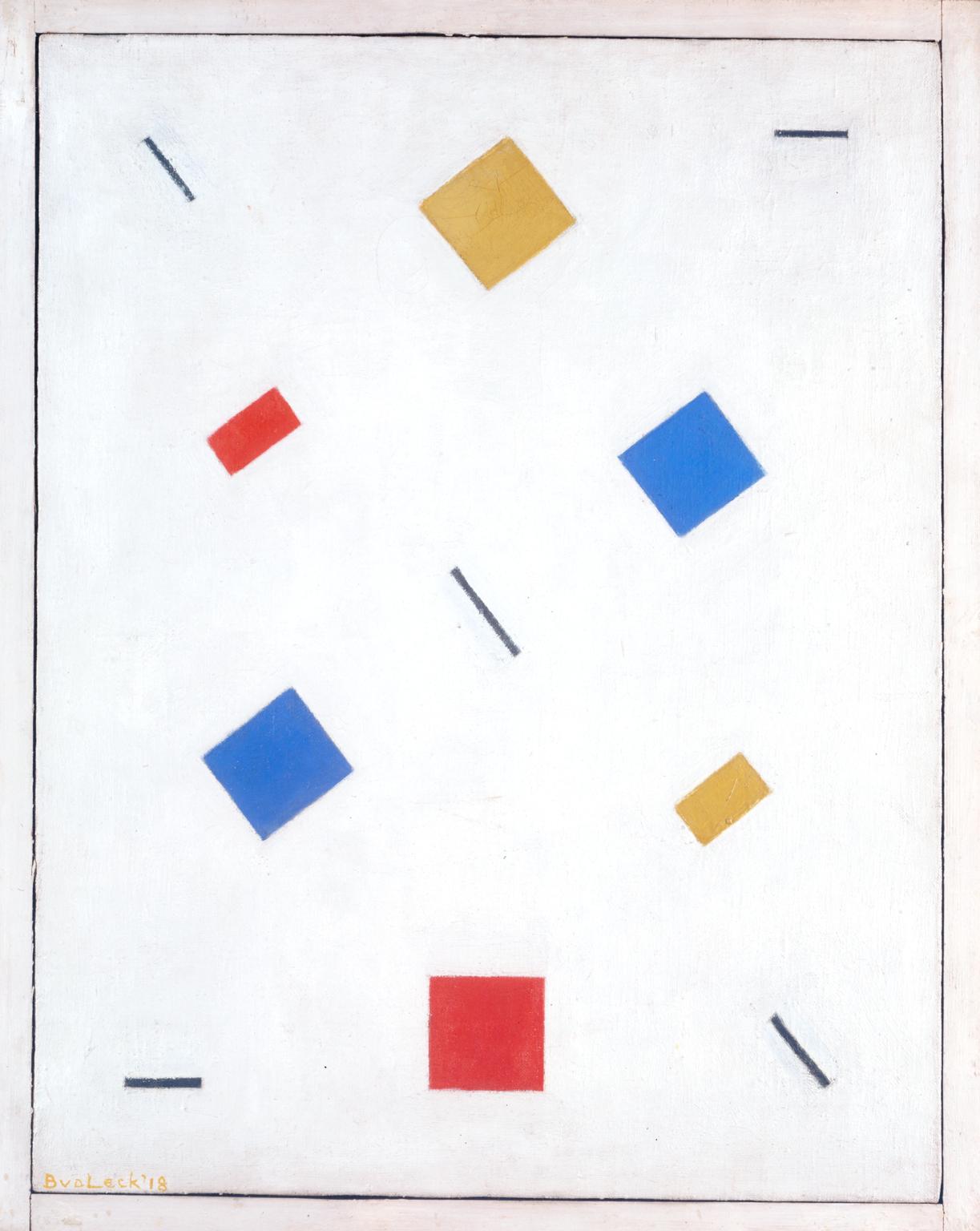
Bart van der Leck, Composition, 1918. Collection of Tate, DACS, 2017.
No matter how much this group of artists—gathered together in a small Dutch town of Laren in those dark war years—may have seemed “relocated” and isolated from the main trends of artistic modernity, today’s art history show that De Stijl made a major impact on the art and culture of the world. Argan notes that “De Stijl, in fact, is a key episode in understanding the history of contemporary art.”9 In the midst of rising political tensions, conflicts, the Great War, the Soviet revolution, the looming onset of Second World War, etcetera, the artistic idea of harmony was badly needed in the world. These were the circumstances and reasons that motivated not only Russian Constructivists and Malevich’s Suprematism, but also Mondrian’s geometric abstraction, De Stijl’s Neoplasticism, and the Bauhaus aesthetic. Amid the chaos of Europe during that time, artists were looking for different relationships, for harmony, for measure. The De Stijl’s Manifesto, written in 1918, states that the ongoing “war is destroying the old world with its contents and the new art brings a new awareness, a balance between universal and individual; and this new awareness is ready to be implemented in everything, even in outer life. Mondrian and the painters of Neoplasticism found this new awareness in their new organisation of image, especially in rationalist geometrism.” Argan aptly formulated Mondrian’s understanding of geometry in painting and art: “Ethica ordine geometrico demonstrata.”10
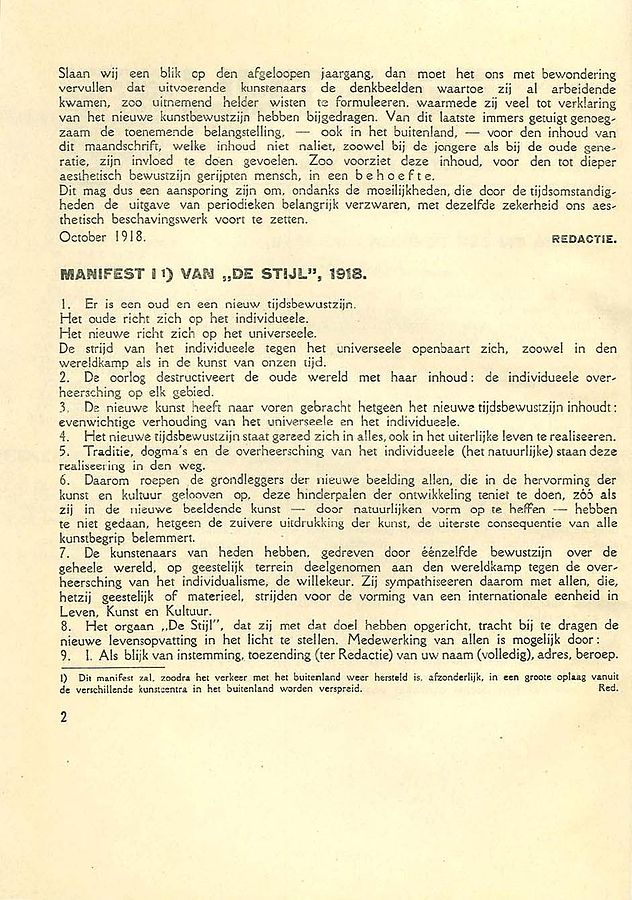
Manifest I of De Stijl, 1918. Public Domain.
Yet, art history tells us that Mondrian and his friends were not the only European painters of the time. The spirit of that time brought about changes. This will become especially evident once the closeness of Russian Constructivism, Malevich’s Suprematism, Mondrian’s rationalist abstraction, and De Stijl’s Neoplasticism is first observed and, perhaps, even more evident after their merger into the Bauhaus methodology. It was then, perhaps for the first time, that the ideal of the modernist awareness was realised. Filiberto Menna will later write about this in the book Project of Modern Art: “Aesthetic space therefore becomes a place for the movement of the individual in the direction of his full self-realisation: art activity, returned to the state typical of self-directed action, provides a model of behaviour and work upon which it is possible to establish a new relationship between subject and object, individual and collective. This is a romantic testament inherited by the artistic avant-garde movements of the 20th century and their aesthetic ideology: art is entitled to the autonomy of its own, not in order to be isolated but in order to offer its own model to other spheres of knowledge and practice.”11
Mondrian firmly believed in the same principles. For him, painting was increasingly becoming a social project for real life situations. After the end of the First World War, Mondrian returned to Paris and to his studio on Boulevard Raspail 278. It was there that he made his early cubist works, prior to 1914. His art, however, completely changed after the war. In line with new neoplasticist ideas, his work became plastically simpler, more socially effective, and more comprehensive. Mondrian completely rearranged his studio: he brought in minimalist furniture and painted the walls with black, red, blue, and yellow rectangles; he hung his characteristic geometric paintings on the walls; even his easel was precisely positioned as an object in a well-organised spatial composition. Mondrian’s studio space was arranged according to his pictorial scheme. The appearance of his artistic workshop was commented on by Carel Blotkamp: “His entire studio was arranged exactly as he imagined the world should look like - abstract and futuristic. His studio became a model of the environment he considered ideal: the walls were white, the whole space was very bright. The furniture was arranged in such a way that, when one looks at it, one gets the impression that it is a flat surface made up of geometric forms. His sofa, for example, looked like a black square from a distance. Even the easel, set against a wall, was an element of the interior, with its rectilinear form. Mondrian did not use it for painting; he painted at one of the tables. All this makes this whole thing exceptional, this absolute harmony of artistic expression and the space in which that expression becomes hypostatised.”12 Yet, no matter how harmonious the artist’s neoplasticist ideology, geometric paintings, and flawless studio environment may have seemed, Piet Mondrian’s life during his second Parisian period was very difficult. Neoplasticist works did not sell at all. In fact, it was only after 1921 that the classic Mondrian neoplasticist artworks were created. The first Mondrian painting was bought for a museum in Hanover in 1925. Between 1928 and 1932, he sold his paintings to several collectors from central Europe and America.
Mondrian’s art in the 1920s was adequate, necessary, and suggestive. Unfortunately, Adolf Hitler, after coming to power, saw such art as threat. In 1933, the Bauhaus closed and, in 1937, the Degenerate Art Exhibition was organised in Munich. The painting that Mondrian sold to the museum in Hanover was displayed. During this time, many artists left Europe. In 1938, Mondrian left Paris and went to London, where he stayed till the Battle of Britain in 1940. During the bombing of London, a bomb hit the house where he lived. After that, he moved to New York and lived in a studio on East 89th Street. Again, with a lot of enthusiasm, he arranged his studio in the neoplasticist manner. He put eight large compositions on the walls (collage wall paintings composed of monochrome sheets and little pieces of paper) and all the furniture was completely adapted to the surroundings. This enabled Mondrian to carry out his utopian ideas again and, as he himself said, it was the best place in which he lived. During his brief stay in New York, Piet Mondrian substantially influenced the development of post-war American modernism. His paintings—inspired by New York and jazz music—were much more dynamic than his earlier works. The dynamics of his intensely coloured squares between yellow lines depict the busy lifestyle of the metropolis, and introduced New York as a new centre for art in the aftermath of the Second World War.
After Mondrian’s death in 1944, his studio was opened to the public for six weeks. People were able to enter this castle of Neoplasticism and feel the revolutionary artistic idea which changed the former perception of the image and its meaning.13 In an article written on the occasion of Mondrian’s death, American theorist and renown promoter of American modernism, Clement Greenberg, wrote: “His pictures […] are no longer windows in the wall but islands radiating clarity, harmony and grandeur. […] Space outside them is transformed by their presence.”14
Greenberg saw the essence of Mondrian’s art. Geometry and simplicity in these images go beyond their aesthetic peculiarity, allowing this simple system of lines and squares, painted in primary colours, to become a plan and project of reality. Mondrian’s artistic concept is, therefore, frequently associated with architecture. Michel Seuphor began one of his essays by stating: “Mondrian is generally considered a father of modern architecture. This belief is one-sided and, indeed, false. Mondrian never made even the smallest architectural drawing. Although in his writings he sometimes talks about architecture, he essentially remains a painter, and believes that easel painting should introduce new times and forge a different society, in which architecture will indeed have an important place...”15
Gerrit Rietveld, one of the architects from the circle of De Stijl, was the first to apply the principles of Mondrian’s Neoplasticism in architecture and design. In 1917, he designed a chair that was inspired by Mondrian’s paintings. The design was very simple: it was composed of two well-balanced flat plates (the seat and backrest) that were supported by the frame of joints and slats. The plate surfaces were painted red and blue, with yellow slats at the intersections. All this was “embedded” in the supporting structure. In 1924, Rietveld designed and built the house of Schröder in Utrecht, marking a radical break from traditional architecture. The facade of this coherent minimalist building is pure and simple: clean white walls and panels, with visible structural elements (such as poles, railings, and window frames). Here too, Rietveld discretely uses Mondrian colours (red, blue, and yellow). The interior is flexibly designed. A series of sliding wall partitions make it possible to change the look and size of individual rooms. As noted by Argan, the Rietveld’s design and architecture, in this case, was based on the idea of pure construction.16 These are, perhaps, the first practical applications of Neoplasticism. In any case, today, a century later, they represent a model of European rationalism in architecture. The house of Schröder was placed on the UNESCO World Heritage List in 2000.
Even today, the link between Mondrian’s concept and architecture is relevant. Numerous buildings are built in accordance with more or less pronounced neoplasticist principles. Architecture still needs Mondrian, De Stijl and Neoplasticism. At the 2016 Biennale of Architecture in Venice, the Japanese artist, Hiroshi Sugimoto, presented his architectural installation, Glass Tea House Mondrian.17 The installation was set in a pavilion that had an open courtyard landscape and a closed glass cube. Sugimoto’s glass cube is the result of an experiment in which the artist searched for ideal relations and measurements, and strived to reach Mondrian’s aesthetic principle. He says: “I like to think that this tea house was designed by Mondrian.” Sugimoto’s exhibition concept relied on the subtlety of Mondrian’s reduced aesthetics, the subtlety which this Japanese architect synchronised with the subtlety of traditional Japanese tea ceremonies, thus achieving an effective contact of two aestheticisms, two cultures, and two different sensibilities.
Earlier this year, in 2017, monumental Mondrian paintings appeared on the facade of the Hague City Hall—a simple architectural building, completed in 1995, with a large interior space and stark white walls. This intervention on the facade of the building was done in celebration of the 100th anniversary of De Stijl and designed by one of the most respected American and international architects, Richard Meier. Meier’s architecture was a logical choice since his practice is deeply-rooted in the tradition of Modernism, De Stijl, the Bauhaus and Neoplasticism. The architecture stemming from the work of Mondrian and De Stijl is very functional; it has outgrown the formalism in which it was conceived; suggesting, even in early Rietveld examples, a specific architectural typology – where the neoplasticist architectural space is converted into a space on a human scale. Two artists from Rotterdam, Madje Vollaers and Pascal Zwart, came up with the idea of bringing Mondrian’s work into the urban setting of the Hague. They entitled their project The City as a Canvas.
The urban and architectural intervention in the Hague confirms the superiority of Mondrian’s painting. 2017 marks a century of the creation of Mondrian’s first “hard” geometric paintings in Paris (Composition in Black and White, Composition in Blue, Composition With Color Planes were all painted in 1917). Throughout this centennial period, Mondrian’s work has remained an authoritative aesthetic form in the world of painting, but also a relevant guideline to society in its everyday practice. The principles of his art are based on geometric harmony and structure. At first alone, then as a member of De Stijl, but also with the “recommendation” of the Bauhaus, Mondrian defined his work as a possible model for reality. The consequences of this attitude and behavior proved effective because its principles are applied in daily practice (architecture, interior design, applied art, fashion, music, etcetera). Significant contributions were also made by artists who accepted and developed the ideas of geometric painting and Neoplasticism after Mondrian’s death. Most prominent among them are his close associates from De Stijl who continued the group’s activities after 1944 – Dutch artists Bart van der Leck (1876-1958), Hungarian artist Vilmos Huszár (1884-1960), Belgian artist Georges Vantongerloo (1886-1965), and another Dutch artist Caesar Domela (1900-1992) who joined the group later, in 1925, as its youngest member. French artist Jean Gorin (1899-1981), another admirer of Mondrian, cultivated the concept of geometry and Neoplasticism since 1926, making a few “excursions” into the field of architecture.
Mondrian’s influence on American art during the last three years of his life in New York (from October 1940 to the beginning of 1944) is extremely important. In his essay, American-Type Painting, Greenberg expresses his appreciation of Mondrian’s work as “the most revolutionary move in painting” and considers Mondrian of vital importance to modernist processes in American post-war painting.18 The most dedicated Mondrianist in American art was certainly Harry Holtzman (1912-1987). Even as a young painter, he was inspired by Mondrian’s pictorial concept. In 1933, at the age of 20, he travelled to Paris to meet his idol. In 1940, shortly after the outbreak of the Second World War, Holtzman was the one who organised Mondrian’s departure for New York, who found him an apartment and a studio, provided him with conditions for work, and became one of his closest associates. As a successor of Mondrian’s New York legacy, Holtzman deserves much credit for the promotion of Mondrian’s work in America.19 He was one of the artists who, in addition to adopting Mondrian’s concept, also saw to it that the concept was transformed into three-dimensional objects. For his part, Mondrian supported Holtzman, as illustrated by one of his letters where he enthusiastically praises the relationship between Holtzman’s canvases and space, noting that “in the present three-dimensional works of H.H. the picture […] moves from the wall into our surrounding space.”20 Holtzman was also supported by Burgoyne Diller (1906-1965) who, after a brief Cubist experience in the early 1930s, dedicated all his efforts to the neoplasticist painting of the Mondrian type, managing to introduce an impression of personality. Reputed art critic, Larson, observes that “Diller’s work serves as a vital link between American abstraction of the 1930s and Minimalism of the 1950s and 1960s, epitomised by […] Donald Judd, Ellsworth Kelly and Myron Stout.”21 Ilya Bolotowsky (1907-1981), an American painter of Russian origin, established himself as the admirer of De Stijl principles and Neoplasticism. He considered Mondrian his teacher. His entire opus was marked by a rationalist concept of the image. When she heard the news of his death in 1981, the New York Times critic, Grace Glueck, wrote: “Ilya Bolotowsky, 74, dies; a neoplasticist painter.”22 Bolotowsky’s retrospective exhibition, held at the Solomon R. Guggenheim Museum in 1974, confirmed him as the artist who, in 1936, was one of the founders of American abstraction. It is interesting to follow these (and other) American artists who developed their own geometric neoplasticist paintings. As for the functional distribution of the ideas of Neoplasticism and geometric abstraction, it turned out that, during the first half of the 20th century, the world really needed Mondrian’s model.
In the post-Mondrian period, after the instructive function of Neoplasticism lost importance because of the newly-established modernisms of the second half of the 20th century, the doctrine of Neoplasticism survived in a state of quiet and discreet functionality through various concepts of geometric abstraction. This preserved not only the autonomy of the medium, but also the aesthetic and ethical principles of the image established through the activities of Mondrian, De Stijl and the Bauhaus. The 1960s, marred by the Cold War, saw the emergence of the “New Tendencies” movement in Zagreb at a time when the starting position of the movement was, in a way, very similar to the initial situation of De Stijl and the Bauhaus. Actors of the “New Tendencies” were seeking the socialisation and democratisation of art because society needed a new art project and new support. One of the most prominent actors of the “New Tendencies” was the French artist François Morellet who, in the 1950s, in a letter to Victor Vasarely said that he had “discovered” Mondrian and his ability to rationalise the image.23 Morellet, just like Mondrian, Theo van Doesburg and other members of De Stijl, used geometry to overcome the problem of style and its identification with the artist’s sensibility and personality. This suited the spirit of the new tendencies in the inchoate computer and pre-technological age.
Artists often refer to Mondrian paintings in their works. In 1964, the American pop artist Roy Lichtenstein produced a series graphics glorifying Mondrian’s art model.
During the last decades of the 20th century, geopolitical changes in Eastern Europe caused numerous crises. Countries created after the war, amidst the disintegration of Yugoslavia, witnessed the re-emergence of Mondrian’s concept in contemporary art. Particularly in Serbia, the crisis has been unfolding for a long time: It started in the fatal 1990s. Burdened with destruction (political, economic, cultural, moral, etcetera) and the entropy of all values, the crisis turned into a long-term issue in 2000. Serbian artists confronted this social situation with rationalism, structure and harmony. This is also why they turned to Mondrian’s art. In 1992, at the beginning of the great crisis, three young Belgrade artists Aleksandar Dimitrijevic, Zoran Naskovski and Nikola Pilipović organised the exhibition “Project Mondrian, 1872-1992” to mark the 120th anniversary of the artist’s birth.24 They were ‘relying’ on Mondrian’s painting, Composition II, 1929, which has been displayed in the National Museum in Belgrade since 1931. At the exhibition, not one of them quoted Mondrian directly. Instead, by consistently implementing their own ideas of geometry—pure and extremely reduced understanding of the image and of painting—they tried to establish themselves through the principles of authentic aesthetic and ethical comment. As noted in the exhibition catalog by the Serbian art critic, Jesha Denegri: “The artists from this part of the world felt Mondrian to be close to them, and necessary, at the time which, together with everything else deadly and negative, brought into the field of art a surge of extreme localism and ideologically indoctrinated false patriotism. These artists tried to find a counter-response to this in the qualities and virtues of the spiritual, both sensitive and rational, even utopian (since “utopia”, Argan asserts, in the contemporary historical situation, still is the most concrete of all moral values), therefore, in all that is essential, as specifically embodied in Mondrian’s work.”25
The conclusion must be drawn that the paintings of Piet Mondrian are very much needed in the world and in art today. He is an artist who managed to turn painting into a project of social life. Argan notes: “He does not dream of a utopian society without contradictions, but a society which every day shows more ability to solve its own contradictions and does it in a reasonable and non-violent way […] Therefore, although his paintings look cold (or maybe because of it), Mondrian is, after Cézanne, arguably the greatest, brightest and most enlightened mind in the history of modern art.”25
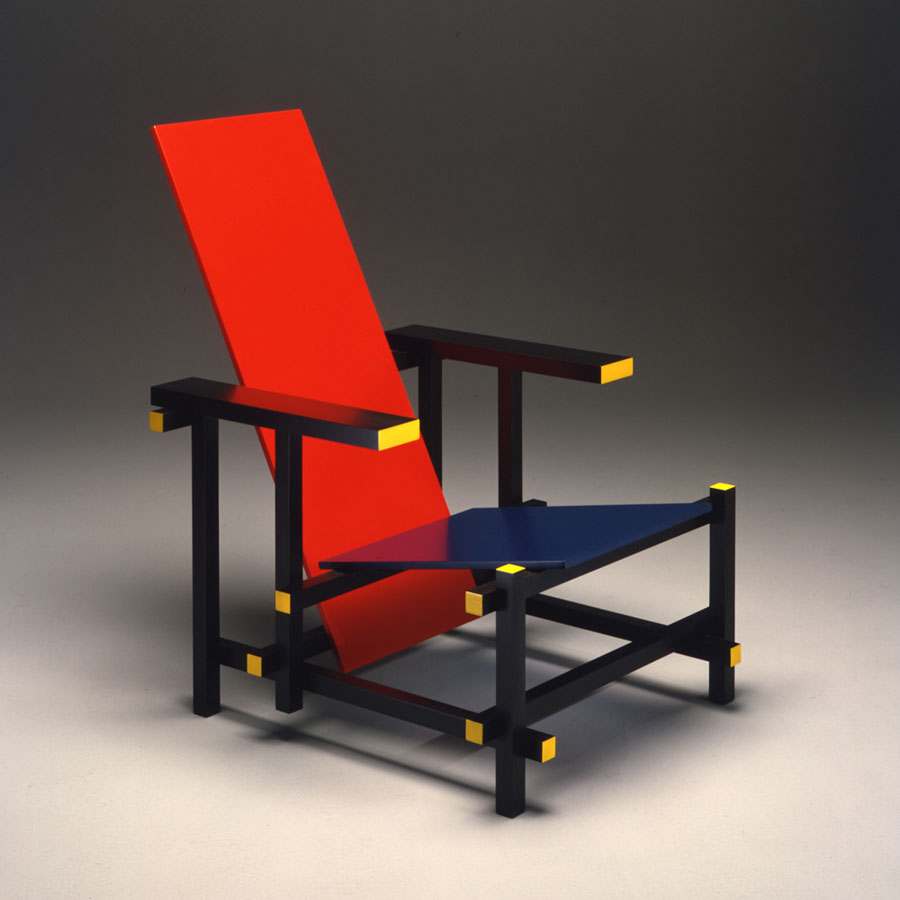
Tomas Gerrit Rietveld, Red and Blue chair, 1917. Public Domain.
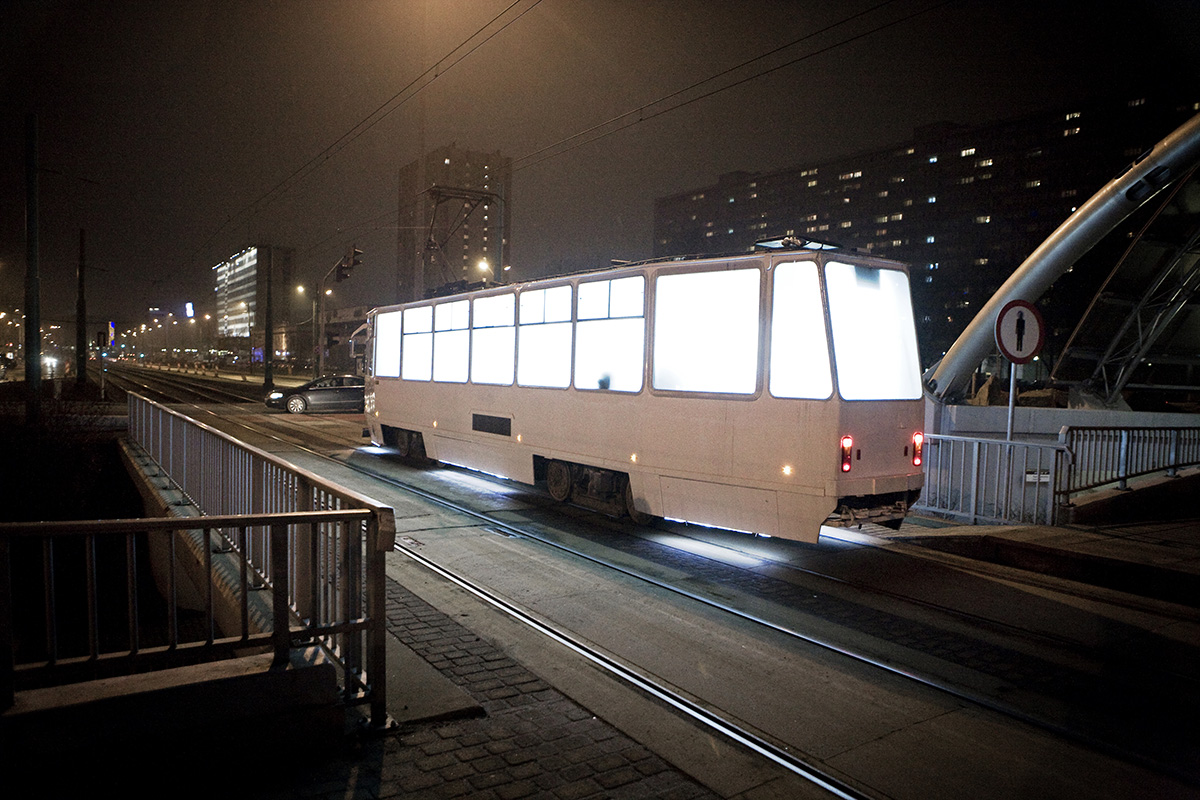
Mischa Kuball
public preposition / ghostTram
2013
Tram from Katowice and other Silesian cities operated after dark,
unpredictable route and travelling time, white foil, extra illuminants, light installation
Institution of Culture, Katowice / PL
Photo by Krzysztof Szewczyk, Katowice
© Archive Mischa Kuball, Düsseldorf / VG Bild-Kunst, Bonn 2017
Footnotes
1 Michel Seuphor, Mondrian – Peintures (Belgrade: Nolit, 1961) 10.
2 Darko Glavan. “Piet Mondrian, ‘He was a founder of Purist painting,’ ” Jutarnji list. 7 March 2015.
3 Giulio Carlo Argan, Achille Bonito Oliva, L’Arte Moderna, 1770-1979-2000: 105.
4 Herbert Read, A Concise History of Modern Painting from Cézanne to Picasso. (Yugoslavia, Belgrade, 1967) 198.
5 Read 200.
6 Read 200.
7 In addition to Mondrian, De Stijl’s leading members were Dutch painters, Theo van Doesburg and Bart van der Leck, Hungarian artist Vilmos Huszár, Belgian artist Georges Vantongerloo, architects Robert vanꞌt Hoff and Jan Wils, and Dutch author and poet Antony Kok. They were later joined by another architect, Gerrit Rietfeld. Mondrian wrote and signed the De Stijl Manifesto with these members in 1918.
8 Karl Ruhrberg, “Abstraction and Reality – Russian Revolutionaries and Dutch Iconoclasts (Suprematism, Constructivism, De Stijl),” in ed. Ruhrberg, Schneckenburger, Fricke, Honnef, Art of the 20th Century (Zagreb: Taschen, 2000) 168.
9 Argan 23.
10 transl. Ethics shown in geometric order.
11 Filiberto Menna, Modern project arts (Belgrade: Press express, 1992) 21.
12 Milica Dimitrijević (from the interview with Carel Blotkamp), “Mondrian would welcome guests in black suit,” in Politika, Belgrade: 7 January 2015.
13 Mondrian’s studio was inherited by his friend Harry Holtzman, a painter from New York. As official successor to Mondrian’s legacy, Holtzman established the Mondrian-Holtzman Trust and devoted himself to the preservation and promotion of Mondrian’s work by organising exhibitions, collecting documents, and publishing a book of Mondrian’s essays (1983).
14 Clement Greenberg in an “Obituary of Piet Mondrian, 4th March 1944, The Nation,” in Greenberg, Essays on post-war American art, 174.
15 Michel Seuphor, Mondrian – Peintures, ed. Fernand Hazan (Belgrade: Nolit, 1961) 7.
16 Argan 105
17 Hiroshi Sugimoto, Exhibition: Glass Tea House Mondrian, Biennale of Architecture, Le Stanze del Vetro, Venice, July 2015 - 30 July 2016.
18 Greenberg 30.
19 Immediately after Mondrian’s death in the spring of 1944, Holtzman opened Mondrian’s studio to the public for six months.
20 Piet Mondrian’s letters to the American artist Harry Holtzman Archive, Rijksbureau voor Kunsthistorische Documentatie/Netherlands Institute for Art History (RKD Archive) The Hague Netherland
21 Larson 15.
22 Grace Glueck, “Ilya Bolotowsky, 74, dies; a neoplasticist painter,” The New York Times: November 24, 1981.
23 François Morellet, “Lettre à Vasarely,” (1957), Mais comment taire mes commentaires (Paris: Ensba, 1999) 18.
24 Mondrian Project, 1872-1992. Organised by Aleksandar Dimitrijević, Zoran Naskovski and Nikola Pilipović, Gallery of the Cultural Centre, Pančevo, 1992.
25 Jesha Denegri, “Strategies of the Nineties: A Critic’s Standpoint,” Art at the End of the Century. Ed. Irina Subotić (Belgrade: Clio, 1998) 223.
25 Argan 108.
References
Argan, Giulio Carlo, and Achille Bonito Oliva. L’Arte Moderna 1770-1979-2000. Belgrade: Clio, 2005.
Blotkamp, Carel. Mondriaan: Destructie als kunst. Zwolle: Waanders Uitgevers, 1993.
Denegri, Jesha. “Strategies of the Nineties: A Critic’s Standpoint.” Art at the End of the Century. Ed. Irina Subotić. Belgrade: Clio, 1998.
Dimitrijević, Milica. “Mondrian would welcome guests in black suit” (from the interview with Carel Blotkamp). Politika, Belgrade: 7 January 2015.
Everdell, William R. The First Moderns: Profiles in the Origins of Twentieth-Century Thought. Chicago and London: University of Chicago Press, 1997.
Glavan, Darko. “Piet Mondrian, ‘He was a founder of Purist painting,’ ” Jutarnji list, Zagreb: 7 March 2015.
Glueck, Grace, “Ilya Bolotowsky, 74, dies; a neoplasticist painter,” The New York Times: November 24, 1981.
Greenberg, Clement. “American type painting.” Essays on post-war American art. Novi Sad: Prometej, 1997.
Larson, Philip. Burgoyne Diller: Paintings, Sculptures, Drawings. exh. cat. Minneapolis: Alker Art Center, 1971.
Menna, Filiberto. Modern project arts. Belgrade: Press express, 1992.
Read, Herbert. A Concise History of Modern Painting from Cézanne to Picasso. Yugoslavia, Belgrade, 1967.
Ruhrberg, Karl. “Abstraction and Reality – Russian Revolutionaries and Dutch Iconoclasts (Suprematism, Constructivism, De Stijl).” Ed. Ruhrberg, Schneckenburger, Fricke, Honnef. Art of the 20th Century. Zagreb: Taschen, 2000.
Morellet, François. “Lettre à Vasarely” (1957). Mais comment taire mes commentaires. Paris: Ensba, 1999.
Piet Mondrian’s letters to the American artist Harry Holtzman Archive. Rijksbureau voor Kunsthistorische Documentatie/Netherlands Institute for Art History (RKD Archive). The Hague Netherlands.
Seuphor, Michel. Mondrian – Peintures. Ed. Fernand Hazan. Belgrade: Nolit, 1961.
Essays
‘public preposition’ – déjà vu? – collecting memories!
‘public preposition’ comprises a heterogeneous group of works, interventions, projects and performances that have been realised over the course of four decades or, for various reasons, are still awaiting their final realisation. These works appeal to a public, and question—by virtue of which site and under what conditions they occur—what “public” means. How is “public” constituted? What does participation signify without reducing the term to a vague offer to “join in,” or performatively integrating the viewer into an established constellation –touching topics that include aspects and observed notions of different cultural arenas and societies?
Memory and recalling historical or autobiographical narratives are key aspects of ‘public preposition.’ The context and content are based either on collective memories or individual components of recall. ‘Remembering’ becomes important in reflecting the current conditions of our societies.
Many of these interventions and projects have come into being by the invitation of art institutions or festivals and they exist for a limited time. Now, they exist via their photographic documentation. Other projects were consciously created to be ephemeral and had a limited visibility in their in-situ manifestation. Thus ‘public preposition’ refers to a fundamental contradiction of the term “public”: on the one hand, the public experience is understood as unrestricted; on the other, the “public” of an intervention is effectively limited to an event, its viewers and its participants.
For this reason, introducing ‘public preposition’ in a publication—which includes the presentation, discussion and documentation of projects—should be seen as an attempt to create a “public.” Furthermore, the publication integrates individual projects into a larger context. The key component, ‘remembering,’ is created predominantly through oral history or a collective narrative. By virtue of this, the publication will necessarily contribute to collective memory in the public sphere.
The idea that a text addresses a public is semantically embedded in the term “publication.” Furthermore, “making public” is conceptually implicit in publishing. Because the public is a social medium, the “making available” and communication of information play a fundamental role in its establishment. Without accessibility, information would remain reserved for a limited group of people. The notion of the public sphere as fundamental to democratic theory includes processes of general interest, communication directed at an unlimited audience, and the public accessibility of spaces and places.
To present, discuss and document ‘public preposition’ through its own publication is understood as contributing to producing a public, and integrating individual projects into a larger context. It works out the “family resemblance” of the different works—similar to concepts that cannot be adequately captured within a taxonomic classification (because of ambiguous boundaries) but which still form a unified group.
‘public preposition’ is an open concept that develops and reacts to specific situations—spatial as well as social, historical and political. Depending on the situation, the approach changes. Light as an accentuating medium that creates visibility yet that is itself immaterial, often yields entry to the development of new social and communicative spaces of experience. When conceptual artist, Kuball, utilises light, he is not just illuminating and focusing on what has, until now, been hidden. Rather, he is drawing attention to what is present, and fathoming its undiscovered or forgotten potential. In the scope of ‘public preposition’ light stands for reflection in two senses: as a mirror of that which exists and an analysis of it.
For ghostTram in Katowice in 2013, Kuball converted a local transportation tool into a six-day performative intervention. Backgrounded by an unstable German-Polish history, the Upper Silesian region around Katowice is an economically-flourishing Polish metropolis today. Years of shifting borders, occupations, expulsions, settlements and evacuations had shaped its identity. The tramnetwork of Katowice and its surrounding cities, dating back to 1894, now belongs to one of the largest transit systems in the world. In cooperation with the Katowice Cultural Institute City of Gardens, a historic tram from the 1980s was illuminated and sent out on nighttime journeys without passengers, scheduled service stops, or a destination. In the darkness of the night, the “ghost train” seemed to be going nowhere. It was like a glistening white cube, set free from its original function, history and materiality. It was without background and without destination. It was without identity. People from Katowice wrote letters to the Mayor’s office reporting that their grandparents had sat in that tram; the Nazi concentration camp, Auschwitz, is nearby, and the authors of those letters connected the public intervention with their historical trauma.
Solidarity Grid in Christchurch, New Zealand was not only one of the most extensive and permanent works from ‘public preposition’ but also the work with the most complex genesis. Against the backdrop of two severe earthquakes in New Zealand, a seminal project was developed with the involvement of the local community. Blair French, the curator of SCAPE Christchurch Biennial, who had invited Kuball to create a work for the Biennale in 2013, described the various stations Solidarity Grid had to undergo, how it emerged from the on-site analysis of the situation, and his collaboration with various players. In this context, the term “site-specific” also receives another far-reaching significance. Globalisation identifies historical particularities of urban structures beyond those currently visible. Kuball pursued to question the relationship between public and private, which have become imprecise terms, and the zone between them. To say that his work consciously plays with concepts like the Agora and public space, and tests modalities for their production or reactivation, suggests that it would be hasty to dismiss these in their historicisation. The question of the status of the public, which dominates the entire work, and the relationship between the audience and the work, will also be discussed.
‘public preposition’ was published in 2015 by DISTANZ Verlag. Edited and with text by Vanessa Joan Müller

Mischa Kuball
public preposition / ghostTram
2013
Tram from Katowice and other Silesian cities operated after dark,
unpredictable route and travelling time, white foil, extra illuminants, light installation
Institution of Culture, Katowice / PL
Photo by Krzysztof Szewczyk, Katowice
© Archive Mischa Kuball, Düsseldorf / VG Bild-Kunst, Bonn 2017

Mischa Kuball
public preposition / ghostTram
2013
Tram from Katowice and other Silesian cities operated after dark,
unpredictable route and travelling time, white foil, extra illuminants, light installation
Institution of Culture, Katowice / PL
Photo: Krzysztof Szewczyk, Katowice.
© Archive Mischa Kuball, Düsseldorf / VG Bild-Kunst, Bonn 2017

Mischa Kuball
public preposition / ghostTram
2013
Tram from Katowice and other Silesian cities operated after dark,
unpredictable route and travelling time, white foil, extra illuminants, light installation
Institution of Culture, Katowice / PL
Photo by Krzysztof Szewczyk, Katowice
© Archive Mischa Kuball, Düsseldorf / VG Bild-Kunst, Bonn 2017
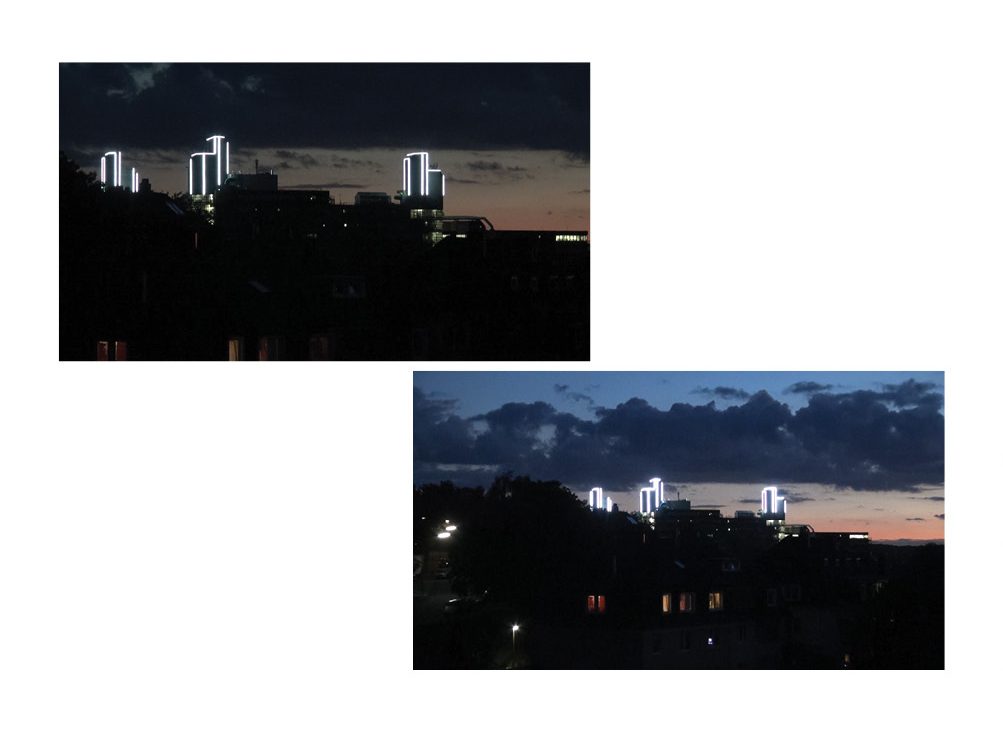
Mischa Kuball
public preposition / MetaLicht
2012
Light installation, 760 metres LED lights from the company Zumtobel,
DMX-control, 7600 Watt (10 Watt / metre), three small wind turbines type AeroviS T7 and vertical rotors
Bergische Universität, Wuppertal / DE
Photo by Eberhard Quaas, Wuppertal
© Archive Mischa Kuball, Düsseldorf / VG Bild-Kunst, Bonn 2017
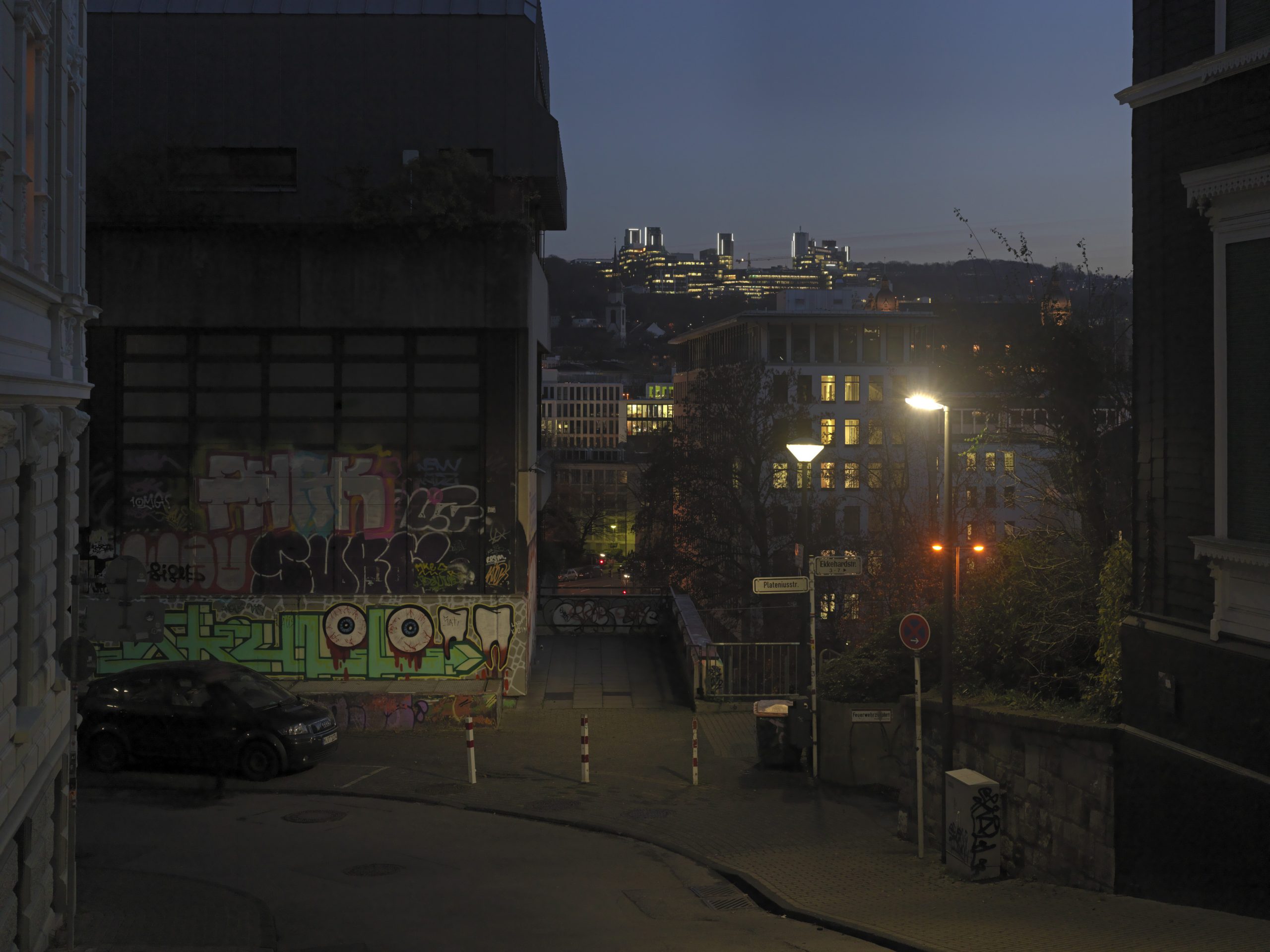
Mischa Kuball
public preposition / MetaLicht
2012
Light installation, 760 metres LED lights from the company Zumtobel,
DMX-control, 7600 Watt (10 Watt / metre), three small wind turbines type AeroviS T7 and vertical rotors
Bergische Universität, Wuppertal / DE
Photo by Achim Kukulies, Düsseldorf
© Archive Mischa Kuball, Düsseldorf / VG Bild-Kunst, Bonn 2017
Essays
Art History and the Contemporary in Southeast Asia
This essay builds its argument around the relationship between contemporary art and art history. There is a tension that underlies this relationship mainly because the modernity of art is increasingly unable to regulate the interests of the contemporary, which in turn could not seem to elude the modern as its foundational discourse.
That said, the modern art museum persists to encompass the contemporary in the belief that the modern is always emergent and self-renewing, capable of marking the progressive in the contemporary. This modernity has shaped the history of art history as a discipline forged in the 19th century and linked to the formation of the museum, the nation-state, and a particular phase of capitalism.1 The discipline of art history has experienced a crisis of its methodology and scope, and has tried to expand itself beyond its zone of expectations. This expansion, however, has failed to radically reorganise its methodology. It tries very hard and, sometimes, belabours in vain to represent other art worlds through the very procedures of explanation that have refused them. In other words, it is imperative for art history to recast itself or to cast itself elsewhere: in the afterlife of the modern that conceived it. In this endeavour of recasting, we ask: How does an emergent modality of critical inquiry conceptualise this elsewhere and in this afterlife?
In Southeast Asia, the writing of the history of art has not been strictly guided by the discipline of art history. In terms of scholarship, the history of art proceeds from the concept of comparative modernity, with modernity as the main mode of explaining art and its vehicle for comparison across diverse art worlds. It is also through this concept of modernity that a range of differences plays out: non-modernity, anti-modernity, post-modernity, tradition, contemporary, and so on. The other mode is the ethnographic that tells stories of artists and the ecologies in which they work. It serves as an alternative to a strict art history, in light of the absence of a deep archive of art. The third mode is the contemporary in which the history of art is, at a certain level, narrated and reflected upon through the production of art in the present; a present that reflexively implicates the conditions under which art has been historicised.
This excursus looks at four instances in Southeast Asian art that foregrounds the contemporary as a mode of access to art history. These instances offer up four themes about the relationship between art history and the contemporary as well as speak to the concerns of this problematic dynamic, namely: the supposedly paradoxical liaison between past and future. The rubric of art history and the contemporary at a significant level indices this constant “déjà vu”— a recurrent condition that actually exemplifies the comparative, in which the progressive is arrested by the antecedent; or the vision of a possibility is bedevilled by an anxiety of history. What might be productive to contemplate is how theory puts in place the terms “end” and “post” in the exceptional markers of the self-consciousness: the modern, the colonial, and the historical.
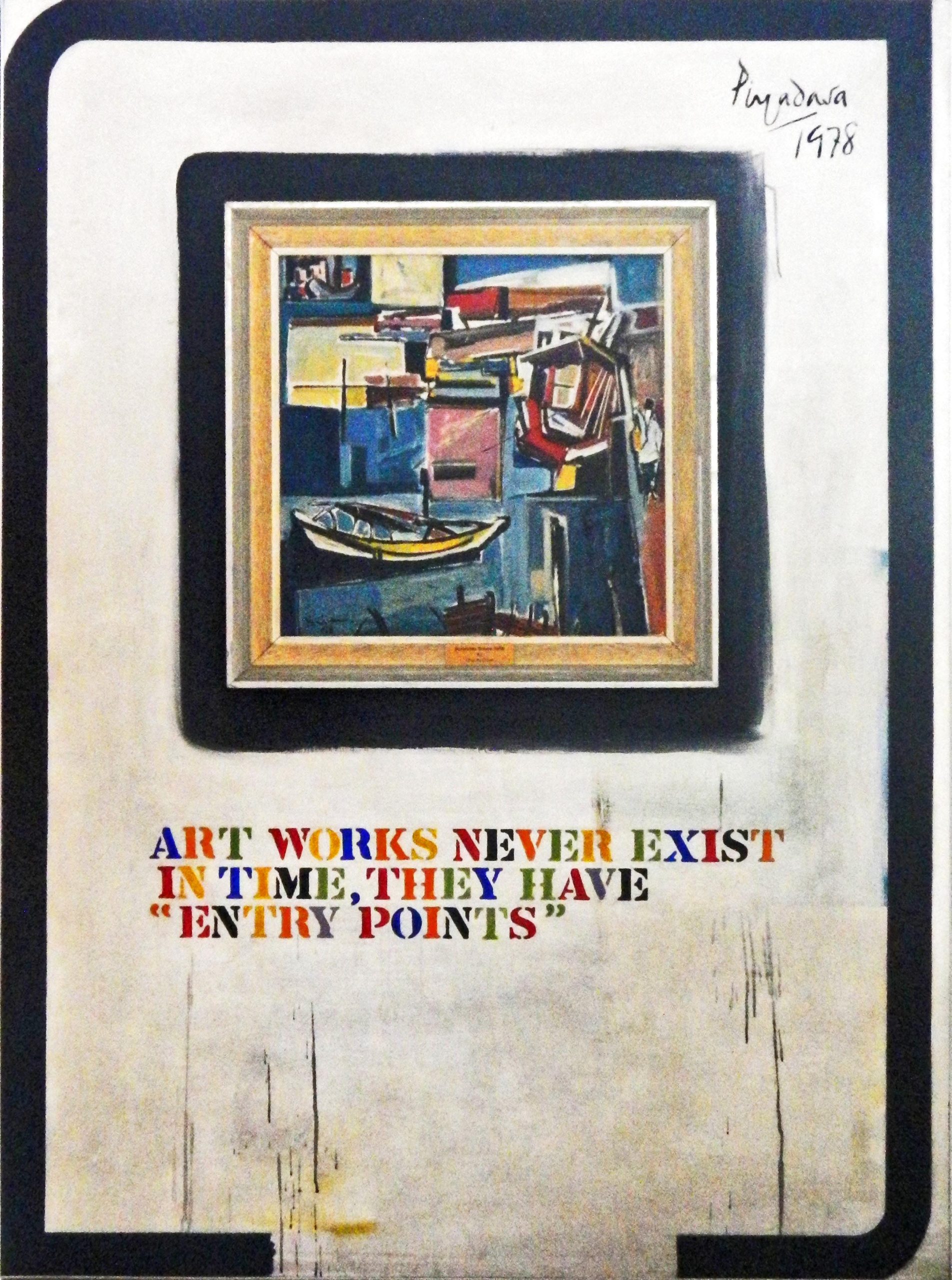
Redza Piyadasa,
Entry Points, 1978.
Mixed media.152 x 112 cm.
Collection of National Art Gallery Malaysia.

Redza Piyadasa,
The Great Malaysian Landscape, 1972.
Acrylic and mixed media. 152.5 x 106 cm.
Collection of National Art Gallery Malaysia.
Thesis 1: The contemporary locates trajectories.
“Art works never exist in time, they have ‘entry points.’” This quote is taken from Redza Piyadasa’s mixed-media work titled Entry Points (1978). It assimilates a 1958 painting by Chia Yu Chian titled River Scene into an otherwise bare canvas, stained only by trickles of paint, a broken border, and the stenciled sentence that disfigures the scene of the painting. Piyadasa’s comment tracks the modernity of art in terms of trajectories, not origins; transpositions, not lineage nor linearity. The idea that the work of art is approached through “entry points,” as opposed to having a fixed temporal existence, significantly skews the history of modernity. In particular, its self-fulfilling prophecy of progress may actually be a chronicle of a stasis foretold. Interestingly, the presence of the artist and the painting references the Nanyang School/Style.2 Chia Yu Chian was studying in Singapore at the time the work was painted, and this may have been Piyadasa’s way of calling out an entry point into a modernity in Southeast Asia that is being consolidated as a region—through a school of artistic and cultural thought—under the aegis of the Nanyang or the South Seas.
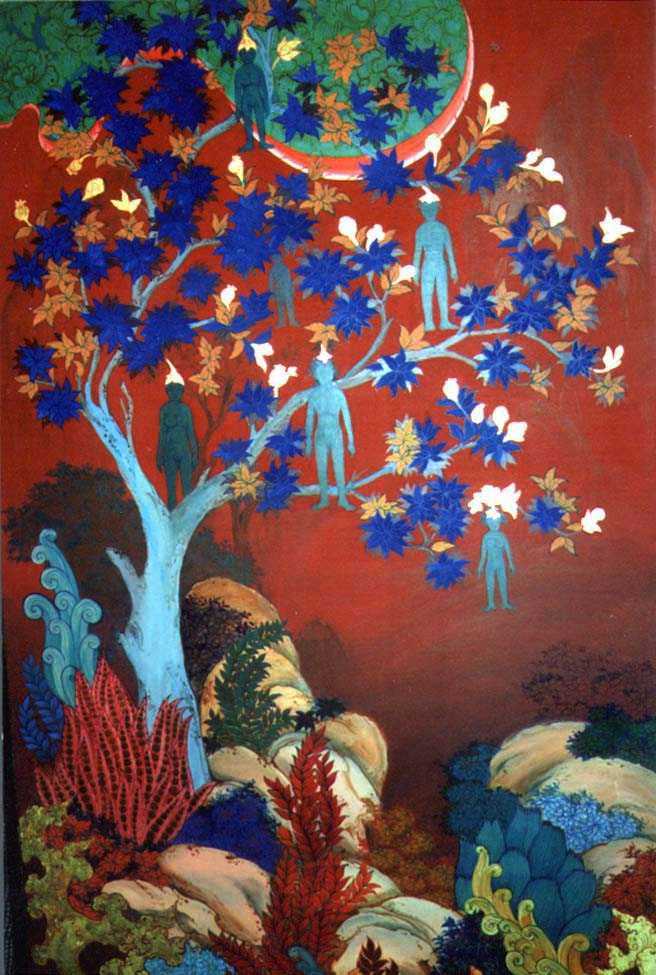
Phaptawan Suwannakudt,
Nariphon I, 1996.
Detail (image with the tree).
Acrylic and gold leaf on silk. 165 x 80 cm.
Courtesy of the Artist.
One such trajectory is the critique of art itself within the practice of artmaking, rendering the “critical” formative of the “artistic” at the fringes of autonomy. As a conceptual artist in the minimalist, kinetic, and constructivist vein, who questioned the basis of modern art and later the discourse of nation in Malaysia, Piyadasa first tried to reconceive the form of art, in his own words, as a “meta-language” within the purview of a Western avant garde. According to him: “My arrival at conceptual art engagements by the mid-1970s was prompted by the need to transcend the limitations of a painting/sculpture dichotomy as defined by Western art historicism. The attempts to break down separations between painting and sculpture were central preoccupations of the 1960s, very much a part of my generation’s concerns.”3 In this specific instance, contemporary art opens up a new way of imagining how art takes place, and is not merely mapped out across or grafted onto a grid called Art History. Here, the contemporary creates the conditions of the historical in relation to the passage of art.
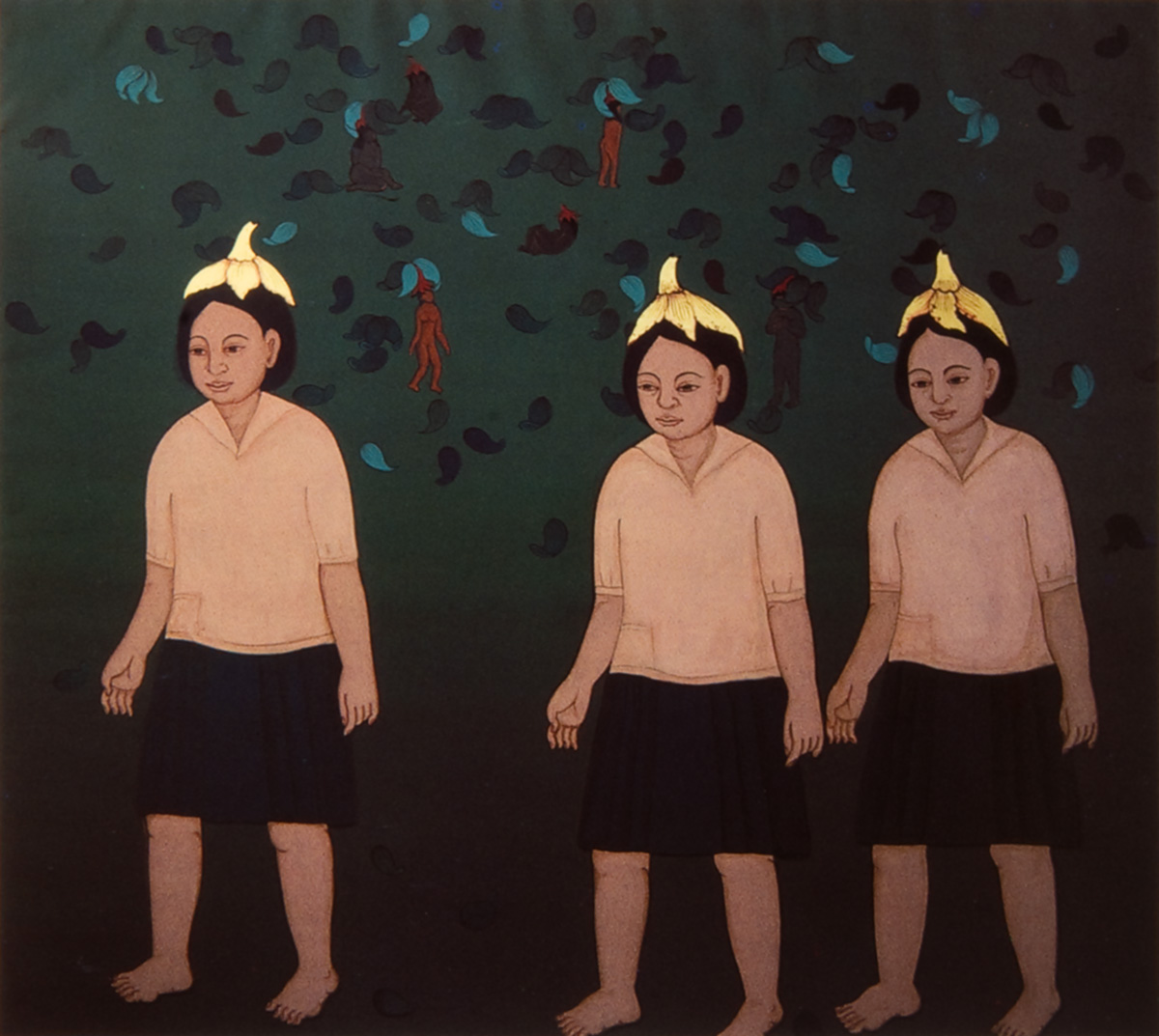
Phaptawan Suwannakudt,
Nariphon III a, 1996.
Detail (image with three girls on the left).
Acrylic and gold leaf on silk. 90 x 90 cm.
Courtesy of the Artist.
According to Piyadasa’s account of the history of modern Malaysian art, in his earlier work The Great Malaysian Landscape (1972), “a conscious attempt has been made to focus on what has been termed the ‘eye/mind’ conflict in modern painting by the use of visual and verbal components.” This reflexivity lies in “a parody of the painting-within-a-painting situation…in which the stenciled words draw attention to…rhetoric governing…modern painting…. (and) questions about the nature of painting.”4 Here, the contemporary artist is also an art historian, and so conflating the tasks of production and historicisation that are performed, impressively, by the same person.
Thesis 2: The contemporary reinvests tradition.
There is the impression that the contemporary is the opposite of tradition, and that tradition needs to be transcended so that change can happen. Contemporary art has complicated this notion. The artist Phaptawan Suwannakudt from Thailand exemplifies the condition in which the contemporary cannot be rendered possible without the skill honed in the context of tradition. Tradition may mean the supposed knowledge generated before the time of the modern. What the contemporary tries to do is to cross the unnecessary gap between modernity and tradition. Phaptawan is the daughter of the esteemed Thai mural painter Paiboon Suwannakudt, and learned the techniques of mural painting under his guidance. When Paiboon died in 1982, Phaptawan, who spent her childhood in a Buddhist temple, assumed the role of her father and completed commissions for temples and hotels in Thailand for 15 years. Phaptawan’s practice has been a conversation between this history of skill and talent, on the one hand, and the demands of the present on subjectivity and agency, on the other. At this point, the question of gender and locality intersects with the conditions of migration. When Phaptawan moved to Australia in 1996, she described herself as a “Thai mural painter”5 but began painting on easels instead of the wall. Her work over the years, however, has revealed an array of expressions that enhance while simultaneously lightening the burden of this characterisation of the self. In many of her pieces, she is able to reflect on displacement and resettlement, and references modernism and customary forms of image making. For instance, her first paintings in Australia titled the Nariphon series (1996), feature gum tree figures in the scene. She relates that she “unconsciously painted a gum tree bearing its girl-shaped fruits to tell a story of an incident in a province of Thailand when a 12-year old girl was sold by her parents.” In a later work titled Journey of an Elephant (2007), she paints the trees she encountered in Sydney, names them in a language she knew intimately, and layers them with the text of a short story her father had written. This layering of worlds, texts and visions is also evident in Three Worlds (2009).
The art critic Flaudette Datuin points out that it was Phaptawan’s father “who taught her to discipline her hand through a mindfulness honed by meditation and guided by the Buddhist conviction that the ‘mind is the body and the physical is a vessel,’ from which we depart when we die. Form in Buddhist painting, she believes, is likewise a ‘vessel, in which the mind of the painter dwells. The mind dwells on the work during the process of painting, and when it departs, I leave the vessel behind. My work moves on from one vessel to another.’”6 Datuin further states: “when she was 14, for example, she asked her father why the line and form of water in his mural paintings did not look like the water she sees in a nearby river. Her father sent her back to look at the river again but this time with her eyes shut. ‘He then told me to empty the visual from eyes of flesh and see again.’ When she begged her father to teach her how to paint, he asked her to draw leaf after leaf, thousands of leaves, page after page. When she started painting murals herself, she did so with a watchful mind that observes the moment and movement of the brush/pencil entering and departing the surface. And every time she ‘arrives at the departure,’ she ‘catches the moment of the unattached mind. The watching of the mind will carry you through several enterings and departures [over] and over again.’”7
Thesis 3: The contemporary redistributes the modern.
An important element in the climate of contemporary art is the market. It is an issue that is, more often than not, repressed in the discussion of the aesthetic or isolated as a sociological matter, as if the production of art were not either a critique or affirmation of the capital that has produced it in the first place. The couple, Alfredo and Isabel Aquilizan, confronts the market by way of art history. The artists converse with the art of Antonio Calma, someone who bears the stigma of being labelled a Mabini artist, a term assigned to painters who are deemed commercial. The term comes from the street on which they ply their trade, the same vicinity in which some conservative painters in 1955 relocated their works, after walking out of a competition in the annual salon that, according to them, favoured modernism. Mabini, therefore, serves as a sign of decline and persistence, an enduring salon des refusés that is contemporaneous with modernity. Calma is the Aquilizans’ contemporary in the art world; but he only makes sense in Mabini while the Aquilizans are supposedly global artists in biennales and art fairs.
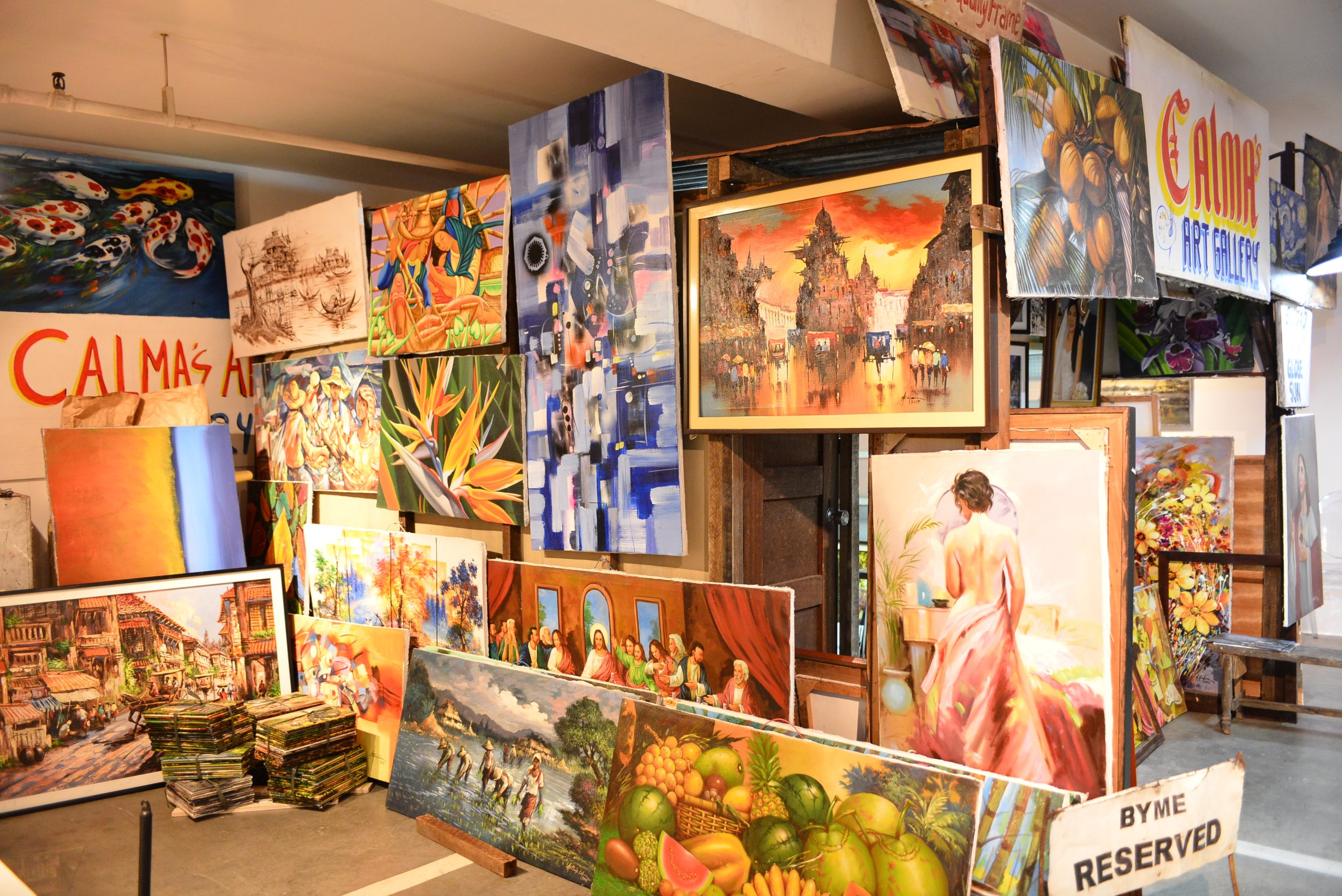
Isabel and Alfredo Aquilizan,
FRAMED: Mabini Art Project at Art Fair Philippines, 2016.
Installation view. Courtesy of Alfredo Jojo Gloria and Art Fair Philippines.
In the hands of the Aquilizan couple, the works of Calma are subjected to different configurations: stacked into a column or a pile of canvasses, cut up and reframed, recast as minimal sculpture or readymade conceptual art that is totemic or muralist in aspiration, but still retaining the signature of a fragmented, miniaturised Calma. He has become some kind of a co-author, or cooperator, of contemporary art that has mutated into abstract, impressionist, informel, brut, nouveau realist, and so on. What happens to Calma is difficult to track, which is why this provocation is indispensable—it is at once so disturbing and so beautiful, with Mabini art finally becoming contemporary and museum-worthy, though slaughtered, so to speak. It is only through this slaughter that it achieves an aesthetic quality meaningful in the legitimate art world, but it is a slaughter that nevertheless denies it its own tradition on the street where it lives. This process of transformation of Mabini painting from commercial painting into an installation began in 2007. In a way, contemporary art reverts to a history of kitsch to achieve its valence of modernity.
In Art Fair Philippines in 2015, a reprise of this project was staged. A documentary was exhibited alongside a motley of pictures. In this theatre, Antonio Calma sat comfortably for the camera, posed against the fabled and majestic Mount Arayat, the mountain that presides over his place. Calma was actually ensconced. After all, this is his social world, his art world. He is a painter of landscapes, including the one that frames him. It is one that he sells quite copiously in his trade. He is what they would have called, back in the day, oftentimes with condescension if not outright derision, a Mabini artist; in our own time, he persists to stand his ground with his own gallery in Pampanga and Tarlac—a nest feathered by an atelier of artists and a cohort of loyal clients.
For the Aquilizans, the discourse around Mabini is a viable site from which to think about the circulation of art and the creation of its value: from the origins of the market during the reign of Fernando Amorsolo in the first half of the 20th century to present day scenarios in which primary and secondary markets briskly interact (sometimes vertiginously brisk). Mabini references a lot of logics vital to the commerce of art. It also implicates the afterlife of 19th century academic realism as a foundation of tourist and souvenir art in the American period when the Philippine exotic would be accessed partly through paintings of tropical charm and colonial curiosity. It relocates Amorsolo, the most well known Philippine painter in the first half of the 20th century, from a revered master of romantic realism, who is seemingly beyond the machinations of money, to a purveyor of taste and things in a wider economy of both kitsch and collectible. Finally, it complicates the notion of the contemporary itself. How do artists like the Aquilizans appropriate the lively practice and ecology of Calma in the context of contemporary art? Can Calma survive the translation or is it only the Aquilizans who gain from this contentious gesture? Both Calma and the Aquilizans have been recognised because of this project: exhibition presence for the latter and business prospects for the former. Can there be reciprocal mimicry here?
These questions are not masked in the art fair. Rather, they are laid bare, better for the public of the art fair to keenly revisit questions of value and the social life of commodities. In previous collaborations with Calma, the Aquilizans had radically intervened to make Calma’s oeuvre look like much more than it is in Mabini and its satellite retail outlets. In this fair, the Aquilizans decided to pursue another trajectory. They practically transplanted the gallery of Calma from its home grounds to the premises of the fair, and set it up as a gallery like any other display at the event. Iterations of the corpus of Calma, as at the Fair, has been significantly mediated by the Aquilizans and by this, the discipline of art history encroaches to historicise it. This cohabitation is meant to confuse, to productively confuse, so that the idea of the market and its political economy are viewed from a broader vantage, and that the modernism of art does not elude the critique usually reserved for commercial interests enslaved by lucre. An argument can be made that it is commerce all over, just like the salon hang of the works in both the galleries of Calma and the Aquilizans. And if it is so, is there nothing outside it? Does inserting Calma into the art fair circuit merely indulge the market, or does it finally disabuse it?
Thesis 4: The contemporary masters and mimics the Western gesture.
The work of the artist Mahendra Yasa, who works in Bali, exemplifies this final thesis. In contemplating contemporary form, he is seemingly bedevilled by a double vision: the vision of Balinese painting that has defined the idyllic conception of Bali and the vision of Western art, specifically American modern art, in an effort to overcome the dichotomy sustaining those binary visions. What he does is to transpose the techniques of Balinese painting to simulate the effect of so-called Western modernism. The effect is mimicry of the Western and mastery of the Balinese, an overinvestment in the production of surface almost on the level of obsession and devotion related to craft and ornament. It also references the viable commerce of painting in Bali that simulates Western style and exploits the local expression.
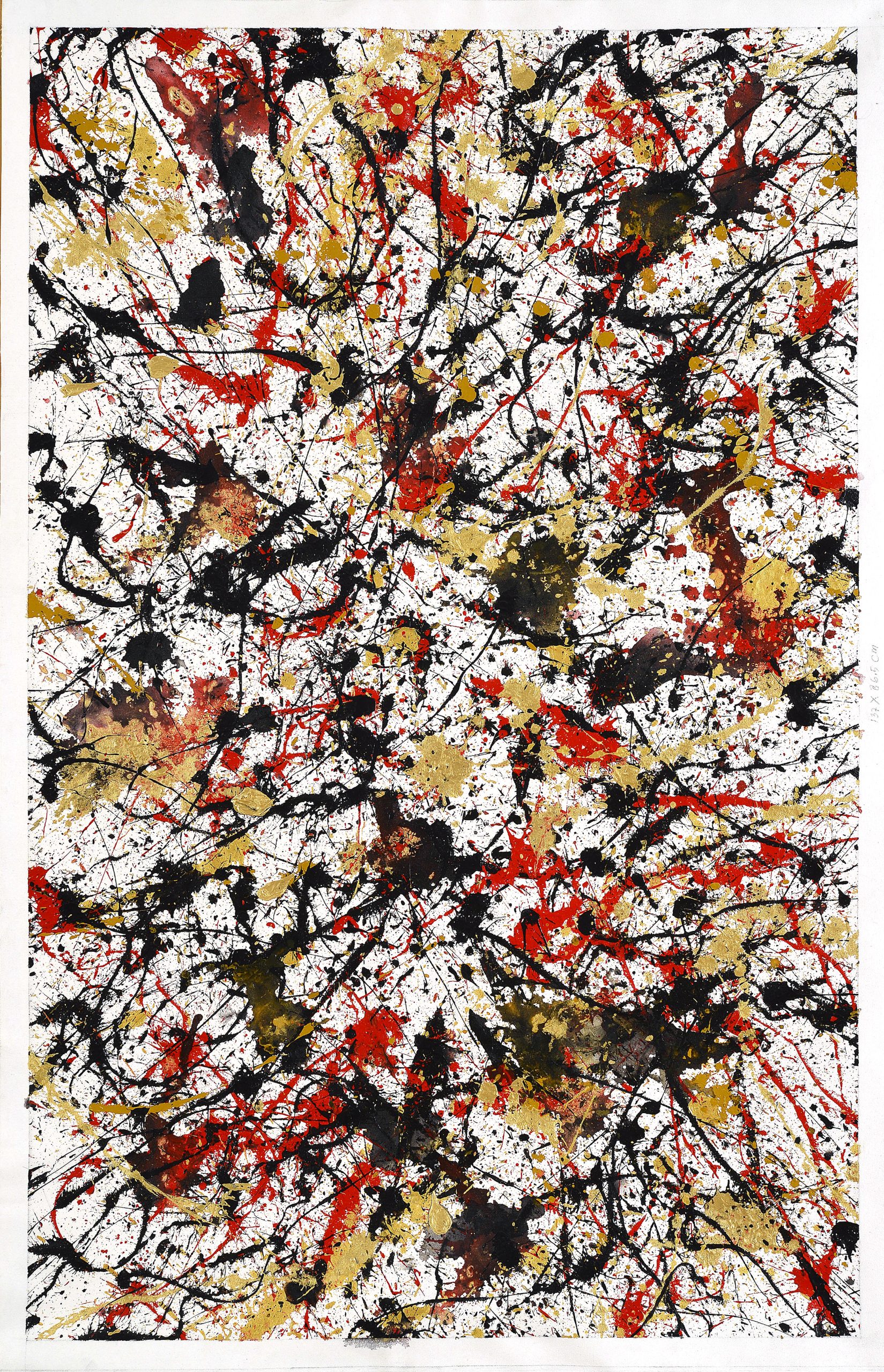
Gede Mahendra Yasa,
Rorschach #1A, 2013.
Acrylic on canvas. 86.5 x 137 cm.
Courtesy of the Artist.
The critic Enin Supriyanto, who describes this disposition as “post Bali,” argues that what Mahendra Yasa seems to ask is this: “What is the meaning of painting today. If all the techniques, materials, styles, as well as iconographies…can be very easily reinstated on a canvas though realism and appropriation without requiring thought processes or subjective aesthetic considerations.”8 In one series, Mahendra surveys the masterpieces of Western art history in the Balinese Pita Maha style of painting which is mobilised to portray landscape. In his Jackson Pollock series in 2011, the abstract expressionism effect is faithfully depicted but in a mode so graphic it negates the gestural impulse of the style; the same is true of his Robert Ryman series in 2008, in which he represents whiteness photorealistically through lower contrast and careful chiaroscuro, not conceptually as object. In the face of this painstaking and elaborate project, we cannot help but wonder about the necessity of labour, and have mixed feelings of sadness and the sublime. Moreover, the aptitude and the diligence reinscribes Balinese as part of contemporary art through the appropriation of the traditional technique and the modernist object of Pollock’s drip or Ryman’s colour: the techniques of depicting flora and landscape transfigure the modernist fixation on the signature gesture and the facture of the inventive object. Alternating in this scheme are repetition and overinvestment, imitation and originality, trace and rigour, tourist art and contemporary art, the found image and the critical image.
In all these forays by Southeast Asian artists, the reflection on art history becomes a reflection on landscape, the evocation of place, its idealisation and corruption in certain discourses of distinction such as: nation, region, spirituality, gender, belongingness to an abode, and its role as refuge in the diaspora. This demystification of landscape ultimately translates into a sense of locality, something that hints at a possibility: that the spectre, or the unconscious, of the contemporary is the local that in turn significantly shapes the history of modernity and continues to haunt the present with the contingency of place, the entry points of modernity, and the histories of art in Southeast Asia.
This paper was developed from a presentation at the Museum of Contemporary Art Tokyo 20th Anniversary Public Symposium titled “To Unravel Our Readings of History,” held at the Museum of Contemporary Art Tokyo, November 1, 2014.
Footnotes
1 Elizabeth Mansfield, Art History and Its Institutions: Foundations of a Discipline. n.p. (London: Routledge, 2002) 1-27.
2 In footnote 4 from Seng Yu Jin’s essay, Lim Hak Tai Points a Third Way: Towards a Socially Engaged Art by the Nanyang Artists, 1950s-1960s: There have been competing, and at times confusing, terms used to describe this group of artists (and their artworks) as “Nanyang artists,” “Nanyang School,” “Nanyang art,” “Nanyang movement” and “Nanyang style.” There are nuanced differences in each of these terms. “Nanyang School” implies a loose grouping of artists associated with a particular institution, such as an art academy or society, with a shared stylistic and aesthetic direction discernable in their artworks. “Nanyang movement” is broader than the “Nanyang School” as it suggests a stylistic movement and common aesthetic evident in a group of artists. “Nanyang style” is a much narrower definition based on a specific set of formal qualities that are common in the practices of a group of artists.
3 T.K. Sabapathy, Piyadasa: The Malaysian Series (Kuala Lumpur: Galeri Petronas, 2007) 15.
4 Redza Piyadasa, “The Treatment of the Local Landscape in Modern Malaysian Art, 1930-1931,” Imagining Identities: Narratives in Malaysian Art. Volume 1, eds. Nur Hanim Kairuddin and Beverly Yong (RogueArt: Kuala Lumpur, 2012) 42-43.
5 Suwannakudt, phaptawansuwannakudt.com.
6 Flaudette May Datuin, “The Grid and Nomadic Line in the Art of Phaptawan Suwannakudt,” Contemporary Aesthetics, vol. 3, 2011.
7 Ibid.
8 Enin Supriyanto, “Post Bali,” Post Bali, (Jakarta: Roh Projects, 2014) 4.
References
Datuin, Flaudette May. “The Grid and Nomadic Line in the Art of Phaptawan Suwannakudt.” Contemporary Aesthetics. Vol. 3, 2011. Web.
Mansfield, Elizabeth. Art History and Its Institutions: Foundations of a Discipline. n.p., London: Routledge, 2002. Print.
Piyadasa, Redza. “The Treatment of the Local Landscape in Modern Malaysian Art, 1930-1931.” Imagining Identities: Narratives in Malaysian Art. Volume 1. Eds. Nur Hanim Kairuddin and Beverly Yong. RogueArt: Kuala Lumpur, 2012. Print.
Sabapathy, T.K. Piyadasa: The Malaysian Series. Kuala Lumpur: Galeri Petronas, 2007. Print.
Seng Yu Jin, “Lim Hak Tai Points a Third Way: Towards a Socially Engaged Art by the Nanyang Artists, 1950s-1960s.” Charting Thoughts: Essays on Art in Southeast Asia. Singapore: National Gallery Singapore, 2017. Print.
Supriyanto, Enin. “Post Bali,” Post Bali. Jakarta: Roh Projects, 2014. Print.
Suwannakudt, Phaptawan. phaptawansuwannakudt.com. Web.
Essays
Souvenirs from the Past that Never Was
Souvenirs from the Past that Never Was1
As a phenomenon that implicates memory and perception, warping our sense of space and time in the process, déjà vu – no matter how many times we have experienced it – leaves us puzzled every time. Imagine being in a certain place, taking in the setting and the objects within it, on one hand certain that we have been there previously but, on the other, our instincts signal that we are experiencing this scene for the first time: “I have been in this room before; the table of books with the lamp and the vase are so familiar to me… yet I cannot place when exactly I saw them last.” Our perception insists that there is something that we are trying to recall here, yet our memory tells us that there is nothing in the past that corresponds to what we are seeing in the present. It is this disconnection between perception and memory felt in déja vu that evokes a sense of strangeness and, within that fleeting moment, it is not uncommon that we begin questioning the accuracy of what we perceive and what (we think) we remember.
For the Italian philosopher Paul Virno, the experience of déjà vu, as described above, points to one of its distinct characteristics regarding the nature of the past it implicates. Compare déjà vu, for instance, with remembering the birth date of a loved one: while that date may be recalled with confidence, the time that we try to recollect in déjà vu is ultimately less certain. Thus for Virno, déjà vu is concerned not with the recollection of a “dateable, defined” past that unquestionably occurred in a specific location at a given point in time, but rather a sort of “past in general” that may not have happened at all.2 Characteristic of déjà vu, unlike the memory of past birthday celebrations that is anchored to a specific moment that has gone by, is that it conjures a kind of non-chronological past, a past without a definite position in time. As such, déjà vu is a unique mode of experiencing time.
Another characteristic of déjà vu, as observed by different writers from an Oxford English Dictionary entry of the term,3 points to the sense of familiarity that the experience evokes: the definition of déjà vu states it to be “the correct impression that something has been previously experienced; tedious familiarity…”4 In his book on déjà vu, Peter Krapp notes that such a characteristic of déjà vu is also present in Walter Benjamin’s interpretation on kitsch, a subject that began to be a point of academic reflection by the early 20th century against the backdrop of rampant mass industrialisation and the increasing commodification of art. For Benjamin, the appeal of kitsch – typically mass-produced knick-knacks that decorate the corners of the domestic home – lies in its familiarity. Kitsch objects produce the effect that “this same room and place and this moment and location of the sun must have occurred once before in one’s life,”5 and this sensation matters more than whether or not that past moment had actually occurred. In Benjamin’s account, kitsch makes apparent the familiarity that characterises déjà vu.
In this essay, building from the temporal characteristics of déjà vu as identified by Virno as well as the link between déjà vu, familiarity and kitsch drawn by Benjamin, I wish to extend the discussion by focusing solely on the kitsch objects of souvenirs. While souvenirs typically function as a marker of memory – an “I♠NY” t-shirt as a keepsake from a trip to New York City, for example – I draw attention instead to souvenirs of unvisited places – for instance, a Merlion fridge magnet that may have been bought in Batam without one having been to Singapore at all. While souvenir studies typically focus on its role in embodying the memory of firsthand, lived experiences, I try instead to position the souvenir in terms of the experience of déjà vu as theorised by Virno and Benjamin. To do this, I will refer to an exhibition I co-curated for Singapore Art Week 2016, entitled Fantasy Islands, paying particular attention to its exploration on the issues that surround souvenirs.
I propose that the familiarity evoked by the souvenir is symptomatic of a particular process of staging a national narrative: it is by facilitating an imagination about a place that souvenirs familiarise it. Here, I extend Susan Stewart’s theorisation on the ‘longing’ that souvenirs implicate, by asserting that the souvenirs discussed in this essay present a particular longing for familiarity within the necessarily alienating and foreign dynamics of global tourism. However, in contrast to Stewart’s perspective that longing is a pathological state linked to nostalgia, I see longing as a productive force in its capacity to reveal what Virno refers to as a “potential now.” I conclude by offering the view that souvenirs from places that were never visited make the distinction between nostalgia and déjà vu evident. This essay proposes a way of interpreting souvenirs beyond its usual preoccupation with nostalgia by analysing it according to the framework of déjà vu, thereby emphasising dimensions of the souvenir that are not necessarily tied to the memory of the places that the souvenirs are meant to represent.
“A Past in General” and the “Potential Now”
Discussion about the strangeness of déja vu often revolves around Freud’s theorisation of the phenomenon.6 Like the phenomena of chance encounters and the double, Freud’s déja vu brings us into the realm of the uncanny, where the familiar and the unfamiliar lose their distinction and are seen to be symptomatic of a pathological “compulsion to repeat,” aimed at fulfilling repressed desires. Yet a theoretical framework that pathologises déja vu may not, in fact, prove helpful for the purpose of teasing out what déja vu reveals about concepts that are related to our understanding of time. For instance, it neglects questions regarding the nature of a past that is conjured by déja vu, what it reveals about our constructs of memory, and how this influences our conceptions of history.
For Benjamin, such an experiencing of time – seemingly problematic due to its inherent obscurity – nonetheless plays an important role in the way we understand the workings of history. His interpretation of déjà vu explains to us the relationship between past, present and future that is operative there. In déjà vu, we are transported “unexpectedly” to the past, and while the sensation “affects us like an echo,” “the shock with which a moment enters our consciousness as if already lived through tends to strike us in the form of a sound” occurs simultaneously.7 While this may remind us of Proust’s description of involuntary memory, Peter Szondi and Peter Krapp argue that unlike Proust, whose search for lost time propels him deeper and deeper into the past, Benjamin seeks a connection between the past and the future: whereas Proust preserves the past as impenetrable and inaccessible, Benjamin sees the past as something that unfolds into the future.8 Even though the memory that emerges from déjà vu may be false, it is nonetheless important to consider what kind of future that such a reliving of the past opens toward: “if I have been in this situation, I might know what will happen next; there might be a clue left for me of what is yet to come.”9
This line of argument that gives a specific position to déjà vu in the historical experience – which is conventionally centred on the dynamics of remembrance and forgetting – is pushed further by Virno. He argues, somewhat controversially, that not only is déjà vu not a mere lapse in either memory or perception, it is in fact the very condition for historical possibility. Here, Virno’s argument goes beyond two dominant understandings of history: firstly, that history is an endless quest to put together pieces of the past in the present in order to preempt a vision of the future and secondly, the Nietzschean tradition that sees an active forgetting as necessary for history, because one needs to learn to forget (i.e. be unburdened by the past) in order to move forward. Both, according to Virno, rests on the assumption that any knowledge of the past serves to affirm the now that we are living through. This leads to a danger in the way history is understood, which Virno refers to as “modernariat”, where the endless fragments of the past are gathered solely to affirm and validate what happens in the now.10
According to Virno, what déjà vu reveals is the dual-dimensionality of the now: the “actual now” and the “potential now,” that are being remembered as it is being perceived. As Hiyashi Fujita notes, this conception of déjà vu as both memory and perception is already theorised by Henri Bergson, for whom “the cause of déjà vu is perceiving a certain scene at the same time as recollecting the memory that is currently being perceived.”11 In déjà vu, memory and perception – which in any other experience would remain distinct from one another – becomes entwined; we can no longer maintain that perception is a property of the present moment and memory as that of the past. This two-fold nature of the now that is exposed in déjà vu opens an alternative version of how history may be construed: “learning to experience the memory of the present means to attain the possibility of a fully historical experience.”12
The past conjured by déjà vu may seem false and illusory – and thus easily overlooked – but Virno’s study is instructive in terms of situating its position within a larger consideration of the historical experience.13 Drawing from Bergson, Virno explains that déjà vu summons not a “dateable, defined,” particular past, but a “past in general”, highlighting that, in déjà vu, what matters “is not this or that former present” but rather “a past that has no date and can have none.”14 As déja vu evokes, in the present, a “past that was never actual”, it thus underscores a “potential now” that must not be overlooked in the experience of history.
A Longing for Familiarity
For Susan Stewart, longing is a manifestation of nostalgia, a phenomenon that brings an idealised past into the present and makes it seem more real. In her book, Stewart explains that physically, different forms of longing come to be manifested in the objects of the “miniature, the gigantic, the souvenir and the collection,” and that it is the souvenir, in particular, that signifies the “longing of the place of origin” where the “authentic” – whether experience or object – is encountered.15 As a narrative-generating device, the souvenir creates myths of authenticity: this is no more apparent in an increasingly mediated world where the body no longer becomes the primary mode of perception, and where claims for authenticity are inevitably linked to the articulation of “fictive domains” such as the “antique, the pastoral, the exotic.”16
Focusing solely on the function of the souvenir in embodying the memory of past experiences, for Stewart, the souvenir serves to “authenticate the experience of the viewer.”17 The souvenir, as neither an object of “need or use value,” speaks through a “language of longing” to represent events that are deemed “reportable.”18 Interestingly, Stewart continues to explain the “incompleteness” of the souvenir: first, by being an object that represents an event or experience (e.g. a Big Ben pencil case as a souvenir from a visit to London), and second, it must remain incomplete to allow the supplementation of a “narrative discourse.”19 Specifically, the souvenir generates a narrative of the originary place of the authentic experience, thus simultaneously signifying a nostalgic longing to return to that place and authenticate the memory of having been to that place in the past.
In Stewart’s theory, ‘longing’ is symptomatic of the “social disease of nostalgia,”20 where the present experience of the souvenir is marked by an impossible desire to return to the time where the place symbolised by the souvenir was visited; putting it differently, the “actual now” is characterised by the futile yearning for a “dateable, defined” past. However, in the case of déjà vu, such a past, as the above discussion on Virno’s theory explains, is non-existent: we have never been to that place previously. While Stewart is certainly helpful in explaining the sense of longing that the souvenir embodies, could this longing be felt even in the absence of such firsthand experiences, in the case of souvenirs of places that were never visited? In Virno’s terms, such souvenirs uncover a “potential now” that refer to a “past that was never actual,” in other words: to déjà vu rather than to memory. The question that then needs to be posed is: how does longing operate in déjà vu, in the absence of a past place that may be relived in its memory? If the souvenir is tied to the time of déjà vu rather than memory, then what kind of longing does it manifest – what does it long for?
Early 20th century theorists of mass culture define kitsch against the backdrop of rampant industrialisation and the resulting rise of a mass culture of consumption. A “genuine culture” that takes time to fully mature is replaced by an artificial culture that, belonging to an elite few, developed rapidly and whose reach encompasses the many. Kitsch – quick to produce and reproduce, formulaic, and imitative – embodied this new artificial culture that is perceived as “a debased form of high culture.” Benjamin’s theorisation of kitsch, similar to other thinkers from the period, is shaped by such an intellectual backdrop and is unique in its mention of kitsch’s familiar appeal. On one hand, kitsch objects embody modernity in being mass-produced. On the other hand, rather than being treated as a modern shock of the new, kitsch is similar to folk art in being known, prosaic and mundane: the lure of kitsch is “like the feeling of wrapping oneself into an old coat.”21 Krapp notes further that for Benjamin, kitsch is able to return us to this familiar space-time – regardless of whether such a space-time ever existed at all – because déjà vu does not simply entail a “rational repetition and recognition, but rather a different experience of space-time.”22 In other words, the warped space-time that déjà vu generates allows us to hark back to a space-time of familiarity, in spite of its illusory, non-actual nature.
In the absence of an “authentic,” “lived,” firsthand experience of a place – as in the case of déjà vu – the souvenir then cannot be seen to stand for a longing to return to that place. Yet despite such absence, déjà vu retains a sense of familiarity, and it is a longing towards it that the souvenir thus points to. If, as in the instance that Stewart puts it, the souvenir is tied to the memory of a place once visited, then the resulting longing is driven towards a recoil to the past place. However, given that the souvenir is linked instead to déjà vu, the souvenir signifies a longing for familiarity instead. In déjà vu, the souvenir does not embody a search for a past that has happened; instead, it signifies the search for the sense of familiarity so much so that it does not matter if the past really happened or not.
Souvenirs from the Past that Never Was
For Singapore Art Week 2016, I was involved in a curatorial project entitled Fantasy Islands that sought to explore the relations between Batam and Singapore. Among other trajectories, an area that was examined in the project was tourism and how it facilitates the construction of “island-fantasies.” The title of the exhibition itself drew from the name of the resort Funtasy Island, located on the northwestern tip of Batam, advertised to be “the largest eco park in the world.” Managed by a Singapore-based developer, the resort stood largely incomplete at the time of exhibition, and a Singaporean newspaper during that time reported a possible dispute between Singaporean and Indonesian authorities over ownership of Pulau Manis, the island where the resort is located.23
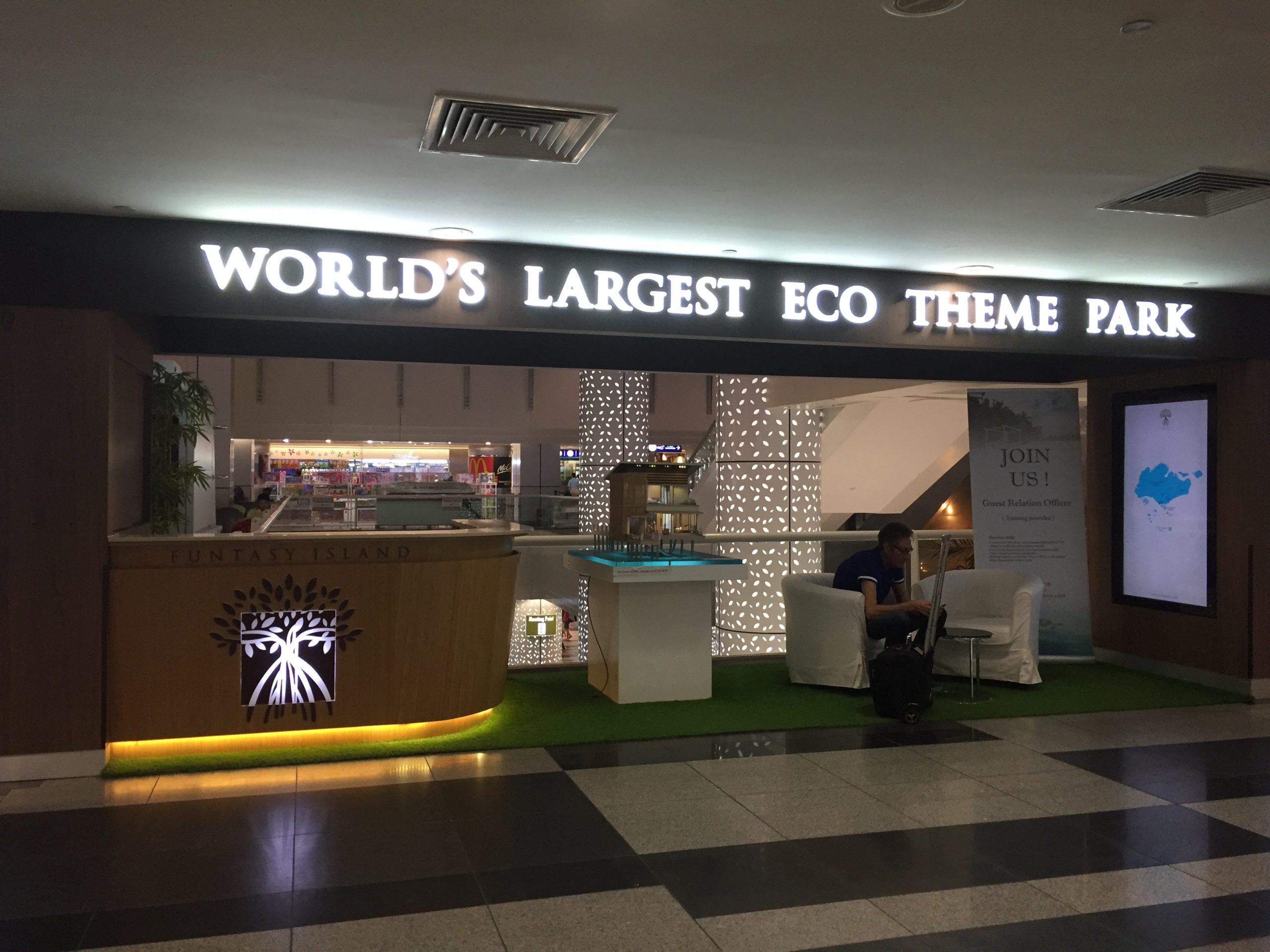 \
\
Figure 1. The Funtasy Island marketing booth at HarbourFront Centre.
Courtesy of the author.
The photograph (fig. 1) was taken at Singapore’s HarbourFront Centre, a shopping mall that doubles as a ferry terminal and connects Singapore to nearby Indonesian ports, including the island-city of Batam. Looking at this photograph, the “island” appears staged by property developers to appeal to potential buyers and tourists. It conjures an image of the possibility of being a global citizen that divides him/herself between two different islands in two different countries. During the course of the project, I reflected upon the tourist experience as it is shaped by particular types of places: the borders that exist between the two islands, the ferry terminals or ports at both Singapore and Batam, and shopping malls as places of consumption visited by tourists.
During my research, I observed groups of tourists who, benefiting from the high-accessibility of ferries between Batam to Singapore, extended the cosmopolitan narrative of cross-cultural engagement in the form of shopping (here, phrases like “shopping-holidays” come to mind). One of my earlier visits was to Batam’s Nagoya Hill, the island’s largest shopping mall, and one could easily make out from the variety of shops and goods on offer at Nagoya Hill that it is catered for lower-middle class consumers, as we can see from the image of a shop called “Orchard Shoppes Avenue” (fig.2). It is a part-fashion, part-souvenir shop, yet it was harder to find souvenirs from Batam than souvenirs from anywhere else in the world. Although t-shirts, bags, and baseball caps with Singapore logos and slogans are placed where people would easily find them, souvenirs from Batam were actually buried under and hidden away. I speculated that part of the reason for this may be that, to many Indonesian migrant workers at Batam (the majority of whom are not passport-holders), it is seen as more prestigious and sophisticated to give souvenirs of Singapore to friends and family back home, even though they have never set foot in Singapore.

Figure 2. Orchard Shoppes Avenue, a souvenir shop in Batam’s Nagoya Hill.
Image courtesy of Eldwin Pradipta.
This leads us to question the nature of souvenirs in our time of tourism. As part of the exhibition (fig. 3) display, we included souvenirs bought from the two islands, even if they did not represent Batam or Singapore directly. Among these were miniatures of Eiffel Tower, Dutch windmills, Malaysia’s Petronas Tower. They were considered important parts of the exhibition as they allowed us to question the relationship between souvenirs and memory. If souvenirs function primarily as markers of memory – conventionally, they serve to remind us of the places we bought them from – then what sort of experience are we trying to get by buying souvenirs of places from which we have never been?
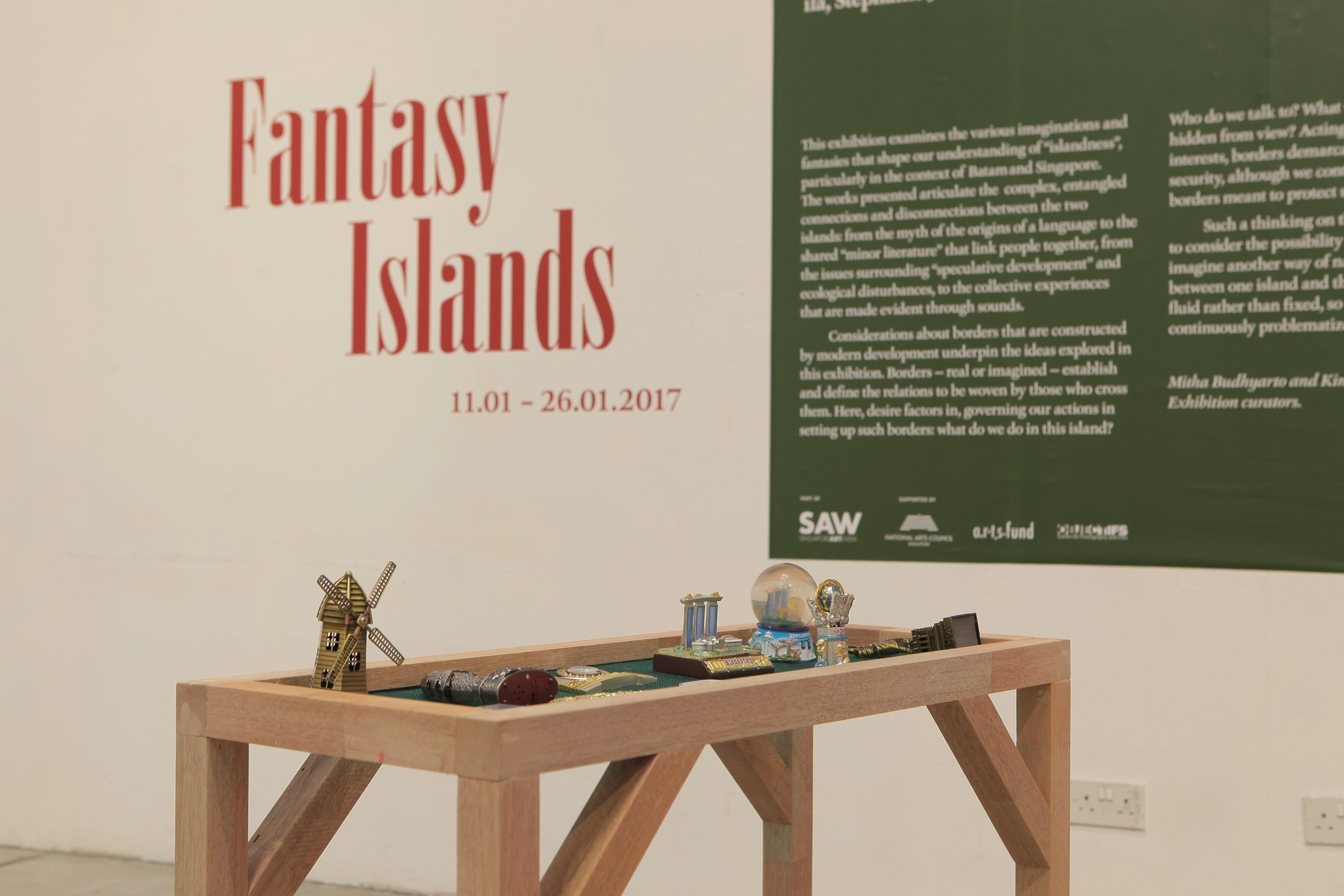
Figure 3. Fantasy Islands, exhibition view of souvenirs.
Image courtesy of Fantasy Islands team.
To put it differently, if what we are trying to experience is not the Eiffel Tower, the Dutch windmills, Petronas Tower, and so on, as they were “lived” – since we never had firsthand encounters with them – then what role do these souvenirs play in ascribing value to the places that they are supposed to represent? Here, a form of déjà vu – an experience of the “past that was never actual” – is evoked by souvenirs that are bought without one having been to the place that the souvenir symbolises. It appears that what we are trying to recollect is not, in Virno’s terms, a “dateable, defined past” that was obtained from firsthand experiences, but rather a past that never, in fact, took place.
The firsthand, direct involvement with a place that is missing from this experience opens up an imagined realm of longing: that place maintains its distance, remaining far and unattainable, and we begin to long for a kind of acquaintanceship despite the fact that we were never there. It is this lack of embodied presence that is substituted by the souvenir, and, as such, the souvenir functions as a familiarising tool, rather than a tool for remembering: the place that one never visited ceases to be so foreign as we acquaint ourselves with the way it is symbolised by the souvenir. Here, the souvenir does not provide an affirmation of a supposedly authentic experience; rather, it serves to momentarily sever the distance that exists between the two places. For instance, France may be an alien territory, but a tea towel bearing images of baguettes and Eiffel Towers make it seem familiar and accessible.
At the risk of hasty generalisation, a distinction may be drawn between the figure of the explorer and the tourist. In her study on souvenirs, Beverly Gordon refers to the 19th century ethnographer Arnold van Geppen, who states that: “A man at home, in his tribe, lives in the secular realm; he moves into the realm of the sacred when he goes on a journey and finds himself a foreigner in a camp of strangers.”24 Unlike van Geppen’s explorer who leaps into the unknown and holds the act of travel as a kind of sacred pilgrimage due to the sense of discovery and authenticity it promises, the tourist moves within the commoditised circuit of package holidays and pre-booked tours that spectacularise the “authentic” experience. For the tourist, what is desired is not necessarily proof of firsthand experience – “I have seen with my own eyes the grandeur of the Eiffel Tower and the couple kissing underneath it” – but an affirmation of the place which the souvenir testifies to, whose identity has been idealised through the complex maze of marketing, advertising and branding strategies. As such, the souvenir not only validates the branded identity of the site but also familiarises it, rendering it if not intimate, then certainly recognisable. It tames the site so that it no longer appears inaccessible. It matters less that one has never visited Paris, Singapore or Batam, and more that the souvenir symbolically reduces the distance – real and imaginary – that remains between places.
Conclusion
As mentioned in the beginning of this essay, déjà vu bewilders us as it stands at the intersection between memory and perception; it is the momentary disconnect between what we perceive and what we remember that envelope déjà vu with a distinct sense of strangeness. Freud’s account of the phenomenon positions it, under the “uncanny,” as a pathological symptom to be remedied; while the influence of Freud’s framework is no doubt far-reaching, it remains limited in addressing, for instance, the temporal dimension of déjà vu as well as the role of physical objects in shaping the way déjà vu is experienced.
An alternative framework for analysing déjà vu is offered here by referring to the characteristics of déjà vu as identified by Benjamin and Virno. Here, Benjamin is instructive for two reasons: first, for putting forth an interpretation of déjà vu that is not confined to memory and the idea of an inaccessible past, and suggesting, instead, that déjà vu is part of the historical experience where the past unfolds to the future; and second, for linking déjà vu to kitsch by emphasising the felt dimension of familiarity. The temporality of déjà vu is elaborated further by Virno, who asserts that déjà vu reveals a “past that was never actual”—a dateless, non-chronological past that is experienced in an alternative version of the present moment, which he refers to as the “potential now.” Regarding kitsch objects and the déjà vu experience, this essay focuses solely on souvenirs from places that one has never been to, refers to Stewart’s idea of longing, and suggests that the “potential now” opens up a dimension of longing for familiarity – rather than a longing for what Stewart calls the “authentic” experience of places that were visited in the past – within the alienating setting of global tourism.
The focus on souvenirs from unvisited places is drawn from the curatorial project entitled Fantasy Islands, in which I was involved as a co-curator. Though the project was specifically centred on the relations between Batam and Singapore, it nonetheless opened an opportunity to consider the contemporary role of souvenirs. Observations made during the project showed that souvenirs do not necessarily represent the memory of firsthand experiences of a particular place. While nostalgia may be a defining trait of souvenirs that are attached to a person’s firsthand experience and the wish to recollect that experience from memory, souvenirs of places that were never visited evoke instead a déjà vu in its quest for familiarity. Nostalgia is driven by the desire to reclaim memories of the past; such reclamation is prohibited from déjà vu, and souvenirs of unvisited sites may be seen as its material manifestation. Additionally, it must be noted that, rather than representing an impossible longing to return to past places, such an approach to souvenirs presents instead a desire to domesticise and demystify foreign lands that are beyond one’s reach – a desire that is no doubt shaped by concerns such as social accessibility, which is a pertinent issue that lies outside of the scope of this essay.
Footnotes
Introduction
1. “A Past in General”:
a. Benjamin on déjà vu and the historical experience
b. Virno on déjà vu as the precondition of historical possibility
2. A Longing for Familiarity:
a. Stewart on longing
b. Benjamin on familiarity
3. Souvenirs from the Past that Never Was:
a. If souvenirs function primarily as markers of memory – conventionally, they serve to remind us of the places we bought them from - then what sort of experience are we trying to get from buying souvenirs of places what are we that we have never set foot on?
b. The first-hand, direct involvement with a place that is missing from this experience opens up an imagined realm of longing: that place maintains its distance, standing unattainable, and we begin to long for a kind of acquaintanceship despite the fact that we were never there.
4. Conclusion:
a. Souvenirs beyond nostalgia
2 Paul Virno, Déjà Vu and the End of History (verso, 2015) 19.
3 Nicholas Royle, The Uncanny (UK: Manchester University Press, 2003); and Peter Krapp, Déjà Vu: Aberrations of Cultural Memory (US: University of Minnesota Press, 2004).
4 Royle 172.
5 Benjamin qtd. in Krapp 37.
6 Sigmund Freud, The Uncanny. (London: Penguin, 2003).
7 Benjamin qtd by Peter Szondi, “Hope in the Past,” Berlin Childhood Around 1900 (US: Harvard University Press, 2006) 19.
8 Szondi and Krapp.
9 Krapp 35.
10 Virno 46-55.
11 Hiyashi Fujita, “Déjà vu: Force of the False and Idleness of Memory. Deleuze or Bergson III”. Fragments and Wholes: Thoughts on the Dissolution of the Human Mind, ed. by Kenjiro Tamogami and Masato Goda (Paris: L’improviste, 2013) 91.
12 Virno 50.
13 Virno.
14 Bergson in Virno, 19.
15 Susan Stewart, On Longing: Narrative of the Miniature, the Gigantic, the Souvenir, the Collection. (US: Duke University Press, 1993) xii.
16 Stewart 133.
17 Stewart 154.
18 Stewart 155.
19 Stewart 136.
20 Stewart 23.
21 Benjamin qtd. in Krapp, 36.
22 Krapp 36.
23 Arlina Arshad, “Indonesia warns developer against claiming island resort belongs to Singapore,” The Straits Times. Accessed 11 May 2017.
24 Van Geppen qtd. in Beverly Gordon, “The Souvenir: Messenger of the Extraordinary,” The Journal of Popular Culture (vol. 20, issue 3, 1986) 136.
References
Arshad, Arlina. “Indonesia warns developer against claiming island resort belongs to Singapore”. The Straits Times. Accessed 11 May 2017. Web.
Freud, Sigmund. The Uncanny. London: Penguin, 2003. Print.
Fujita, Hiyashi. “Déjà vu: Force of the False and Idleness of Memory. Deleuze or Bergson III”. Fragments and Wholes: Thoughts on the Dissolution of the Human Mind, edited by Kenjiro Tamogami and Masato Goda, Paris: L’improviste, 2013. 81-109.
Gordon, Beverly. “The Souvenir: Messenger of the Extraordinary.” The Journal of Popular Culture. Vol. 20, issue 3, 1986: 135-146.
Krapp, Peter. Déjà Vu: Aberrations of Cultural Memory. US: University of Minnesota Press, 2004.
Royle, Nicholas. The Uncanny. UK: Manchester University Press, 2003. Print.
Stewart, Susan. On Longing: Narrative of the Miniature, the Gigantic, the Souvenir, the Collection. US: Duke University Press, 1993. Print.
Szondi, Peter and Mendelsohn, Harvey. “Hope in the Past.” Critical Inquiry, vol. 4, no. 3, 1978: 491-506.
Szondi, Peter, “Hope in the Past,” Berlin Childhood Around 1900, US: Harvard University Press, 2006.
Virno, Paul. Déjà Vu and the End of History. Verso, 2015.
Essays
Everything Old is New Again: Musical Appropriation in the 19th and mid-20th centuries
The citing and appropriation of music from other sources by composers and performers has been commonplace for many centuries. The following is an account of the use of quotations from the Classical era, the Jazz era and in American Popular music from the mid- to late 20th century. This essay discusses aural traditions, the appropriation of culture and racial tensions in the transformation of original music into new works. This essay also explores the quotation of Popular music in Classical music and vice versa, the unique practice of musical mockery and the communication of coded messages in music.
The Greatest Form of Flattery
Before the conservatory system emerged in Paris in the 1800s, composers developed their craft by studying and, in some cases, literally copying successful music of the past. The fact that many of Beethoven’s greatest hits can be traced to Mozart—with no intent to hide the origin—would indicate that copying ‘best practices’ was one of the most accepted ways of learning the craft of composition at the time. Another celebrated story about this process concerns a young J.S. Bach reaching into a cupboard late at night to secretly copy a manuscript that his older brother forbade him to use. That Bach learned his craft by copying contemporary hits is further emphasised by his transcriptions of great concertos by his Italian contemporaries, especially those of Vivaldi.
Composers commonly used structures and distinct forms of successful compositions in their own work. As Charles Rosen demonstrated,1 Schubert famously used the finale from Beethoven’s Piano Sonata in G, Op. 31, No. 1 as a blueprint for the finale of his own Piano Sonata in A Major, D959. The finale of Beethoven’s Piano Concerto No. 3 in C minor borrows nearly exactly from the finale of Mozart’s Piano Concerto in D minor, K.466. Brahms, in turn, based the finale of his D minor Piano Concerto, Op. 15 on that of Beethoven’s. The finale of Beethoven’s Ninth Symphony became particularly fertile ground for this type of ‘structural quotation’. Robert Schumann (in his Fantasy in C, Op. 17, 1st Movement) and Liszt (in his Piano Sonata in B minor, Op. 53) used the overall structure of the Ninth’s finale as the architectural plan for their own masterpieces.
Like musicians in the pre–conservatorium era in Europe, the learning of Jazz music in America in the early 20th century happened in an experiential way, not in an academic setting. Jazz musicians have often outright rejected the academic approach to learning music. Jazz was formed in the musical polyglot of New Orleans—in brothels and bars in Storyville—and has always retained a romantic connection to the street as its source of authenticity. Lawrence Berk opened Schillinger House in 1945 and dedicated it to the teachings of his mentor, the great polymath Joseph Schillinger, and the Schillinger System of Musical Composition. This later became Berklee College. A systemised approach to teaching Jazz was subsequently formulated in the mid-1960s at Berklee by people like Jerry Coker, David Baker and Jamie Aebersold. The phrases of earlier Jazz musicians were transcribed (for example, the Charlie Parker Omnibook), analysed and appropriated into a system of patterns for the study of Jazz improvisation. Books full of these musical quotations were transformed into Jazz exercises and published as ‘how-to’ approaches to learning Jazz. Many have argued that the dissection of Jazz for academic teaching has been detrimental to the genre. Two decades earlier, in the 1940s in New York, Miles Davis had dropped out of Julliard to play with Charlie Parker on 52nd Street, forsaking the classroom for the musical education of the jam session.
In its purest form, Jazz is studied like an aural tradition. The language of Jazz is passed down from improviser to improviser through live performances and recordings. Novices listen, analyse and imitate their heroes. Modern Jazz musicians quote musical excerpts taken from early Jazz recordings and incorporate them into their own playing as a rite of passage. This form of quotation serves as a learning mechanism, provides an aural connection and is a show of respect for masters of the past. The improvisational language of Jazz music and its cultural traditions could be said to be kept alive through this form of quotation where listeners can hear echoes of Louis Armstrong or John Coltrane in the performances of contemporary musicians.
Ownership and the Transcendence of Appropriation
It is one thing to musically appropriate and another to appropriate, then utterly possess the original and transform it into your own image. Beethoven practically made a career out of it. Perhaps the most iconic Classical music motif of all time is the opening four notes to his Fifth Symphony in C minor, Op. 67. Beethoven remade the common rhythmic pattern of this Symphony into a brand identity, and any composer using a similar rhythmic pattern after would be heard to be invoking the great master. Yet the rhythmic pattern, Fate Knocking on the Door, of his Fifth Symphony was utterly common in his time, and often used in accompaniment and melodies. For example, see the opening of Clementi’s Piano Sonata in G minor, Op. 34, No. 2, composed in 1795:

Opening of Clementi’s G minor Sonata, Op. 34, No. 2 (edited by Moscheles)
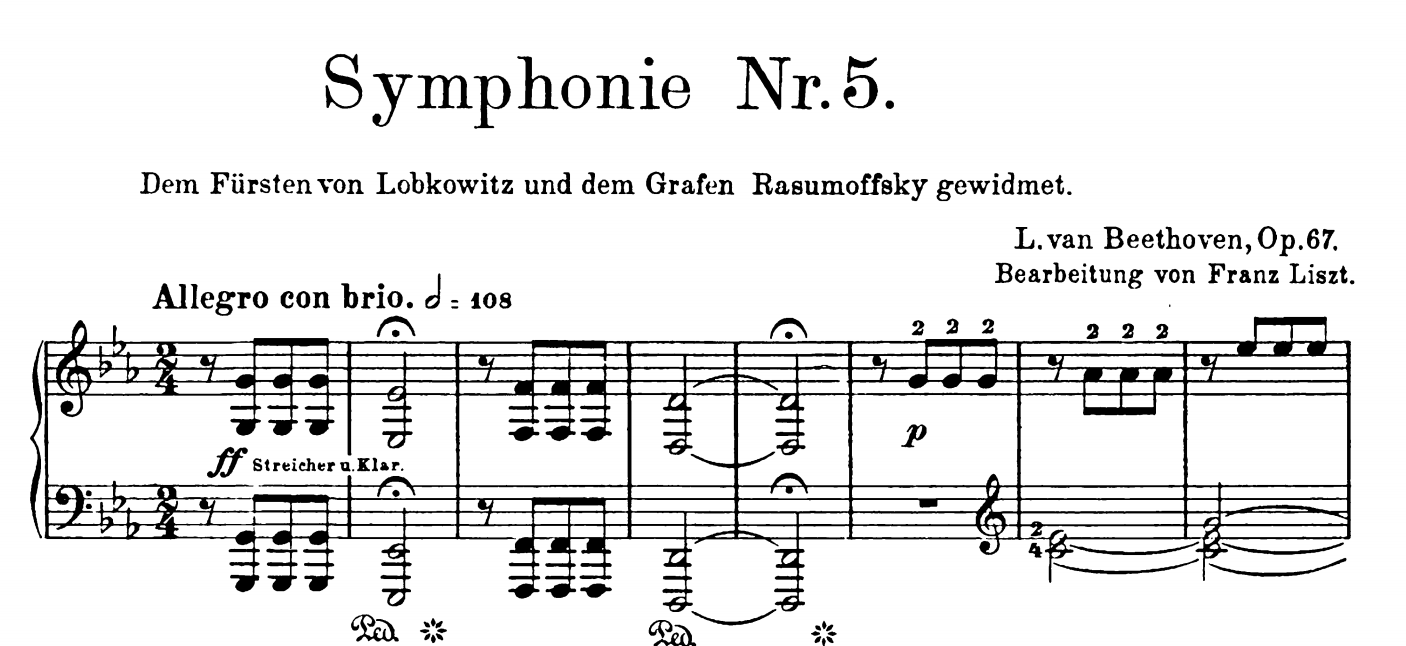
Opening of Beethoven’s Symphony No. 5 in C Minor, Op. 67
(transcribed by Liszt)
Here we have the iconic rhythmic gesture of Beethoven, and the key he made so famous, C minor. A brief glance at the two examples above illustrates a very small step from the Clementi excerpt to the iconic Fifth Symphony opening (and also to the opening of Beethoven’s Pathetique Sonata, composed three years after Clementi’s sonata). Clementi was a colleague, friend and eventual business partner of Beethoven, and one about whom Beethoven spoke with great admiration. Yet, today, who remembers Clementi’s Piano Sonata and who does not know the opening of Beethoven’s Fifth Symphony?
The history of American folk and Popular music in the forms of Gospel, Blues and Jazz could be seen as a history of appropriation and transcendence of European music by African Americans. By appropriating European musical building blocks and forms, and combining them with the rhythmic complexities and emotional directness of African music, new musical forms that transcended the original materials were created.
The Paris World Exposition in 1889 had a similar effect on European composers. Debussy appropriated the ‘exotic’ sound world of Southeast Asian music, particularly that of the Gamelan he heard at this historical event, which resulted in new ways of musical expression that marked the beginning of the Modern era of tonality and orchestration in Classical music.
Ironically, given the appropriation of European music by African-Americans in the early part of the 20th century America, a continuing injustice felt by African-American musicians was the appropriation of the styles of music that they had developed by Caucasian musicians for their own profit and success. Even though Jazz was undoubtedly created by early African American pioneers like Buddy Bolden, King Oliver and Louis Armstrong, the first ever recording of Jazz was by a Caucasian band (The Original Dixieland Jass Band, 1917). Furthermore, the most highly paid bands in the commercial heyday of Jazz in the 1930s were Caucasian bands like the Paul Whiteman Orchestra, and the orchestras of Benny Goodman and Glenn Miller.
The musicians’ strike of 1942-44 was America’s “longest strike in entertainment history” involving a dispute about royalties being paid to musicians by record companies. During this time no union musician could make a commercial recording.2 What was particularly in dispute was the copyright of melodies. Chord progressions and song forms were less of an issue and this led to musicians recomposing new melodies over the appropriated chord structures of Popular songs. Typically, these songs came from musicals penned by immigrant Jewish songwriters (educated in European conservatories) in New York’s Tin Pan Alley like Jerome Kern, Cole Porter and George Gershwin, among many others.
In the early 1940s, during this creative ‘blackout’, there emerged a new form of cutting edge Jazz called Bebop in the after-hours jam sessions in places like Minton’s Playhouse in Harlem. The practice of appropriating a song’s chords and form and composing new melodies for them became the bedrock upon which the musical style of Bebop was created. By using this method, numerous standard pop songs became ‘owned’ by the Beboppers, and were transformed into a new musical language. The chords and forms for Popular tunes like Honeysuckle Rose became Scrapple from the Apple; Whispering became Groovin’ High, and even Gershwin’s I Got Rhythm was transformed into countless new compositions by Bebop musicians.
At first, the Bebop fraternity was made up of African American musicians who had grown tired of the bland, commercial and formulaic ‘Swing Bands.’ The Beboppers wanted to create a style of music that the Caucasian musicians could not imitate. Bebop was extremely fast and technically demanding. It was more rhythmically complex, and the melodic shapes that they had created over the old song forms were more angular, irregular and unpredictable. The intention of this music was famously unsuitable for dancing and singing. It was a radical backlash of the Caucasian dominated ‘Swing Band’ establishment. The extremes that the Beboppers went to, in forging an original musical style appropriated from European song forms, has been widely recognised by historians and critics as the apogee of African American musical creativity.
Musical Codes and Passwords
An aspect of African music inherent in the later forms of American music was the idea of subliminal coded messages embedded in the music itself. Traditional African drumming used coded messages embedded in their rhythms and the structures of their beating, to send signals to other people in the tribe and even over great distances to neighbouring tribes. Individuals would take turns to solo within these drum groups, further embellishing the code of the idea and adding their own personal comments to the musical discourse. When African slaves arrived in America they were denied their language, customs and music as a way of forcing their assimilation into subservient roles within their new alien society. To communicate with each other, slaves invented sign languages and, in particular, coded ways of singing and making music.
For slaves in the New World, an early form of this coded musical language was the work song performed by chain gangs and later, groups of emancipated African-American workers. For instance “…the all black ‘gandy dancer’ crews used songs and chants as tools to help accomplish specific tasks and to send coded messages to each other so as not to be understood by the foreman and others.”3
One of the first and greatest Jazz stars of the 1920s and 30s, Duke Ellington, said: “people send messages in what they play, calling somebody, or making facts and emotions known. Painting a picture, or having a story to go with what you were going to play, was of vital importance in those days.”4
The famed Jazz saxophonist Charlie ‘Bird’ Parker was the undisputed leader of the Bebop movement and was also its spiritual talisman. To play like Bird, and be accepted into this underground fraternity, many musicians thought you had to live like Bird. This went as far for some as developing a heroin addiction like he had. Musicians in this group who were hooked, and in need of a fix, would whistle the first few bars of one of his tunes titled Parker’s Mood as a musical password, to signify that there were other addicts nearby, and it would be possible to score.
Within Bebop, the idea of being in on a private musical joke or showing solidarity to a rebellious musical movement grew out of the racist exclusion of African Americans from the commercial profits of the music that they had created, and can be linked back to the codified ways of communication embedded in the musical expressions of slaves. It was not surprising that African American Jazz musicians developed the habit of sending musical signals to those who were ‘in the know.’ This included not only musical gestures, but a whole new vocabulary of euphemisms to describe the music and the people who played it. ‘Bad (Arse)’ typically referred to someone who was exceptionally good at performing Jazz. If someone was ‘hip’ they were one of the group, someone in the know, and they were able to ‘get’ the music and understand its hidden language.
Introducing the Everyday into the Sublime
A once vibrant source of musical quotation for Classical composers came from Popular music. Classical musicologists tend to designate Popular tunes that survived as folk music, making it more ‘acceptable’ to use for the loftier aims of great composers. All of the greats quoted from the Popular music of their day.
For example, the Bach family made a musical game of quoting Popular music and creating spontaneous canons and fugues from them. This was apparently their version of light party entertainment. Beethoven is said to have used two Popular tunes of his day for the second movement of his Sonata No. 31 in Ab, Op. 110. The two tunes translate into My cat has just had kittens and I’m a slob, you’re a slob. They follow the music of the first movement, one of the loftiest and most sublime musical utterances ever.
As far back as the 16th century Popular tunes infiltrated the great polyphonic music of the Catholic mass—the ‘parody’ or ‘imitation’ masses would use as source material Popular songs of the day. An equivalent today might be a mass composed from melodies, bass lines, rhythms and harmonies from a Popular musician, a veritable ‘Missa Gaga.’ Perhaps the outcomes of Vatican II in the 1960s to transform the Latin mass into English, including the composition of folk inspired Popular hymn styles, could be seen as an historical throwback to these earlier times.
When it comes to the use of Popular musical quotes in Classical music, there seems to be a special place reserved for the use of children’s tunes. One of Mozart’s most beloved variation sets is based on Ah vous dirai-je, maman or what we may more commonly know as Twinkle, Twinkle Little Star. Chopin quotes one of his homeland’s most beloved Christmas carols, a lullaby for the baby Jesus, Lulajże Jezuniu, in the B section theme of his Scherzo No. 1 in B minor, Op. 20. Mahler uses the tune, Frère Jacques, for the finale of his Symphony No. 1, cleverly using the minor mode to hint at sinister undertones to this happy melody. Debussy quotes two of his favourite children’s tunes multiple times, Nous n’irons plus a bois and Do, do, l’enfant do.
In America, the Beboppers and the Jazz musicians who followed would insert quotations of Popular songs into their solos to refer to “experiences that artists associated with the titles or the key lyrics of songs…Roy Haynes [Jazz drummer] fondly recalls an occasion when Charlie Parker improvised a ‘burning’ [intensely creative] solo in which he quoted The Last Time I Saw Paris repeatedly ‘in different keys.’ Unable to contain his curiosity afterwards, Haynes asked Parker what actually had happened ‘the last time’ Parker saw Paris[!]5
“Sometimes, [in a Jazz performance] the titles of compositions serve as instructional codes, as when soloists quote tunes like I Got Rhythm or I Didn’t Know What Time It Was when the rhythm section begins to lose its coordination, destabilising the beat.”6 Not unlike some of the coded purposes of earlier work songs to achieve synergy between groups of workers on a chain gang, if a drummer was playing out of time or the bass player started slowing down, a soloist (other member of the band) might quote these well-known tunes to send a musical message to his fellow players to listen out, catch up, and get back together musically with the rest of the group.
Everything Old is New Again
Everything Old is New Again, a song by the late singer-songwriter/recording artist, Peter Allen, touches upon a very human issue concerning a longing for days gone by or ‘the good old days’, when love seemed easier, people appeared nicer, values were much better, life much simpler and there was a tenuous but lingering illusion of hope for a better future:
Don’t throw the past away
You might need it some rainy day
Dreams can come true again
When everything old is new again
Generation after generation of musicians, songwriters and performers continue to bear out this Peter Allen theme of ‘everything old is new again’ when ‘dreams can come true again’, through the appropriation of identifiable musical motifs from ‘the good old days.’ Direct and indirect quotation, identifiable variations of themes, digital sampling and often the wholesale hijacking of compositions are common practice in the creation and production of Popular Music, especially if the original source music is in the ‘public domain.’
Two classic examples of the wholesale appropriation of Classical compositions in Popular music can be found in Elvis Presley’s 1960 #1 hit, It’s Now or Never, and the 1965 #2 U.S. pop hit record, A Lover’s Concerto, by the African American girl group, The Toys. Based on the music of Italian composer, Eduardo di Capua, O Solo Mio transformed into It’s Now or Never with the help of English lyrics written by Aaron Schroeder and Wally Gold. A similar accomplishment was achieved by the two, now legendary American songwriters of A Lover’s Concerto, Sandy Linzer and Denny Randell, who drew their hit song from Minuet in G Major by Christian Petzold (a composition previously credited to J.S. Bach), found in Notebook for Anna Magdalena Bach (1725), which is a compilation of the works of a variety of composers of the late 17th and early 18th centuries. However, the two songwriters changed the original 3/4 time meter to 4/4, which is the basic pulse of Rock & Roll and Popular dance music in general. They also made minor adjustments to the original melody in order to accommodate the flow of their added lyric. The record sold more than two million copies, and has benefitted from numerous cover versions and motion picture features—quite an accomplishment for music written more than one hundred years prior.
Two iconic examples of appropriating portions of musical content from Classical compositions are the product of pop singer-songwriter/recording artist, Eric Carmen. Having attended the famous Cleveland Institute of Music as a child, Carmen gained an obvious affection for the music of Russian composer, Sergei Rachmaninoff, basing two of his most famous pop hits, Never Gonna Fall In Love Again and All By Myself, on the adagio from Rachmaninoff’s Symphony No. 2, and the second movement (Adagio sostenuto) of his Piano Concerto No. 2 in C minor, respectively (being from a family of Russian immigrants, I wonder if there is a more deep-rooted connection to the music of Rachmaninoff that inspired Carmen to appropriate his music and apply it so effectively). Unfortunately, Carmen was under the mistaken impression that both Rachmaninoff compositions were in the public domain and, not surprisingly in today’s litigious climate, was approached by the Rachmaninoff estate informing Carmen otherwise. An agreement was reached, whereby the Rachmaninoff estate would receive 12 per cent of the royalty income of both songs).
An even more extreme and odd example of this quest for ‘things past,’ the pops, scratches, hiss and generally degraded sonic ambience of old vinyl recordings, that digital technology was to magically eradicate with the advent of the compact disc, are now being introduced back into Popular recordings through software plugins specifically designed and developed to emulate those previously unwanted sounds that were once considered dreaded distractions. Record producers are adding those previously cursed sounds back into their pristine digital recordings to give them a ‘retro’ or ‘dirty’ sound. ‘Dirty’ is in, and ‘clean’ is out, which largely took root among the African American musicians and producers in the early days of Rap, Hip Hop, and House Music beginning in the 1980s, not for the reasons stated above but, because the lo-tech instruments available to them at the time were cheap. Expensive analogue instruments, previously out of reach to most people, were literally being thrown out in favour of the new false messiah of digital instruments, and now, those trashed instruments are demanding a premium far above their original selling price, if they can be found. Even in this way, “everything old is new again” has taken root in the obsessive production of ‘analogue-modelled’ software synthesisers.
Musical Mockery and Situational Jokes
There are several instances where the use of a musical quotation to mock someone exceeded the fame of the original composition. Two iconic examples of great compositions that resulted from musical competitions involved Mozart in one instance and Beethoven in the other.
On Christmas eve in 1781, Mozart was summoned by the Emperor Joseph II. Instead of being asked to play, however, Mozart found himself being introduced to Muzio Clementi and soon in competition with him. At the behest of the Emperor, Clementi duelled Mozart, at least to a draw, to Mozart’s everlasting, bitter chagrin. Nearly 10 years later, Mozart composed one of his operatic masterpieces, The Magic Flute. In the overture, Mozart composed a three-voice fugue, using one of the most effervescent themes he ever wrote.
But that fugue subject was lifted nearly note for note from the opening of one of the compositions Clementi performed during their duel so many years before, the Clementi Sonata in Bb Major, Op. 24, No. 1.
Given Mozart’s lifelong animosity towards Clementi, and the bitterness he must have felt over having met a rival he couldn’t easily defeat, it is credible that Mozart used Clementi’s theme in part to show him up. Clementi obviously took the joke personally, for in every subsequent publishing of his sonata during his long life, he made sure to always mention that his sonata was composed long before Mozart’s Magic Flute.
One of Beethoven’s greatest hits also resulted from an improvisation contest. Daniel Steibelt, a German-born composer and pianist who was Beethoven’s contemporary, challenged him to a musical duel. The story goes that Steibelt went first, leafed through a recent composition, then dramatically tossed it aside before beginning his improvisation.
When it was Beethoven’s turn, he reportedly picked up the composition Steibelt had tossed aside, turned the last page upside down, then began to improvise on the theme that emerged from the final eight measures. As Beethoven’s improvisation became ever more impressive, Steibelt realised he was being made the brunt of a joke and left, supposedly never to return.
Years later, Beethoven used the musical quote from Steibelt’s composition for his Piano Variations Op. 35 and the finale to his Symphony No. 3 in Eb, the ‘Eroica’, Op. 55. Given Beethoven’s often-confrontational [JC15] relationship with his contemporaries, it is believable that he used the theme from his crushing victory to remind all competitors who was the king.
There are many examples of Jazz musicians using musical quotations in reaction to the environment they might be performing in, providing a situational joke for the benefit of the aficionado’s presence—whether they be other band members or audience members—if they were ‘hip’ enough. Again Charlie Parker was one of the most ingenious proponents of this technique:
…. he could see something happening and play upon it on his instrument. Like, he’d see a pretty girl walk into the club we were playing. He’d be playing a solo and all of a sudden he would go into A pretty girl is like a melody where ever he was [in the form of the song we were playing] and make it fit in. Or someone was acting a little crazy and he would play something to fit that.7
Parker famously quoted the opening bassoon melody of The Rite of Spring at the moment he saw Igor Stravinsky sit down in the club he was playing. Apparently Stravinsky nearly tipped his drink over and everyone roared with laughter at the musical quotation of his famous work. One of the best examples of Parker playing a musical quote that has yet to be decoded was his spontaneous use of the sea shanty The Horn Pipe over the bridge of probably one of the most demanding and stylistically archetypical works of the Bebop era, Ko Ko (created over the song form of Cherokee) recorded in 1945. The quotation is in plain sight, but todate no one has deciphered the meaning of the quote and why he played this seemingly innocuous ditty in the middle of, arguably, one of his most well known masterpieces.
In the early 21st century, technology enabled musicians to sample or ‘lift’ music from any piece of music that has ever been recorded. In the past few decades, the advent of Hip Hop and RnB heavily sampled music from other genres and movements like ‘plunderphonics’ that only used samples of other people’s music to create post-modern musical collages of sourced materials meshed together. Before we had the technological capacity to cut and paste music instantly from one format to another, composers indulged in musical duels and mocked each other by copying a rival’s work and then making it sound better and more commercially successful. Early African American Bebop musicians used the standardised forms of pop songs from musical theatre shows to create a whole new form of Jazz and continue the traditions of coded messages embedded in African drumming and Pop composers in America were appropriating excerpts from the European Classical music tradition to create top-selling hit songs.
Footnotes
1 Charles Rosen, The Classical Style: Haydn, Mozart, Beethoven (Expanded Edition), (New York: W.W. Norton,1998) 456-8.
2 “1942–44 musicians’ strike,” Wikipedia.
3 Anne Kimzey, “Alabama Worksong Singers Receive Highest Folk Arts Honor,” Alabama State Council on the Arts, Aug.1996.
4 qtd. in F. Paul Berliner, Thinking in Jazz: The Infinite Art of Improvisation (The University of Chicago Press,1994) 233
5 Berliner 176.
6 Berliner 427.
7 Roy Haynes qtd in Celebrating Bird: The Triumph of Charlie Parker.
References
Berliner, Paul, F. Thinking in Jazz: The Infinite Art of Improvisation. The University of Chicago Press.1994.
Celebrating Bird: The Triumph of Charlie Parker. Prod. Toby Byron. Dir. Gary Giddins. Toby Byron/Multiprises: Sony Video Software Co., Pioneer Artists, 1987. Video.
Kimzey, Anne. “Alabama Worksong Singers Receive Highest Folk Arts Honor.” Alabama State Council on the Arts. Aug. 1996. http://arts.alabama.gov/traditional_culture/folkwaysarticles/ALABAMAWORKSONGSINGERS.aspx. Web.
Rosen, Charles. The Classical Style: Haydn, Mozart, Beethoven (Expanded Edition). New York: W.W. Norton,1998. Print.
“1942–44 musicians’ strike.” Wikipedia. Wikimedia Foundation. Web.
Music scores
Arranger: Franz Liszt (1811–1886)
Editor: José Vianna da Motta (1868–1948)
Publisher Info. Franz Liszt: Musikalische Werke. Serie IV, Band 2-3.164-204.
Leipzig: Breitkopf & Härtel, 1922. Plate F.L. I-IX B.
Public Domain.
Essays
Creative Futures
déjà vu
An odd intuitive feeling warms our heart and consciousness - déjà vu.
On Monday 24th May 2017, the United Kingdom’s Labour Party’s Culture Manifesto was launched in Hull, the current UK capital of culture, by Labour’s leader Jeremy Corbyn and his deputy leader, Tom Watson. Why was this important? For two main reasons: firstly, it demonstrates that many in the creative and cultural sectors opposed Brexit; secondly, it confirms Labour’s commitment to introducing a £160m arts pupil premium (this refers to secondary school children) and promises investments in arts facilities in state schools, recalling the era of the 1960s Labour government.
For those of my generation that had free education and went to independent art schools, the Labour government led by Harold Wilson and the Minister for the Arts, Jennie Lee (also responsible for the establishment of the Open University in April 1973), transformed whole ideas, notions, aspirations and culture so that creativity belonged to everyone. In fact, the 50th anniversary of the publication of Lee’s white paper took place on 25th February 2015. It was the first white paper on the arts. Called A Policy for the Arts - First Steps (1965), Lee’s 19-page paper argued that the arts must occupy a central place in British life.1 For that to happen, she recognised that the arts needed to be embedded not only in the education system but, in everyday life. The arts had to be valued as highly as any other industry, and equal access to the arts wherever people lived must be made available. Significantly, the paper advised that new ventures needed to be supported as much as established institutions.
As Lee wrote in the paper: “In any civilised community, the arts and associated amenities, serious or comic, light or demanding, must occupy a central place. Their enjoyment should not be regarded as remote from everyday life.”2
And then she raised government funding by 30 per cent. Though she made no specific reference to the impact of the arts on the economy, ‘value added’ or aggregate employment in the arts, there was an emphasis on whether the state and its schools fostered artistic talent. The ‘economic impact’ approach became popular in the 1990s in part because it was easy to justify in statistical terms. As I outline in the essay, consultants and other external agencies and quangos add up all the money spent on the arts, regardless of what the money was spent on specifically, and from there go on to say how much the arts matter.
If all that sounds familiar it is because it should be: more than 50 years later, those involved in the arts and cultural life are still arguing for arts policy changes that Lee considered crucial to our everyday lives—to our wellbeing, spiritual and creative health.
In 2017, Corbyn was quoted saying: “We will end austerity to boost creativity. What we have proposed here today in Hull is something that will absolutely transform the cultural landscape of this country in exactly the same way [as] the 1960s Labour government.”3
Coupled with pledges to maintain free museum entry, the scrapping of tuition fees, extending the £1,000 pub relief fund to small music venues and reviewing how artists are rewarded for their work in the digital age, it is not surprising that all these intuitively give rise to an odd, though warm feeling of déjà vu. If déjà vu also encompasses a feeling of familiarity, in its definition, then my feeling of having “already lived through” the reassessment of the value of the arts in 1965 is strongly recalled today in 2017.
This essay is concerned with the arts and creativity. Why have the creative and cultural industries been significant to the economy over the last decade (even though I also critique them) and why is creativity, then, at the heart of everything we do? What is creativity in the first place? What does it mean to live a creative life especially as a political stand against Brexit and austerity?
Creative Living Beyond Fear
According to Big Magic (2015), a book on creativity by Elizabeth Gilbert, the reason you may not have written your first novel, taken up weaving, learnt the saxophone, or otherwise given expression to the art inside you is fear. In fact the full title of her book is Big Magic: Creative Living Beyond Fear.4 Building on her TED Radio Hour episode on the sources of creativity, Gilbert offers a guide to living a more creative life.5 Curiosity, she argues, is the key to an interesting life and often a creative one too. Writing a book is difficult enough, but writing a book about the creative impetus of writing is even harder. As Gilbert explains in an interview with The Guardian, years can be spent gathering hundreds of books that examine the links between creativity and madness, creativity and depression, cultural studies on creativity, the neuroscience of creativity, or creativity and computation. However, she chose a more personal approach: “I have had a way of interacting with creativity for over 20 years that has been really satisfying and expansive and I know about this, not from research but my own lived experience. For me it was about: do I trust my lived experience enough, with no back-up, to say, ‘OK guys, here’s what I know’?”6
Going Sane
For many, the thought of expressing themselves creatively is frightening, since creative work often collides with deeply-rooted fears: of ridicule, social rejection, discovering you lack talent (which is partly why I find contemporary TV shows like The X Factor (UK) so disquieting – as if people need to be ridiculed on stage), not to mention the fear of stirring up emotions you may have kept hidden for years. When emotions are released, they can fall into the cliché of madness, as Gilbert points out. The complexities of this are more helpfully articulated by British psychoanalyst Adam Phillips in Going Sane: Maps of Happiness, where he argues that there are “no famously sane poets.”7 In The New York Times review of Going Sane, Gideon Lewis-Kraus says that Phillips “fears that our reluctance to ask ourselves exactly what sanity means might be thwarting our attempts to attain it.”8 He goes on to say:
The problem is our tendency to romanticize madness. The mad “have traditionally been idealized, if not glamourized, as inspired; as being in touch . . . with powers and forces and voices” otherwise reclusive. Sanity, on the other hand, is described – when it is described at all – as a matter of moderation, self-control and mechanical rationality… Phillips proposes that if we stop disguising this natural ambivalence as madness, we might have a better chance of recovering these resources. We might, in turn, lead freer lives.9
Personal Stories
Perhaps hang-ups about creativity begin in childhood for those of us in Western and settled communities. Having been a post-war child in London, I can still vaguely remember ration coupons and grey blankets, and my mother’s fears of me ruining the saved-up rations of jelly mix, which I messed around with to create floppy sculptures that collapsed all too easily on the formica floor. Moody and diffident, my imagination was squelched; this was even more the case in the single-sex schools of the time, which promoted the aspirational values of a conservative government that emphasised (then as now) personal wealth over care for others, and power in place of the quality of people’s relationships.
Nonetheless, at secondary school I could hide in the art room, draw in maths lessons and generally perform the role of a recluse depressive: a woman on the edge of finding a creative self in the face of primness and propriety. Fifty years later, of course, it is much easier to rewrite the past according to my current understanding of creative tensions, but my sense even then was that teachers generally disliked more creative pupils, however much they claimed otherwise. Indeed, some neuroscientists argue that we have evolved to distrust creative ideas except in a crisis: there’s little survival benefit to trying something new. Paradoxically, however, even large corporations are looking for the holy grail of creativity to release the next big idea.
Creative Battles, Creative Lives
Perhaps the real question is not whether creativity provokes fear, but what to do when it does – even if there is an allout attack or a closing down. Steven Pressfield’s book The War of Art: Break Through the Blocks and Win Your Inner Creative Battles (2012) is a good example of how one should resist fear. What we are frightened of is perhaps being ‘really’ centrestage, which is counterproductive. It simply reinforces the idea that creativity must, of course, be an ongoing struggle, a barefisted fight, bordering on Hamlet’s madness or Lear’s near-insanity, as Phillips has in Going Sane in his chapter On Literature.
In Living and Sustaining a Creative Life: Essays by 40 Working Artists, editor Sharon Louden introduces the reader to various illusions expressed by those interviewed regarding what they thought would happen after art school.10 Many commentaries are situated within a belief system that galleries would support the artist both emotionally and financially, and that dialogues with other communities and fellow alumni would automatically follow. The interviews reflect the reality of how artists juggle their creative lives with the needs of everyday living, including families and care, institutional responsibilities, and running an individual studio space. Of course, the power of creativity does not just lie in an artist’s work, but also in the ways in which he or she continues to create regardless of the obstacles that life puts in his or her way. What the interviews reveal is the reality of how a professional, contemporary artist sustains a creative practice over time, both with and without funding, inside and outside the studio.11
Everyone is Creative
Most artists now working in academia would agree with the proposition that there has been an academic professionalisation of visual artists since the 1960s, which makes their education closer to that of academic disciplines such as architecture, design and sociology. Such a process of academic levelling also makes sense of the theoretical and multidisciplinary turn in most contemporary art practices, as explained in a seminal book by Howard Singerman, Art Subjects: Making Artists in the American University (1999). Not only has creative labour itself become a frequent topic in contemporary art but how artists labour.12 Under the financial, speculative and flexible conditions set by the ‘New Economy,’ artistic labour has changed, and so have the terms of how creativity is organised and valued. The term ‘New Economy’ is commonly used in contemporary sociology and political economy to refer to the financial, speculative and highly ‘technologised’ economy of the 1990s. Here I use the term in a broader sense—as the mode of production that has become dominant since the 1970s in Western countries and the developing world, notably in relation to the arts and the designated creative economy.13 This ‘New Economy’ has relied heavily upon the financial, media and entertainment, and cultural sectors as resources for the production of capital. For a general characterisation of the changes the ‘New Economy’ has brought, I refer to Richard Sennett’s The Culture of the New Capitalism (2009).
Professor Angela McRobbie, my colleague at Goldsmiths, has dealt with the issue of cultural and creative labour and the ‘New Economy’ in England. Her observations in Club to Companies: Notes on the decline of Popular Culture in Speeded Up Creative Worlds (2002) were noted in an article in The Sociological Review:
[McRobbie] proposes that in the ‘new cultural economy’ of the United Kingdom over the last decade, the ‘specialness’ of the artistic or creative practitioner has been extended to people working in a very wide range of fields, including art, fashion and music, so that workers, especially those who are young, are attracted to the contemporary creative industries by the freedom and status associated with a particular artistic identity, that of the auteur.
These cultural industries are regarded as highly successful. They have been estimated to ‘account for 8% of the UK economy’ (NESTA 2006: 2) and ‘more than 5% of GDP’ (Leadbeater, 2004). They ‘employ more than a million people in over 110,000 businesses’ (NESTA, 2006), many of them working in short-term, project-based jobs on a freelance, self-employed basis. This situation has been presented positively as offering flexibility and freedom, and as the model for the future of work, especially when linked to the ‘knowledge economy.’ However, critics point out that many creative workers have very limited job security and are low-paid or even unpaid. McRobbie argues that the artistic identity of the auteur reconciles new creative practitioners, at least for a time, to poverty or an uncertain income.14
Knowledge Economies and Artistic Labour
The flamboyantly auteur relationship to creative work is now being extended to a much wider section of a highly ‘individuated’ workforce, operating in a deregulated environment or ‘set free’ from both traditional workplace organisations and social institutions.15 In Club to Companies, McRobbie also suggests that the culture industries “reproduce older patterns of marginalisation” affecting women, black, Asian and minority ethnic workers. According to Leadbeater, about 4.6 per cent of Britain’s creative industry workforce is from an ethnic minority, compared with 7 per cent of the economy as a whole.16 In London, it is even starker: the discrepancy in the statistics is even greater. Another telling statistic is drawn from the 2013 Women and the New Economy seminar held at the Centre for Creative Collaboration, King’s Cross, London: explorations of all the available data showed that the rates of new enterprise formation by women in the UK rank significantly below those of G8 competing economies.
Assemble: Turner Prize 2015
The extension of artistic labour beyond the ‘specialness’ of the artistic or creative practitioner has taken an interesting turn with the announcement of the 2015 Turner Prize. The winners, Assemble, are a London-based collective who work across art, design and architecture to create projects in cooperation with the communities who use and inhabit them. The collective’s architectural spaces and environments embrace a Do-It-Yourself sensibility, and arguably promote direct action. Assemble’s 18 members received their £25,000 prize on 7 December 2015 from Sonic Youth co-founder and artist Kim Gordon; the awards dinner was broadcast live on Channel 4 from Tramway, Glasgow.
Assemble are the first non-artists (in the strictest sense of the word ‘artist’) to win the prize. They were nominated for their work tackling urban dereliction in Toxteth, Liverpool, where their aim was to use architecture and design to improve the houses and lives of residents living in an area called Granby Four Streets. Drawing on long traditions of creative and collective initiatives, their experiment in architecture and design tried to offer alternative models of how society can work. Assemble also has entrepreneurial flair. For the Turner Prize show, the group created a shop/showroom of products made by a social enterprise set up by the collective as a result of the nomination. When items are sold, the money is ploughed back into the project. For £15, people have been able to buy a door handle made from sawdust; there are also pairs of Granby rock bookends at £40, while £150 will buy you a pressed terracotta lampshade. This shop has created an alternative and creative business model to a standard market-led approach. The studio in Assemble’s case is an architecture design practice, and the gallery is only one of the outputs for their work.
As art critic Adrian Searle pointed out in The Guardian:
Assemble’s win signifies a larger move away from the gallery into public space that is becoming ever more privatised. It shows revulsion for the excesses of the art market, and a turn away from the creation of objects for that market. Their structure that was on show at this year’s Turner exhibition must be seen not as a work, but as a model of work that takes place elsewhere; not in the art world, but the world itself. Assemble demonstrates how artists and architects can engage with communities, and work creatively in the wider social sphere.17
And yet, despite its centrality, the nature of creativity – its defining conditions, its workings in different arenas, and its values – often seem to be assumed rather than critically understood.
Creativity is increasingly linked – almost formulaically – in a new conjunction, ‘creativity and innovation.’ This is proposed as a key driver of a nation’s economy, not in the same way as Searle’s reading of Assemble’s Turner Prize win, but as embedded in a nation’s deterministic vision of ‘creative industries.’ Creativity and innovation are seen as forces to be harnessed in the service of economic growth. In 2000, the European Union agreed on the Lisbon Strategy, which argued that ‘creativity’ and ‘innovation’ are central to progress and development: the goal for Europe was to become “the most competitive and dynamic knowledge-based community in the world by 2010.” This puts ‘innovation’ at the top of the European research agenda.
Cultural Policies and Creativity
At one end of the spectrum, the question of creativity focusses on the relationship between the professional creative artist and a creative ensemble (which is how I would describe Assemble and their work with social housing – a kind of socially-engaged design practice that uses the institutions of art and conventional gallery spaces as a model for their creative output). At the other end of the spectrum, creativity, now coupled with innovation, has become a question on which the wealth of nations is seen to depend. In the UK, a report by the National Endowment for Science, Technology and the Arts (Nesta), Creating Growth: How the UK Can Create World Class Creative Businesses (2006), estimated that the creative industries accounted for eight per cent of the UK economy – a total of £56.5 billion – with exports contributing £11.6 billion to the UK balance of trade in 2003. Globally, Nesta estimates that the global market value of the creative industries increased from US$831 billion in 2000 to US$1.3 trillion in 2005, with global revenues from cinema admissions alone amounting to US$25 billion.
Indeed, more recent UK government reports stress the importance of creative skills in supporting innovation for the future vitality of the British economy.18 The business-oriented psychologist, Keith Sawyer agrees, stating: “innovation is what drives today’s economy, and our hopes for the future – as individuals and organisations – lie in finding creative solutions to pressing problems.”19
This is clearly very big business. Economic, social and policy research has become a matter of national or regional priority in a number of territories as the economy shifts from production to consumption, and from manufacturing to services. The challenging questions may lie in the links that stretch from one end of the spectrum to the other, and that might tie together – perhaps in critical tension – familiar questions of creativity and expressiveness with new questions of creativity and innovation.
In a 2001 paper, Cultural Policy: Rejuvenate or Wither, Tom O’Regan, Director of the Australian Key Centre for Cultural and Media Policy, builds upon the work of Australian economist David Throsby.20 He proposes a model comprising three concentric circles: the first circle consisting of traditional creative arts such as dance, theatre, literature, visual arts, as well as new arts like video art, performance art, multimedia; the second consisting of industries such as television, publishing and film, whose output is cultural but whose structure is industrial; and the third consisting of industries like advertising and tourism, which exist outside the cultural sphere but whose outputs may have cultural dimensions. Such a model, as O’Regan recognises, has informed cultural policy and state intervention, dividing the field into different business models, from subsidy to free market competition.
The danger of such a division into compartments is two-way: it may miss both the questions of creativity and culture which flow from the inner circle to the outer and the questions of innovation and entrepreneurship which may flow from the outer to the inner. Some of these issues are addressed in work on the ‘creative city’ and the rise of the creative class, which Richard Florida discusses in his influential US ‘national bestseller,’ The Rise of the Creative Class (2002).21 Whilst Florida’s book has come under criticism (rightly so) both for its data and its categories, it is suggestive in its identification of both the material and the intangible components that provide the environment within which a creative community flourishes: not only employment opportunities and technology, but also lifestyle, social interaction and openness to diversity.
In policy initiatives across Europe there has been a growing recognition of the significance of cultural amenities in attracting mobile middle- and upper-management to cities, which traditionally depended on a ‘captive’ industrial labour force. There is continuing scope for such work, tracing the workings of creativity through the various communities that make up an innovative, risk-taking regional or national culture. Additionally, there is scope to bring the questions that arts and humanities researchers are most adept at addressing into a new alignment with the questions that are the specialist province of economists and policy researchers. For humanistic research particularly, focus on the ‘demand’ side of culture and creativity might profitably adjust the balance, which has previously been heavily weighted towards the supply side.
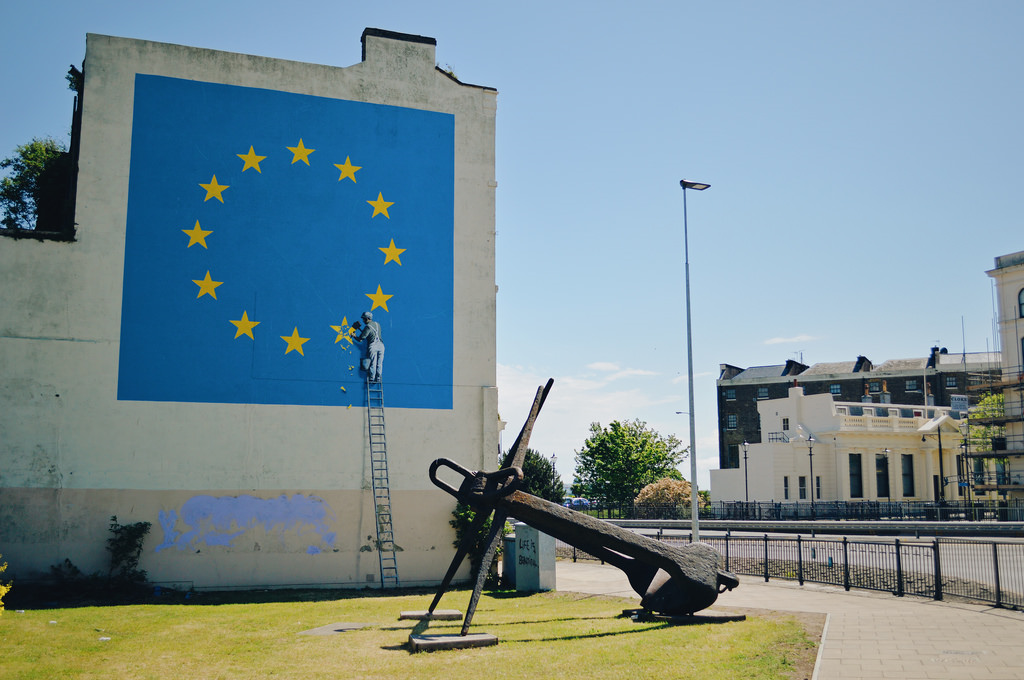
Banksy at Dover (2017)
Photo by ijclark
http://www.flickr.com/photos/mrshoes/34656221462/
attribution (http://creativecommons.org/licenses/by/2.0)
photo attribution by PhotosForClass.com
Critical Functions of Creativity
A question that may have been lost in the research focus on economics and cultural policy formation concerns the ‘critical’ function of creativity. However much we may regret its cultural pessimism, the accusation that Adorno and Horkheimer levelled against the cultural industries in their 1944 treatise Dialektik der Aufklarung (since printed in English as Dialectic of Enlightenment) still haunts us. Adorno and Horkheimer originally used the term ‘cultural industries’ to refer to industrially produced commercial entertainment – broadcasting, film, publishing, recorded music – as distinct from the subsidised ‘arts’ – visual and performing arts, museums and galleries.22
The function of ‘genuine art,’ Adorno and Horkheimer claimed, was to negate and challenge the alienation of advanced capitalism; the ‘culture industry’ merely extends the ‘administrative rationality’ of industrial production into the sphere of art and culture. The culture industries, in their analysis, deprive art of its critical function. Much of the current thinking about cultural policy, creativity and innovation seems to confirm their suspicion: creativity and innovation are described in incremental and instrumental terms as adding value that enables social and economic benefits – such as economic growth and social well-being – rather than as inherently valuable as challenges and provocations.
The historiography of the terms ‘cultural industries’ and ‘creative industries’ (which I have been guilty of using rather interchangeably in this chapter) has been richly traced elsewhere, most notably in a 2007 paper that Susan Galloway and Stuart Dunlop23 developed at the University of Glasgow’s Centre for Cultural Policy Research. The article, A Critique Of Definitions Of The Cultural and Creative Industries In Public Policy, shows that although the concept of ‘cultural industries’ was originally separate from the creative arts, it was not until the election of New Labour in Britain in 1997 (when Tony Blair became Prime Minister) that the decisive shift in terminology occurred, and the term ‘creative industries’ reached ascendance in public policy (Pratt, 2004).24 The term is, however, highly context specific – it has been widely adopted in advanced capitalist countries with a tradition of state support for culture, but has little or no purchase in the United States, “where the market place and consumer rule.”25
The other aspect of this repositioning relates to culture. Whereas ‘culture’ is abandoned as elitist and exclusive, ‘creativity’ is somehow embraced as democratic and inclusive. In most people’s eyes, the cultural industries and the creative industries are basically the same thing. However, rapid technological change (including the World Wide Web and digitalisation) has overtaken the old concept of the ‘cultural industries,’ which was more focussed on the ‘Arts’ plus commercial media (film, broadcasting, music). Thus, whereas the ‘classic’ cultural industries arose from the technological advances of the early 20th century, the creative industries are a product of the technological change of the late 20th and early 21st centuries. Originally the cultural industries – broadcasting, film, publishing, recorded music – were incorporated into cultural culture, now they have been subsumed within a ‘creative industries’ agenda of economic policy, and in the process their distinctive aspects have been obscured.
A range of values – imaginative, spiritual, aesthetic – informs discussions about creativity and innovation. For example, the idea of experimentation seems to have slipped out of the vocabulary. The “everything is creative” argument also underlies the current UK government’s approach to creative industries, which it defines as those industries that have their origin in individual creativity, skill and talent, and which have a potential for wealth and job creation through the generation and exploitation of intellectual property. I have already indicated Angela McRobbie’s anxieties about an ‘individuated’ workforce, and Galloway and Dunlop’s critique of definitions of the creative industries, but another spanner must be thrown into the works: that copyright is now viewed as the “organising principle” for the creative industries and is the basis for defining the cultural industries.
In 1982, Mike Cooley published Architect or Bee?: The Human Price of Technology. The title alludes to a comparison made by Karl Marx in Capital on the issue of the creative achievements of human imaginative power. In Architect or Bee, Cooley talks about “new technology networks” and devices for ‘socially’ useful production, and attacks the division of labour, knowledge and authority. He also asserts that we learn by doing: by exploring creativity and taking risks (a process of thinking by doing) new knowledge is generated. Indeed, he suggests that those who know what they are doing – craftspeople with skill and expertise – are those who best understand what needs to be done.26
Creativity, Cooperation and Collaboration
One way is, of course, to understand the places and spaces in which creativity can grow. Assemble winning the Turner Prize celebrates how Assemble engages with communities, and work creatively in the wider social sphere. But we also need to understand what is necessary for cooperation and collaboration to flourish. In Together: The Rituals, Pleasures and Politics of Cooperation (2012), Richard Sennett observes that we added another term to this list called dialogical: “The subjunctive mood is most at home in the dialogical domain, that world of talk that makes an open social space, where discussion can take an unforeseen direction. The dialogic conversation… prospers through empathy, the sentiment of curiosity about who other people are in themselves.”27 In fact, Searle’s commentary on Assemble in The Guardian rather concurs with this point.28
Cooperation, and indeed the very complex nature of collaboration, needs more than goodwill: it is a craft that requires skill. In modern society, traditional bonds are waning and we must develop new forms of secular, civic ritual that make us more skillful in living with others (and now living with technologies). Sennett explores the nature of cooperation from Medieval guilds to today’s social networks, exploring why it has become weak and how it can be strengthened. He argues that it needs dialogic conversation, but more than this. In terms of practical application, change requires the desire to find spaces and places: caring and trusting environments where there is time, respect for difference, and a generous capacity to listen to others whose ideas about creativity might be different from our own.
Human Creativity is ‘social’
I appreciate that for many individual artists and educators, creativity seems to be a poor substitute for imagination and the individual. Judy Millar provocatively proposes that art can be an antidote to society’s short attention span.29 She suggests that imagination (although a slippery word) encompasses far more than creative solutions. Millar believes that within visual arts, ‘artistic’ has almost been entirely replaced by ‘creative’: largely, she proposes that creativity is a marketable skill. Here, I ask for some reflection and caution – otherwise we lock ourselves in silos, cementing barriers and splitting a powerful lobby for creativity and creative thinking, which applies as much to economics as the arts. Economics went wrong when it tried to ape what economists perceived to be ‘proper’ scientific methods. In recognising that economic policy is an art, we also recognise that it needs to be a very public one. I do not assume that being creative is largely about innovation, which brings with it an assumption that the arts should serve economic ends, as Millar concludes in her final sentence of her opinion piece.
Much human creativity is ‘social’, arising from activities that take place in a social context in which interaction with other people and what they make embodies collective knowledge as essential contributions.30 The analysis of creative people and creative objects has demonstrated that most scientific and artistic innovations emerge from joint thinking, passionate conversations, and shared struggles among different people, emphasising the importance of the social dimension of creativity.31 On the one hand, interactions humans with other humans and with artefacts and tools are not only needed, but also central to social creativity. On the other hand, people participate in such collaborative inquiry and creation as individuals, and individuals need time to think and reflect on their contributions to social inquiry or creativity.32 Creativity, then, does not reside in a job description, but in social interaction, through creative individuals and collectives.
Just one question nags: where in today’s political landscape can we find the Jennie Lee to take the lead?
Footnotes
1 check #ArtsPolicy50 for a number of links to a number of different commentaries.
2 Cmnd. 2601 pars. 14, 91, 100.
3 Gary Younge, “Jeremy Corbyn has defied his critics to become Laåbour’s best hope for survival,” The Guardian, 22 May 2017.
4 Elizabeth Gilbert, 2015.
5 NPR/Ted, Where Does Creativity Come From? Ted Radio Hour, October 3, 2014.
6 Elizabeth Day, “Elizabeth Gibert: Chasing Perfection is the Enemy of all good things,” The Guardian, 27 Sept 2015.
7 Adam Phillips, Going Sane: Maps of Happiness (London, UK: Hamish Hamilton, 2005)
8 Gideon Lewis-Kraus, “Going Sane: A Mad, Mad World,” The New York Times, 2 Oct 2005.
9 Ibid.
10 (Chicago, USA: The University of Chicago Press, 2013).
11 Further examples of this can be found in Jones (1996) and Jacob and Grabner (2010).
12 Although labour under capitalism has been a topic at least since 19th century, as Marina Vishmidt explains in her article “Situation Wanted: Something about Labour,” Afterall, 19 Autumn/Winter (2008): 21–34.
13 This is explored in Eve Chiapello’s 2004 article “Evolution and Co-optation: the artists as critique of management and capitalism,” Third Text, 18(6) (UK: Routledge) 585–594.
14 Stephanie Taylor and Karen Littleton, “Art work or money: Conflicts in the construction of a creative identity.” The Sociological Review. 56.2 (2008) 275–292.
15 Anthony Giddens. Modernity and Self-Identity: Self and Society in the Late Modern Age (Cambridge: Polity Press, 1991)
16 Charles Leadbeater, “Britain’s Creativity Challenge.” Creative and Cultural Skills. Retrieved in 2007 from http://www.ccskills.org.uk
17 Adrian Searle, “Power to the people! Assemble win the Turner prize by ignoring the art market,” The Guardian, 7 Dec 2015.
18 Department for Culture, Media and Sport – DCMS, 2008; Nesta 2012.
19 Keith Sawyer, Group Genius: The Creative Power of Collaboration (London, UK: Basic Books, 2008) xiii.
20 David Throsby, Economics and Culture. (Cambridge, UK: Cambridge University Press, 2001).
21 Richard Florida, The Rise of the Creative Class and How It’s Transforming Work, Leisure, Community and Everyday Life (New York, USA: Basic Books, 2002).
22 Theodor Adorno and Max Horkheimer, “The Culture Industry: Enlightenment as Mass Deception,” extract from Dialectic of Enlightenment. (New York: Continuum, 1993).
23 Susan Galloway and Stuart Dunlop. “A Critique Of Definitions of the Cultural and Creative Industries in Public Policy.” International Journal of Cultural Policy. 13.1 (2007): 17-31.
24 A.C. Pratt, “The cultural economy: A call for spatialized ‘production of culture’ perspectives,” International Journal of Cultural Studies, 7.1 (2004) 117–128.
25 Stuart Cunningham, “From cultural to creative industries, theory, industry and policy implications,” Culturelink, Special Issue (2001) 19–32.
26 Mike Cooley, Architect or Bee? The human price of technology (London, UK: South End Press, 1982).
27 Richard Sennett, Together: The Rituals and Politics of Cooperation (New Haven and London: Yale University Press, 2012) 15.
28 Searle, op. cit.
29 With thanks to Sue and Rob Gardiner of the Chartwell Trust for the reference.
30 as in the example of Assemble.
31 Warren Bennis and Patricia Biederman, Organizing Genius: The Secrets of Creative Collaboration. Cambridge, Massachusetts, USA: Perseus Books, 1997; V. John-Steiner, Creative Collaboration (Oxford, UK: Oxford University Press, 2000).
32 Gerhard Fischer et al., 2005.
References
Adorno, Theodor and Horkeimer, Max. “The Culture Industry: Enlightenment as Mass Deception,” Extract from Dialectic of Enlightenment. New York: Continuum, 1993. Web. Retrieved from http://faculty.georgetown.edu/irvinem/theory/Adorno-Horkheimer-Culture-Industry.pdf
Belfiore, Eleonora and Bennett, Oliver. The Social Impact of the Arts: An Intellectual History. London, UK: Palgrave Macmillan, 2010. Print.
Bennis, Warren G. and Biederman, Patricia. Organizing Genius: The Secrets of Creative Collaboration. Cambridge, Massachusetts, USA: Perseus Books, 1997. Print.
Chiapello, “E. Evolution and co-optation.” Third Text. 18.6 (2004): 585-594. DOI: 10.1080/0952882042000284998
Cooley, Mike. Architect or Bee? The human price of technology. London, UK: South End Press, 1982. Print
Cunningham, Stuart. “From cultural to creative industries, theory, industry and policy implications.” Culturelink, Special Issue (2001): 19-32.
Day, Elizabeth. “Elizabeth Gibert: Chasing Perfection is the Enemy of all good things,” The Guardian, 27 Sept 2015. Web.
Department for Media, Culture and Sport (DCMS). Creative Industries Mapping Document. (1998). Web. Retrieved from http://webarchive.nationalarchives.gov.uk/+/http://www.culture.gov.uk/reference_library/publications/4740.aspx
Department for Media, Culture and Sport (DCMS). Creative Britain: New Talents for the New Economy. (2008) Web. Retrieved from http://webarchive.nationalarchives.gov.uk/+/http:/www.culture.gov.uk/images/publications/CEPFeb2008.pdf
Fischer, Gerhard. “Social Creativity: Turning Barriers into Opportunities for Collaborative Design.” In de Cindio. F. & D. Schuler, eds. Proceedings of the Participatory Design Conference (PDC04). University of Toronto, Canada, Computer Professionals for Social Responsibility (CPSR), Palo Alto CA. 2004.
Florida, Richard. The Rise of the Creative Class and How It’s Transforming Work, Leisure, Community and Everyday Life. New York, USA: Basic Books, 2002. Print.
Galloway, Susan & Dunlop, Stuart. “A Critique Of Definitions of the Cultural and Creative Industries in Public Policy.” International Journal of Cultural Policy. 13.1 (2007): 17-31. DOI: 10.1080/10286630701201657
Giddens, Anthony. Modernity and Self-Identity: Self and Society in the Late Modern Age. Cambridge: Polity Press, 1991. Print.
Gilbert, Elizabeth. Big Magic: Creative Living Beyond Fear. London, UK: Bloomsbury, 2015. Print.
Jacob, Mary Jane and Grabner, Michelle. The Studio Reader: On the Space of Artists. Chicago, USA: University of Chicago Press, 2010. Print.
John-Steiner, Vera. Creative Collaboration. Oxford, UK: Oxford University Press, 2000. Print.
Jones, Caroline. The Machine in the Studio: Constructing the Postwar American Artist. Chicago, USA: University of Chicago Press, 1996. Print.
Leadbeater, Charles. “Britain’s Creativity Challenge.” Creative and Cultural Skills. 2004. Web. Retrieved in 2007 from http://www.ccskills.org.uk
Lewis-Kraus, Gideon. “Going Sane: A Mad, Mad World.” The New York Times. 2 October 2005. Web. Retrieved from http://www.nytimes.com/2005/10/02/books/review/going-sane-a-mad-mad-world.html?_r=0
Louden, Sharon, ed. Living and Sustaining a Creative Life: Essays by 40 Working Artists. Chicago, USA: The University of Chicago Press, 2013. Print.
McRobbie, Angela. “Clubs to Companies: Notes on the Decline of Political Culture in Speeded Up Creative Worlds.” Cultural Studies. 16.4 (2002): 516-531. Print.
McRobbie, Angela. “Everyone is Creative: Artists as Pioneers of the New Economy?” In Leger, M. J., ed. Culture and Contestation in the New Century. Bristol, UK: Intellect, 2011: 23-39. Print.
Millar, Judy. “Letter from Somewhere.” Art News New Zealand, Summer. 2014: 12-48. Print and web.
Nesta. Creating growth: How the UK can develop world-class creative industries. 2006. Web. Retrieved from http://www.nesta.org.uk/publications/creating-growth
Nesta. Plan I: The Case for Innovation Led Growth. 2012. Web. Retrieved from http://www.nesta.org.uk/publications/plan-i
NPR/Ted, Where Does Creativity Come From? Ted Radio Hour, October 3, 2014. Web. Retrieved from http://www.npr.org/2014/10/03/351554044/where-does-creativity-come-from
O’Regan. Tom. Cultural policy: rejuvenate or wither. Queensland: Griffith University. 2001. Web. Retrieved from https://www.griffith.edu.au/?a=314643
Phillips, Adam. Going Sane: Maps of Happiness. London, UK: Hamish Hamilton, 2005. Print.
Pratt, A. C “Understanding the cultural industries: Is more less?” Culturelink, Special Issue (2001): 51-65. Print and Web.
Pratt, A. C. “The cultural economy: A call for spatialized ‘production of culture’ perspectives.” International Journal of Cultural Studies. 7.1 (2004): 117-128.
Pratt, A. C. “Cultural industries and public policy: An oxymoron?” International Journal of Cultural Policy 11.1 (2005): 31-44.
Pressfield, Steven. The War of Art: Break Through the Blocks and Win Your Inner Creative Battles. New York, USA: Black Irish Books, 2012.
Sawyer, Keith. Group Genius: The Creative Power of Collaboration. London, UK: Basic Books, 2008.
Searle, Adrian. “Power to the people! Assemble win the Turner prize by ignoring the art market.” The Guardian, 7 December 2015. Web. Retrieved from http://www.theguardian.com/artanddesign/2015/dec/07/turner-prize-2015-assemble-win-by-ignoring-art-market
Sennett, Richard. The Culture of the New Capitalism. New Haven and London: Yale University Press, 2009. Print.
Sennett, Richard. Together: The Rituals and Politics of Cooperation. New Haven and London: Yale University Press, 2012.
Singerman, Howard. Art Subjects: Making Artists in the American University. Berkeley, USA: University of California Press, 1999.
Steiner, V.John. Creative Collaboration. Oxford, UK: Oxford University Press, 2000.
Taylor, Stephanie & Littleton, Karen. Art work or money: Conflicts in the construction of a creative identity. The Sociological Review. 56.2 (2008): 275–292. DOI: 10.1111/j.1467-954X.2008.00788.
Throsby, David. Economics and Culture. Cambridge, UK: Cambridge University Press, 2001.
University College Dublin. (2010). All Ireland Traveller Health Study: Summary of Findings. Retrieved from https://www.ucd.ie/t4cms/AITHS_SUMMARY.pdf
Vishmidt, Marina. “Situation Wanted: Something about Labour.“ Afterall, 19 Autumn/Winter (2008): 21-34.
Essays
Aspirants
I
In November 2015, as chief curator for Fundación Alumnos47 in Mexico City, I invited Erick Meyenberg to create a piece for Proyecto Líquido. Desire. Proyecto Líquido uses diverse curatorial formats and aesthetic experiences to investigate the production and exchange of affections as axes of existence that provoke imaginary and tangible operations. Proyecto Líquido. Fear, 2012, focussed its interest on the fields of action indicated by these operations, and on their aesthetic, poetic and political consequences. Through the hybridisation of media, genre subversion and live art, Proyecto Líquido. Desire, 2016, continues this investigation through the commissioning of 11 artworks in public spaces of the Basin of Mexico, by artists Ale de la Puente, Tania Candiani, Erick Meyenberg, Sam Durant, Dr. Mayeski and The Luminous Resistance, Noé Martínez and María Sosa, Interspecifics, Bettina Wenzel, Wen Yau, Mariana Castillo Deball and Carlos Sandoval and Pablo Helguera.1
“We have never given a permission like this before.”2 Aspirants was a filmed performance at the ancient pyramid site of Teotihuacan, 4o minutes outside of Mexico City: a sound and video installation, with around 200 young men, that played on the double meaning of aspiration:
- to long, aim, or seek ambitiously; be eagerly desirous, especially for something great or of high value (usually followed by to, after, or an infinitive):to aspire after literary immortality; to aspire to be a doctor.
- to rise up; soar; mount; tower.3
Proyecto Líquido. Desire worked around many legal and administrative loopholes, and took place in sites where contemporary art had never been presented before. With Aspirants, the curatorial and production team managed to gather a group of young men who aspired to be football players, soldiers and drug dealers, to perform the exercise of inhaling and exhaling in front of the Pyramid of the Moon.
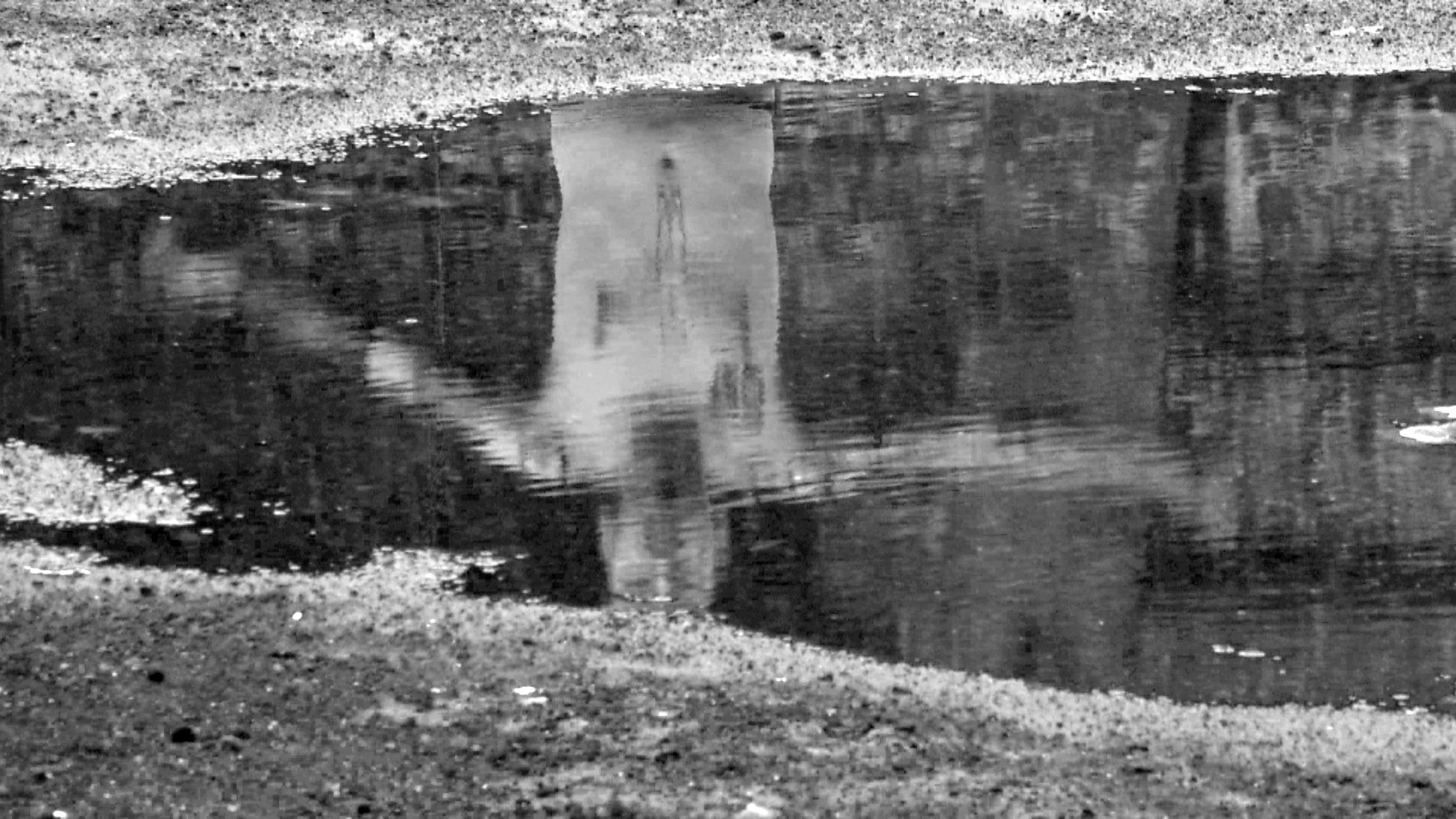
Erick Meyenberg, Aspirants, 2016. Video, 40 seconds, loop.
Filmed action in Teotihuacan for Proyecto Líquido. Desire.
Still taken from video by Julien Devaux.
Images courtesy of Fundación Alumnos47.
II
‘It is estimated that around 200 individuals were sacrificed
at the same time on the occasion of the construction of the temple.
The majority of male skeletons have been interpreted as warriors.4
On November 9th, 2016, around 200 young Mexican men lined up on the Avenue of the Dead in front of the Pyramid of the Moon in Teotihuacan. An anticipant army. A choir of wet, mutant, preconscious aspirations. On that day, an epistemic mechanism was formulated generating deeply affective experiences in our contemporary warriors, the sacrificed, whose audacity and radicalism are tattooed on their chests close to the heart, in that tiny fold where desire lies hidden. Histories converged of men from a country whose myths no longer justify the disposal of souls, bodies and dreams. There no longer exists any ritual or bloodshed that becomes epic.
Coming from different areas of Mexico City, these men bring all kinds of experiences from the hazardous, precarious socio-economic conditions in which many live, along with their aspirations. In the Plaza of the Moon, they form an image that dislocates, in the national and international imaginary, the place this architectural complex has occupied for hundreds of years. While maintaining the militaristic nature of the Teotihuacan elite, the natural and artificial geometry of a space that contains other stone and organic bodies was experienced. Sky, hill, pyramid, human bodies in sequence and synchronism. A plane that devours its predecessor in a collective sentence that escapes to infinity.
We seek to add immaterial value to the dream of aspiring to a Mexico aware of its reality and its history.5
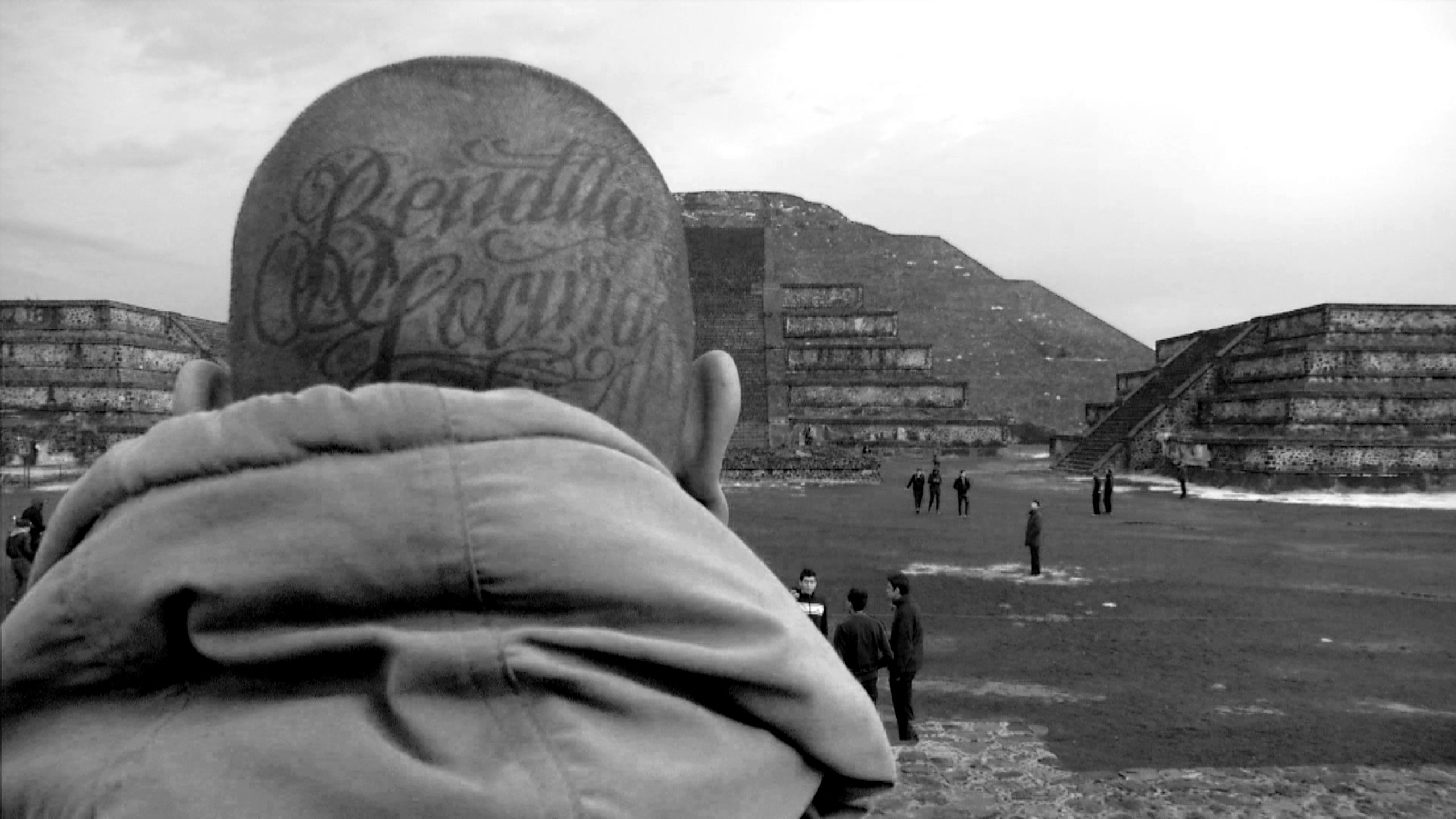
Erick Meyenberg, Aspirants, 2016. Video, 40 seconds, loop.
Filmed action in Teotihuacan for Proyecto Líquido. Desire.
Still taken from video by Julien Devaux.
Images courtesy of Fundación Alumnos47.
III
Citation is a strategy that, through accumulation, works as a way of constructing histories and identities, by mobilising affects via narratives that can produce consensus or emphasise difference. Who we reference and who we acknowledge creates a political grammar that renders thought and knowledge visible. An interlocking of subject, time and place, evidence of the productiveness of intellectual and artistic labour, saturated with epistemological-ontological tension.6 Who said did what when. Citation practices provide frames of reference and legibility; they can be dedications and critical tributes that come from annotations and unfold into variations of the textual, the visual and the sonic. Yet, through repetition and not appropriation, citation can also blur its own skills for selection and interpretation, and fall into a dominant mode of citation practice: precluding disruptions necessary for the practical and theoretical shifts that lead to creative processes. Can one experiment creatively with citation, explore this epistemological-ontological tension that reveals power structures within any form of production? The following is an exercise in citation. I pile them up under the text itself in order to try and produce a second body of meaning. I try to use citations—as many as I can find in Erick Meyenberg’s artwork Aspirants, as well as citations the artist pulled together for the film we created, a 40-second loop—as a stratigraphic activity,7 as descriptive of a coming together of authorship, times and places. Of psycho-political and spiritual operations. Citation here, I propose as a writer, with thanks to the artist’s work, is a permeable structure of cultural imagery that can gather the forces needed to expose hidden ideological agendas. It all depends on who reads these citations, when and where—subject positionality changes everything. This stratigraphic activity of citation builds metaphors that may escape the image of Aspirants, metaphors that overflow and become excess, residue that may or may not become a narrative. Conscious citation practices offer new structures for historical events. They produce ‘something’: affect, materiality, relations, presentness, orientations, positions, attitudes. ‘Something other than.’ They are indications of accumulated social pulses. Citations are proof of circulation, of interrelatedness, of habits of thought or manifestations of discomfort, of doubt and vulnerability, of autonomy or of the pillars which convenience leans. Citations pile up everywhere, as past intensities and textures of the social mingle with the confusions of everyday materiality.
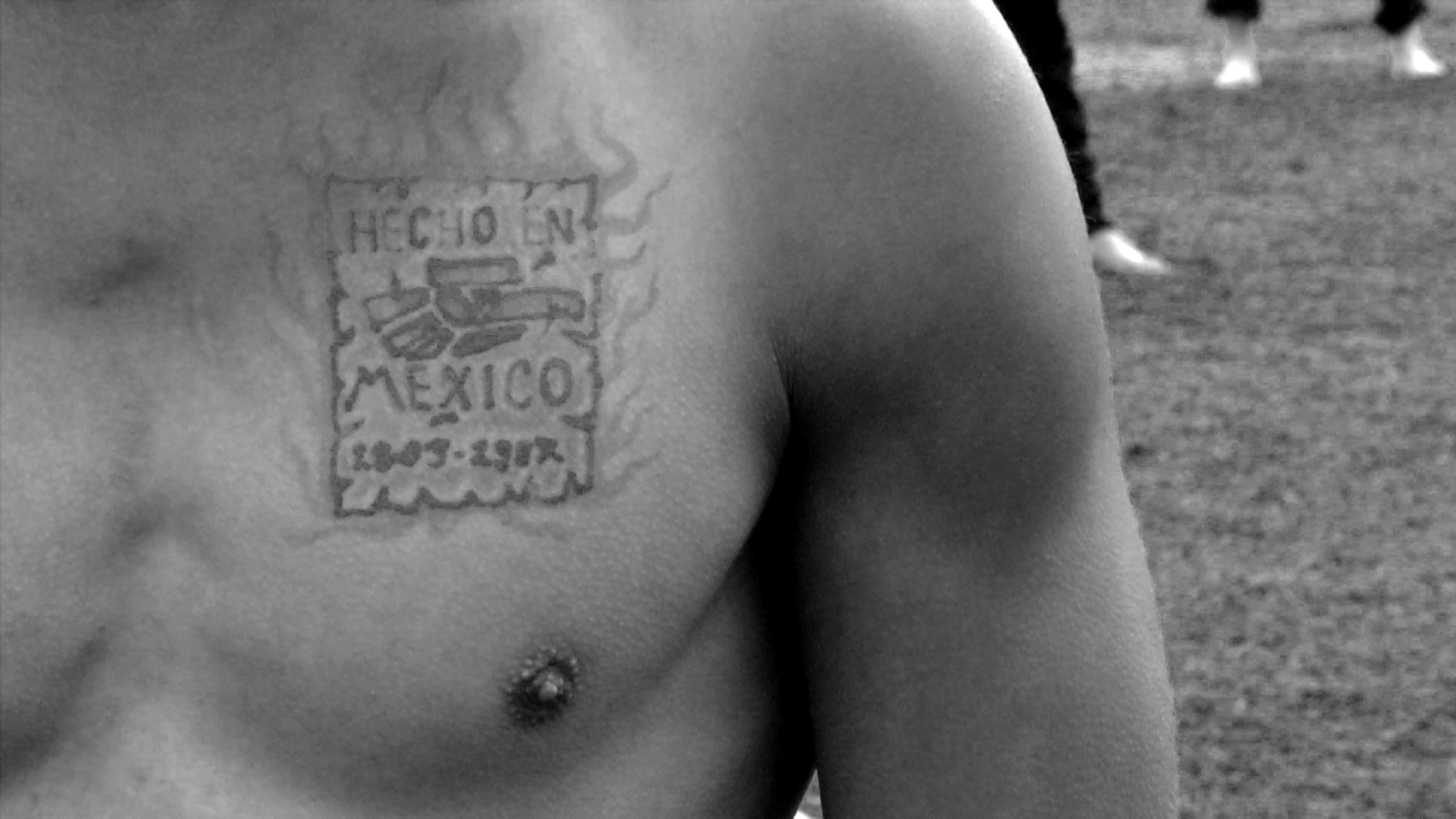
Erick Meyenberg, Aspirants, 2016. Video, 40 seconds, loop.
Filmed action in Teotihuacan for Proyecto Líquido. Desire.
Still taken from video by Julien Devaux.
Images courtesy of Fundación Alumnos47.
IV
Citation is a practice I believe is related to what Craig Owens calls “the allegorical impulse.”8 A gap connecting past and present, where textual, visual and sonic memories are preserved and come forward. Adding through replacement of meaning by doubling texts, images and sound. To unfold and momentarily reveal the dissolution of meaning, the tiger’s leap,9 only to double back over. Transparency of signification or not, we are left estranged, left with fragments and ruins to be deciphered. Every image of the past that is not recognised by the present as one of its own concerns threatens to disappear irretrievably.10 Technique, perception, procedure. Reading one text through another. Fragmentary, intermittent, chaotic. Material depth. Through the frequency of citation, time is altered, metaphors are created and sometimes interrupted during their formation to advance something else. Longing, expectation, déjà vu. Familiarity through the overlapping of past and present. Also déjà vécu: having lived through something via the anticipation of that something. Images become other, pure potential, unstable and hopefully unpredictable. Through the reading of citation, another possible artwork is being formed. Otherness. Synchronicity of meaning. Citation varies perception and recognition. And works with density, as an element that allows to draw a network of relations between artists of different generations living in different countries; and adversity, a state of existence that connects artistic production with history and its local conditions. Citation can work here to question those relations and connections, producing open-ended debates. Citation practices are beckoned by ethics and, if congruent, may evoke the beauty within connectedness of thought, within pronouncement and announcement after borrowing, and the impact of taking from and making it your own.

Erick Meyenberg, Aspirants, 2016. Video, 40 seconds, loop.
Filmed action in Teotihuacan for Proyecto Líquido. Desire.
Still taken from video by Julien Devaux.
Images courtesy of Fundación Alumnos47.
V
Past11 and present combined to mirror12 the future. Time is distended into aligned bodies. Instances of mutation through inhalation, exhalation. Sky,13 hill,14 pyramid,15 human formation. Isolated coding producing estrangement. One paradigm for the allegorical work is the mathematical progression.16 Anticipation and desire biting into each other. Ouroboros or the feathered serpent.17 Architecture,18 landscape painting,19 film and performance falling and folding into each other. Like the breath: ascending, pausing, descending. As a wound that reveals the unravelling of its own suture. “… the crack being the very essence of human sensuality, it is what drives pleasure. Likewise, when we perceive death, our breath is taken away, in some way, at the supreme moment, we stop breathing.”20 “Allegory concerns itself, then, with the projection - either spatial or temporal or both of structure as sequence; the result, however, is not dynamic, but static, ritualistic, repetitive.”21 “What happened did indeed happen, but there is something that only happens if it happens in full, perpetual present in rotation.”22 “Allegory superinduces a vertical or paradigmatic reading of correspondences upon a horizontal or syntagmatic chain of events.”23
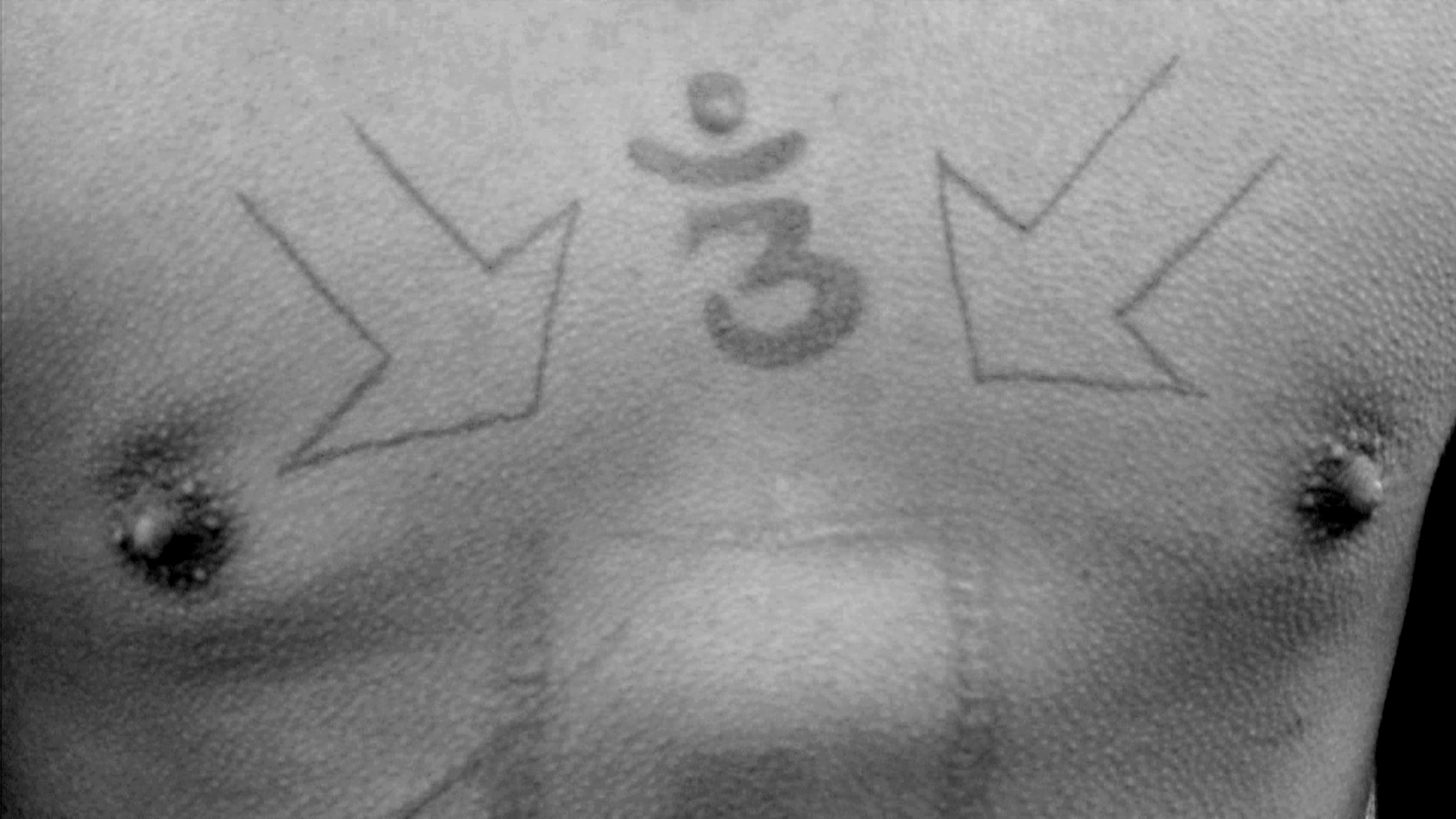
Erick Meyenberg, Aspirants, 2016. Video, 40 seconds, loop.
Filmed action in Teotihuacan for Proyecto Líquido. Desire.
Still taken from video by Julien Devaux.
Images courtesy of Fundación Alumnos47.
VI
Alejandro Sarabia and Natalia Moragas note: “Teotihuacan is one of the most important archaeological sites in Mesoamerica. Scientific investigations on the site have opened the way to knowledge about and understanding of, the different social processes involved in, for example, the economic, urban, political, architectural areas during the development of the Early Formative period in America.”24 This influence determined the social structure of diverse cultural fields throughout the Classical and Post-Classical eras in the Mexican Altiplano that affected the organisational apparatus of succeeding civilisations, creating an imaginary of pre-Hispanic civilisations that extends to the present-day and forms part of the strong rise of national identity.
Teotihuacan therefore interests us as an area in which to deepen, through art and education, our understanding of these social processes that have shaped both the identity and visual representations of a society located in the Basin of Mexico. A group of young Mexicans and their different aspirations – aspirations directly linked to the social, economic, religious, cultural and political history of the Basin of Mexico, and to Teotihuacan as the centre for the production of knowledge, power and identity – are the means by which this interest may be fulfilled.
Teotihuacan and the Pyramid of the Moon permit a more profound look at the history of this ancient city and a closer analysis of its significance to contemporary Mexico. We are reviewing the Spanish chronicles of Fray Bernardino de Sahagún, Fernando de Alva Ixtlilxóchitl, Francisco Javier Clavijero and Fray Juan de Torquemada, of travellers and scholars such as Humboldt and Madame Calderón de la Barca, of Charnay, Chavero and García Cubas, together with modern archaeologists such as Leopoldo Batres, Manuel Gamio, Alfonso Caso, and Jorge R. Acosta. We are also revising more contemporary research led by Saburo Sugiyama, Leonardo López Luján, Rubén Cabrera and Lina Manzanilla, among others. We need to understand the year 1917 as a key moment in time when past and present were integrated into an anthropological project with the founding of the Department of Anthropology by Manuel Gamio for the interdisciplinary study of the ancient and contemporary population of the Valley of Teotihuacan. This is essential to our artistic proposal, our goal also being the transdisciplinary (art, education, history, anthropology, philosophy and archaeology) integration of the past and present into one work of art, thus significantly contributing to the production of our country’s cultural heritage through serious study and inter-institutional collaboration.
Much has been written about the different types of research on the Basin of Mexico – architectural, urban, social, anthropological – for generating urban, social, political, public law, participatory development programs, projects, etcetera. In addition to generating government policies for solving current needs and emergencies in the area, the Basin of Mexico also embodies experiences and the ways in which public, urban and cultural policies, in the exercise of human action, are manifested.
All these actions shape the landscape of the Basin of Mexico. The clear manifestations of the image that is projected in public spaces show the effect of these actions. Inhabiting a city is the effect of modelling space and constructing the landscape according to the image of our desires, our policies and our dreams. The construction of a landscape requires the ability to stimulate the image of a desire and make it a reality.
Proyecto Líquido. Desire evolves from this condition: to catalyse our image in space, to build a landscape that measures up to our desires. An understanding of artistic action and artwork as reflections of desire in the space we inhabit, represented through a series of works of art presented in public spaces within the Basin of Mexico.
Taking as one of our references the academic article by Alejandro Sarabia and Natalia Moragas on the investigations carried out at Teotihuacan, we propose a project that integrates history, archaeology, identity, the building of a nation, youth, and our historical present: “To speak of Teotihuacan is to consider the development of the socio-political complexity, consolidation and development of the urban phenomenon, the expansion of the ideology and the religion of a culture into a macro-regional concept, the design of long-distance trading networks, and other issues.”25
Over a century after its foundation, the ancient city of Teotihuacan has created an identity defined by its architecture and nourished by the experience of living in it; the organisation of this city with its talud-tablero composition establishes the vision of an infinite path, an organisation, and a type of orderly thinking. The Avenue of the Dead, located South to North, makes up the cosmology of the ancient inhabitants in the landscape of Teotihuacan. At the end of the Avenue lies the Plaza of the Moon whose principal architectural structure is the Pyramid of the Moon. Framed by the natural landscape of the area, the pyramid was built during the Tzacualli phase and is oriented and aligned towards the Cerro Gordo Mountain.
José María Velasco, Pyramid of the Sun, 1878. Oil painting.
Painted from the Pyramid of the Moon in Teotihuacan, Mexico.
On display at the National Museum of Art, Mexico City.
Image courtesy of MUNAL (Museo Nacional de Arte).
The event we are proposing involves filming 200 people in a pyramid formation, within the Plaza of the Moon, mirroring the Pyramid of the Moon. The reason we want to work in Teotihuacan is as follows: our interest in the site stems from our desire to deepen, through art and education, our understanding of the social processes that have shaped the identity and visual representations of a society located in the Basin of Mexico. A group of young Mexicans and their different aspirations – aspirations directly linked to the social, economic, religious, cultural and political history of the Basin of Mexico, and to Teotihuacan as the centre for the production of knowledge, power and visual culture – are the means by which this interest may be fulfilled. We seek to add immaterial value to the aspirations of a Mexico that is aware of its reality and its history. We are also interested in developing, in our team of 200 applicants, knowledge about and awareness of what was and what is Teotihuacan.
The Pyramid of the Moon comprises seven superimposed buildings decorated with ritual and sacrificial deposits that celebrate and consecrate each new stage in the construction of the pyramid. These findings lead to a reconsideration of the systems of government and religion at Teotihuacan. Anthropologists, Lawrence Sugiyama and George L. Cowgill (who is also an archaeologist), are two important references for the project due to their in-depth investigations into the architecture-landscape-body relationship, and we are interested in exploring their ideas about ritual and sacrifice from a contemporary perspective.26 Both these researchers mention the importance of young men to the consecration of the city.
Part of our research is also based on the ideas of Octavio Paz in relation to the Mesoamerican pyramid:
The geometric, symbolic representation of the cosmic mountain was the pyramid. The geography of Mexico tends towards the form of a pyramid as if there existed a secret but obvious relationship between natural space and symbolic geometry, and between the latter and what I have called our invisible history… the pyramid is an image of the world; at the same time that image of the world is a projection of human society. If it is true that man invents the gods in his own image, then it is also true that he finds his likeness in the images that the sky and the earth offer. Man makes the human landscape human history; nature converts this history into cosmogony, the dance of the stars.27
Besides the experience of living in it, Teotihuacan is nourished by the discoveries, documents and research by historical figures such as Leopoldo Batres, Lorenzo Boturini, Brantz Mayer, Antonio García Cubas, Manuel Gamio, Gumersindo Mendoza, and José María Velasco, among others. Velasco documents the area for scientific purposes, but the results of his documentation built a vision of the landscape as a symbol of identity, still strong, that became a myth of nation. For Erick Meyenberg, the artist, and for me, the curator and researcher, Velasco’s landscapes in the Museo Nacional de Arte (National Museum of Art in Mexico) have fed the vision for our project. In 2012, Dr. Peter Krieger, renowned researcher at the Instituto de Investigaciones Estéticas, Universidad Nacional Autónoma de México (Institute of Aesthetic Research, National Autonomous University of Mexico) published Transformaciones del paisaje urbano en México. Representación y registro visual (Transformations in Mexico’s Urban Landscape. Representation and Visual Record), in which he reconstructs the history of our city and part of the Basin using carefully selected visual material from the National Museum’s Foundation.28 In this reconstruction or eco-history, José María Velasco’s visual investigations are an essential part of modernity’s imprint on the landscape of the Basin.
Just as Velasco’s aesthetic and scientific views on the area provide us with information, the landscape and perspective of nationalism later resulted in the creation of a new way of visualising the area. Artistic expression in the late 19th and early 20th centuries through the middle of the 21st century asserted its influence on Mexican cinema, which is why another fundamental reference for the aesthetic research of our proposal is cinematographer Gabriel Figueroa’s work:
I think that by incorporating cinematic photography into the Mexican visual arts movement, I incorporated the Mexican landscape in the form of the equilibrium, chiaroscuros, skies and dramatic clouds that we have here, and all that in the service of cinematography in order to obtain a very Mexican image in black and white photography...29
Figueroa’s visual shots assert the type of influence and aesthetic created by the artistic movements of the time, and highlights man’s desire to situate his longings within a framework comparable to nature. Figueroa extols a vision of Mexico, filled with desolate spaces that reverberate with nationalist tones. Obsessed with the emblematic, he brings together visual rhetoric and national discourse. This visual discourse is largely fed by the desolate landscape of the Mexican imaginary. Figueroa’s cinematography is placed at the service of the construction of the national imagination similar to the landscapes that Velazquez painted of Teotihuacan. The eye feeds the vision that man has of the world, the perspective held by inhabitants of the Basin during that time regarding their identity and their geographical, political and cultural relationship to the Basin of Mexico. Thus, Erick Meyenberg seeks to comment on the construction of the identity of this region, the Basin, by means of these four axes outlined for the creation of a nation: history, landscape, city-state (Teotihuacan), and film, as the building blocks of myths.
The artist reflects on the construction of the Pyramid of the Moon in reference to the Cerro Gordo mountain because, in addition to being thought of as a construction that alludes to the goddess of water and fertility, it is, from an aesthetic viewpoint, a construction that is clearly linked to the geography of the place. This type of construction, friendly towards and consistent with the landscape, indicates the strong connection that the ancient peoples had with their environment. The amount of effort required to build such a monument only registers when you think of the time it took and the number of men needed to perform such a feat. This artistic action is related to the desire of all men to build and modify their territory.
The proposal consists of a film recording of the group of 200 young men in formation in front of the Pyramid of the Moon: the youths, there by direct invitation, will be filmed performing the subtle action—inhalation and exhalation—that opens up enquiries into desire, and the aspirations of the youth of our country. The image pays homage to the site and its importance in our contemporary lives. It is also an image of the identity of the young people of Mexico: one that stems from the ancient inhabitants, architecture, geography and landscape, juxtaposed with the need to make visible their aspirations for a better life. To quote Paz: “Living history as a rite is our way of accepting it.” This is what we want to achieve. A ritual that speaks of our history.
Rarely does an artist have the opportunity to present their work in a space so full of tradition and history. This film prioritises the tangible heritage and therefore Teotihuacan will not be affected. We are sure this will be a unique piece of work in the history of Mexican art by recognising and paying tribute to this unique site, and promoting the preservation of the historical, symbolic and cultural memory of our country.
VII
Filmed action Aspirants30
The project seeks to compile the aspirations31 of young Mexican men through a film that demonstrates the violent and precarious conditions experienced by the Mexican population today. At the same time, the film highlights their desires and dreams for a better life.
Profile
200 Mexican men between 18 and 25 years of age who live in Mexico City and the hazardous socio-economic conditions of the metropolitan area; men who hope to find more security through drug trafficking.
VIII
To all participants32
At a time such as the one we are living in today, in a country like Mexico where citizens ‘disappear,’ we need young people who, through their presence and attitude, make the population of Mexico aware of the reality and urgency of their desires and aspirations for a better life; and we want to bring everyone together to make this clear once and for all.
The symbolic action you are about to perform, and we would like to say how deeply grateful we are for your presence and participation, will attempt to unite this collective dream. However symbolic it may be, it requires real people with real intentions, and this is the reason why we have summoned you all here. We ask for your total concentration and that during the filming you focus your mind and body on that dream of a better life to which each one of you aspires. May the conviction that change is possible be perceived throughout your whole body!
The intention of this small action is to relate the history of our country to the present, to you. It involves a military formation in front of the Pyramid of the Moon and the convocation of a collective breath, referencing an army of young men from Teotihuacan who were all sacrificed at the same moment hundreds of years ago.
Please do not overestimate the magnitude of small actions. However simple they may seem, we are convinced that this small action will arouse deep reactions in the people who see it. But in order to achieve this result as powerfully as possible, we need your complete cooperation, your absolute concentration, and for you to work together as a great team, as a great army.
We have nothing further to say other than thank you for your decision to participate, and we hope that this will also be a great experience for you, as it already is for us.
Many thanks to everyone,
Erick Meyenberg and the team at Fundación Alumnos47
IX
Aspiration Exercise
By Nadia Lartigue (Choreographer).
The exercise consists of breathing together. It’s very simple, but as we will be close to 200 bare-chested people, we must try to synchronise our breathing. A person will be in front to help guide the action and tell you when to inhale (lift the arms) and when to exhale (lower the arms).
Below is a brief description of the action.
Initial or neutral position
Standing, legs slightly apart (just past shoulder height), arms held down the length of the body with the palms of the hands turned towards the thighs. Looking to the front, a serene and present face. Lips relaxed.
Exhalation (10 seconds)
The next time you inhale, slowly let the air out through the slightly-open mouth, producing a subtle blowing sound between the lips while imagining a thread of smoke coming out. This movement is accompanied by the gaze moving diagonally down to the front and down (45o) as you exhale. Relax the shoulders and let them drop gently forward, feeling how your hands fall five to 10 cm down along your thighs.
Inhalation (10 seconds)
Imagine that the air is coming from your feet and going up to your head. Begin to slowly draw in air through the nose, counting up to 10 seconds. During that time, inflate the ribs and chest upwards and sideways while bringing your gaze up from diagonally down and to the front to diagonally up and to the front (45o). Your shoulders open (without raising them up to your ears), while the expression of your eyes is that of someone looking at the distant horizon with great seriousness and conviction.
Try to hold the air up for another five seconds without moving and with a very firm expression.
Repeat the exhalation and inhalation for 10 seconds.
When everyone inhales and exhales at the same time, we will attain the image of one single body that breathes and generates one same energy.
Aspirants
The exercise consists of breathing together. It’s very simple but, as we will be around 200 bare-chested people, we must try to synchronise our breathing.33
One of Erick Meyenberg’s aspirations was to create, through his art piece, an environment of sound through 200 men breathing, inhaling, and exhaling in unison. Though it seemed like a simple action, it brought 200 young people to where the Avenue of the Dead ends. It is a simple action that leaves something inside your body: a desire, a dream, a failure or an aspiration. An aspiration that is sown within the breast of each of these men; a symbolic action that begins with a discourse on a generation’s circumstance, and evolves into an assertion of the will’s desire.
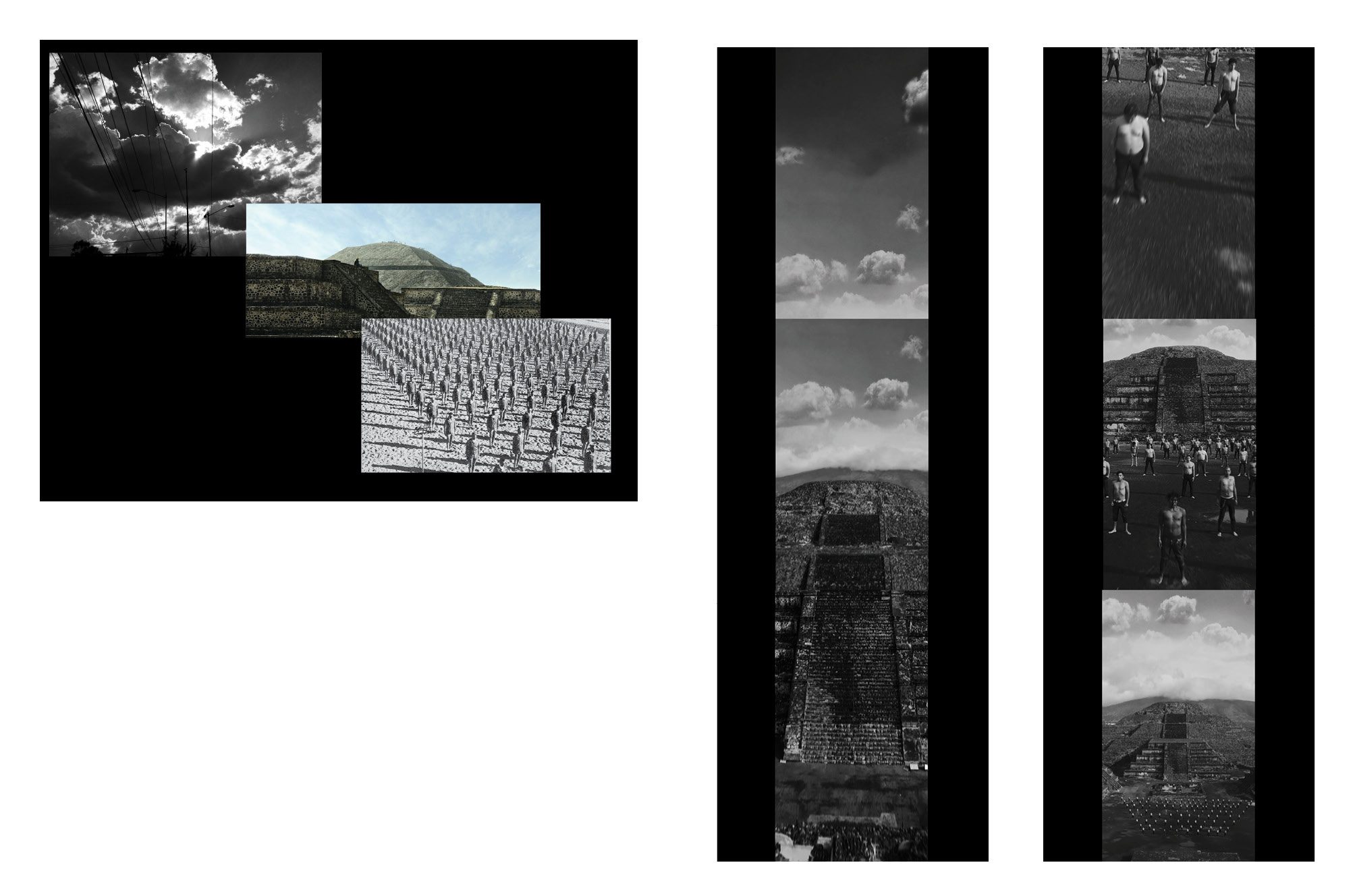
Top
Erick Meyenberg, images taken from Google for open call in October 2016.
Right
Erick Meyenberg, Aspirants, 2016. Video, 40 seconds, loop.
Filmed action in Teotihuacan for Proyecto Líquido. Desire.
Stills taken from video by Julien Devaux.
Images courtesy of Fundación Alumnos47.
Footnotes
1 Jessica Berlanga Taylor, Curatorial statement of Proyecto Líquido. Desire.
2 The lawyer from The National Institute of Anthropology and History (INAH in Spanish) who handed me permission to film in Teotihuacan.
3 From http://www.dictionary.com/browse/aspire.
4 Rubén Cabrera Castro, Saburo Sugiyama, George Cowgill, “The Templo de Quetzalcoatl Project at Teotihuacan: A preliminary report.” Ancient Mesoamerican No. 2 (EUA: Cambridge University Press, 1991) 77-92. Translated into English by Susan Taylor.
5 Erick Meyenberg and Jessica Berlanga Taylor, curatorial text by Jessica Berlanga Taylor for the exhibition of Aspirants in February 2017. Translated into English by Susan Taylor.
6 Claire Hemmings, Why Stories Matter: The Political Grammar of Feminist Theory (Duke University Press, 2011) 26.
7 Douglas Crimp, “Pictures,” October vol. 8 Spring (USA: MIT Press, 1979) 87.
8 Craig Owens, “The Allegorical Impulse: Toward a Theory of Postmodernism,” October Vol. 12 Spring (USA: MIT Press, 1980) and Charles Harrison, Paul Wood, Art in Theory. 1900-2000. An Anthology of Changing Ideas (Oxford: BlackWell Publishing, 2002).
9 Walter Benjamin, “Theses on the Philosophy of History” in Owens, 1029.
10 Benjamin, in Owens 1025.
11 The archaeological site as evidence of a social formation that resonates today through complex issues of race, class and gender. “Furthermore it is of their heirs and successors: Viceroys, Serene Highnesses and Presidents. And there is something else: it is the view point of the vast majority, of the victims crushed by the pyramid or sacrificed on its platform-sanctuary. The critique of Mexico begins with the critique of the pyramid.” By Octavio Paz, El laberinto de la soledad: Postdata, Vuelta a El laberinto de la Soledad, 3ª edition (México: FCE, 1999) 305. Translated into English by Susan Taylor.
12 A mirror probably made from polished obsidian, deep black volcanic glass. These were the mirrors used in Teotihuacan and the Basin of Mexico. Reflections of oneself through black, death.
13 Gabriel Figueroa, Mexican cinematographer famous for creating “The Mexican Sky”: big, white cloud formations contrasted by the sun’s strong illumination, floating in immensity. Sighted (cited in) for Aspirants.
14 In ancient Mexico’s cosmogony, pyramids and the surrounding hills and mountains were deeply connected. They echoed each other, integrating landscape and architecture. The Pyramid of the Moon in Teotihuacan is aligned and oriented towards the Cerro Gordo.
15 The drone and its camera traverse the stone structure dark and wet from previous rain, a round eye searching for myth, creating vastness, a black hole almost, through its emphasis on the rugged surface.
16 Owens 1028.
17 Quetzalcoatl, the feathered serpent and the most important god in Mesoamerican cultures. Quetzal means bird, and is appreciated for its beautifully-coloured feathers. Coatl means serpent. Sky and earth bound together. Every other god and goddess unfolds from Quetzalcoatl, as they are citations of this first deity.
18 Ancient Pyramid of the Moon in Teotihuacan, Mexico.
19 José María Velasco, Pyramid of the Sun, 1878. Oil painting. Painted from the Pyramid of the Moon in Teotihuacan, Mexico. On display at the National Museum of Art, Mexico City.
20 Georges Bataille, Erotism, 2nd edition (Mexico: Tusquets Editores, 2011) 111. Translated into English by Susan Taylor.
21 Owens 1028.
22 Paz 290.
23 Owens 1028.
24 Natalia Moragas and Alejandro Sarabia, Teotihuacan, http://pendientedemigracion.ucm.es/info/arqueoweb/pdf/8-2/moragas.pdf: p. 1. Translated from Spanish into English by Susan Taylor.
25 Moragas and Sarabia.
26 Publications such as George L. Cowgill, Ancient Teotihuacan: Early Urbanism in Central Mexico, (New York: Cambridge University Press, 2015), and Lawrence Sugiyama, in Aaron D. Blackwell, “Is human self sacrifice adaptive? A mathematical examination of cultural, ecological, and demographic variables contributing to suicidal self-sacrifice in humans,” Human Behavior and Evolution Meetings, Williamsburg, VA, 2007.
27 Paz 294.
28 Peter Krieger, Instituo Nacional de Bellas Artes, Mexico, 2012.
29 Gabriel Figueroa in Las profecías y los espejismos de la imagen in http://www.nexos.com.mx/?p=12549. Translated into English by Susan Taylor.
30 Open call sent out in September and October 2016.
31 The action will consist in asking them, when in group formation, to take deep breaths for eight to 10 seconds while the camera films them and the surrounding area.
32 Letter from Erick Meyenberg to participants, November 9th, 2016.
33 Nadia Lartigue, in a text introducing a performative action to close to 200 young men from different geographical areas of Mexico City.
References
Bataille, Georges. Erotism. 2nd edition. Mexico: Tusquets Editores, 2011. Print.
Cabrera Castro, Rubén, Sugiyama, Saburo, and Cowgill, George. “The Templo de Quetzalcoatl Project at Teotihuacan: A preliminary report” Ancient Mesoamerican No. 2. EUA: Cambridge University Press, 1991.
Crimp, Douglas. “Pictures,” October Vol. 8 Spring. USA: MIT Press, 1979. Print.
Cowgill, George L. Ancient Teotihuacan: Early Urbanism in Central Mexico, (New York: Cambridge University Press, 2015).
Figueroa, Gabriel. Las profecías y los espejismos de la imagen in http://www.nexos.com.mx/?p=12549. Translated into English by Susan Taylor.
Harrison, Charles, and Wood, Paul. Art in Theory. 1900-2000. An Anthology of Changing Ideas. Oxford: BlackWell Publishing, 2002. Print.
Hemmings, Claire. Why Stories Matter: The Political Grammar of Feminist Theory. Duke University Press, 2011. Print.
Krieger, Peter. Instituo Nacional de Bellas Artes, Mexico, 2012.
Owens, Craig. “The Allegorical Impulse: Toward a Theory of Postmodernism,” October Vol. 12 Spring. USA: MIT Press, 1980. Print.
Paz, Octavio. El laberinto de la soledad: Postdata, Vuelta a El laberinto de la Soledad. 3rd edition. México: FCE, 1999. Print.
Moragas, Natalia and Sarabia, Alejandro. Teotihuacan, http://pendientedemigracion.ucm.es/info/arqueoweb/pdf/8-2/moragas.pdf: p. 1. Translated from Spanish into English by Susan Taylor.
Sugiyama, Lawrence, in Blackwell, Aaron D. “Is human self sacrifice adaptive? A mathematical examination of cultural, ecological, and demographic variables contributing to suicidal self-sacrifice in humans,” Human Behavior and Evolution Meetings, Williamsburg, VA, 2007.
Exhibition
SOMETIMES I REPEAT MYSELF
The sensation of recollection and memory is exceptional, in that, when a recollection or a memory surfaces, it seems to do so on its own accord and on its own terms. One either remembers or one does not. The same may be said of familiarity, the triggers of the return often unexpected and unexplained, providing comfort or, alternatively, met with disquiet. Then there are the things that we try to remember, as well as those that we try to forget — the latter, an exercise consigned to failure in the attempt — in a desire or compulsion to return to the scene, to replay it or to remind one’s self.
SOMETIMES I REPEAT MYSELF
Presented in the following pages are the contributions of artists invited to respond directly or indirectly to remembering, forgetting, reminding, repetition, fear of forgetting, trying to forget, past lives, and the things that dog one, intentionally or otherwise. Just as in recollection, memory, and familiarity — where the sensation and its arising appear as if of the thing in itself — these contributions are developed for or presented with the form and dimensions of the journal in mind, reflecting a consideration of the experience of the image or a correspondence with its source, as well as its reproduction and dissemination. Producing, as such, a showcase that is exactly what it is: a journal section of and for recall.
Weixin Quek Chong
Singapore
android fallacy fantasy
digital photographic image taken with Sony Xperia M4 Aqua, 2017.
The mobile phone (handheld, android always android) is my repository, the replaceable sensorial prosthetic, the container and concordance of the remembered / reconstructed… When a phone dies suddenly, I mourn the loss of text-image-triggers, encodings of Past / Present / Future and the repeated re-call or revisitation of these ghosts.
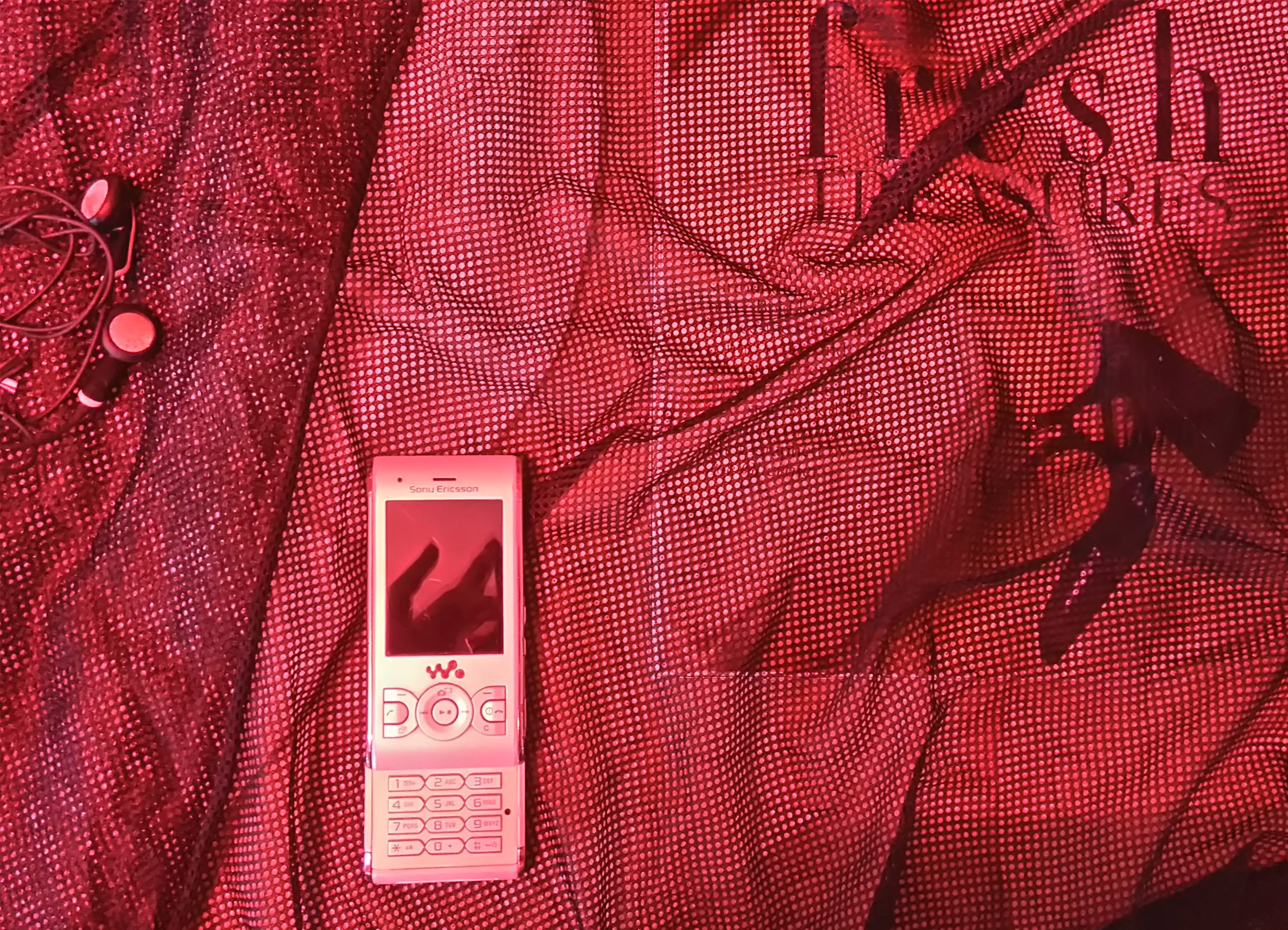
The way thoughts are spread across these different devices ensures their fragmentation
Who will be able to put together the pieces of someone else’s notes?
My brain the (organic matter) key to my soul spread across these devices; among their hardwire
SIM storage memory cards lie the pieces of what I am, the sensations sensed by this bodily extension
(when they don’t work anymore) what is left are retrieved hard drives, transferred file ghosts.
Nothing
is a thing that you can lean on, Nothing will hold you,
Nothing will regenerate your flesh
Anouk Kruithof
Born Dordrecht, The Netherlands. Lives and works in Mexico City.
#EVIDENCE
2015
#Evidence draws from Kruithof’s research of the Instagram output of 27 corporations, 15 government agencies and 11 institutions in America — images with clear promotional intent and thus questionable veracity. Twisting, altering, stretching and combining selected screenshots of this source material, Kruithof claims the imagery as her own, robbing it of its promotional intent, and adding new, varying intentions and messages.
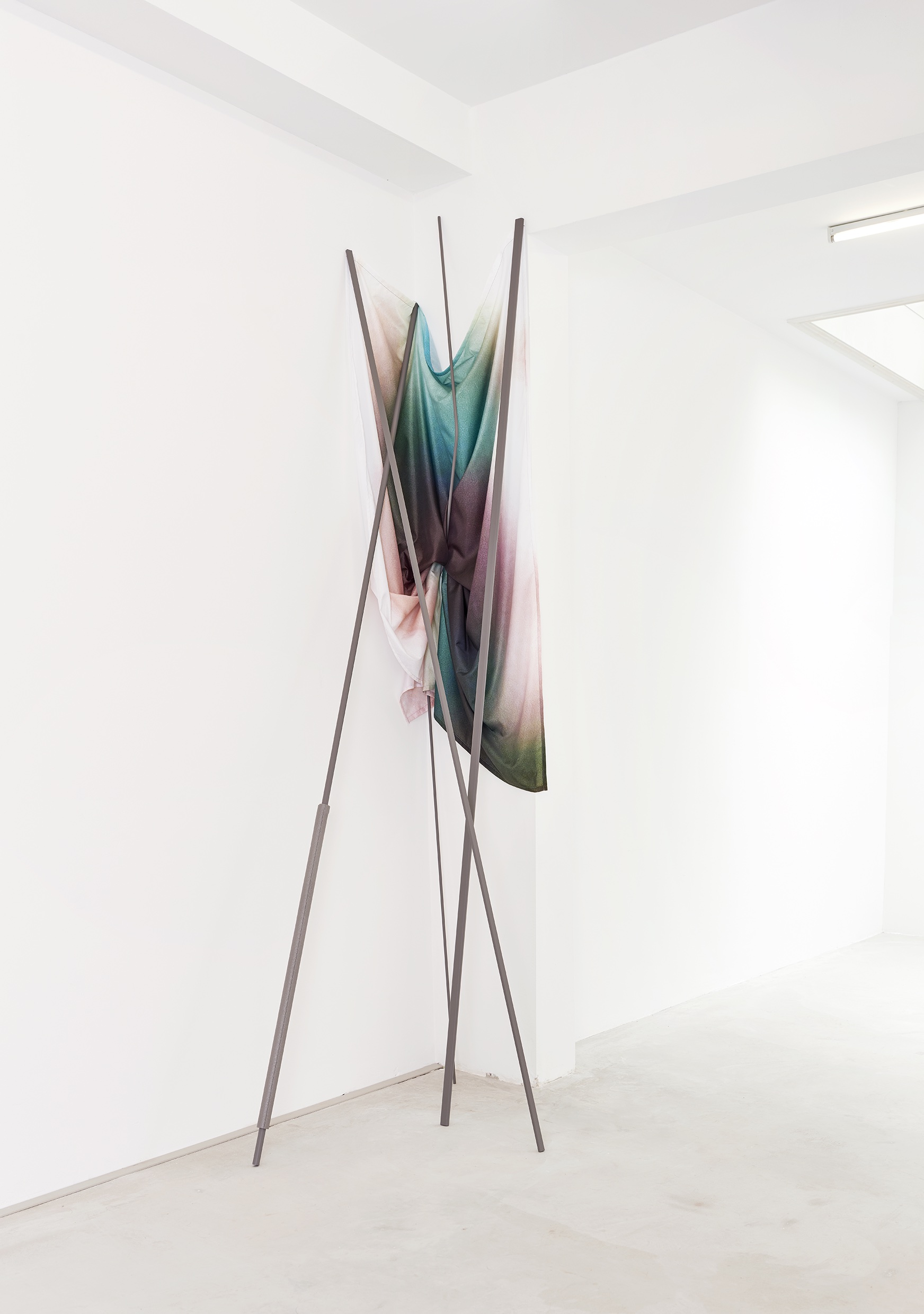
Neutral (restless)
sculpture, 300 x 115 x 88 cm, graphite grey metal construction with pipe-
insulation and 140 x 200 cm print on PVC curtain.
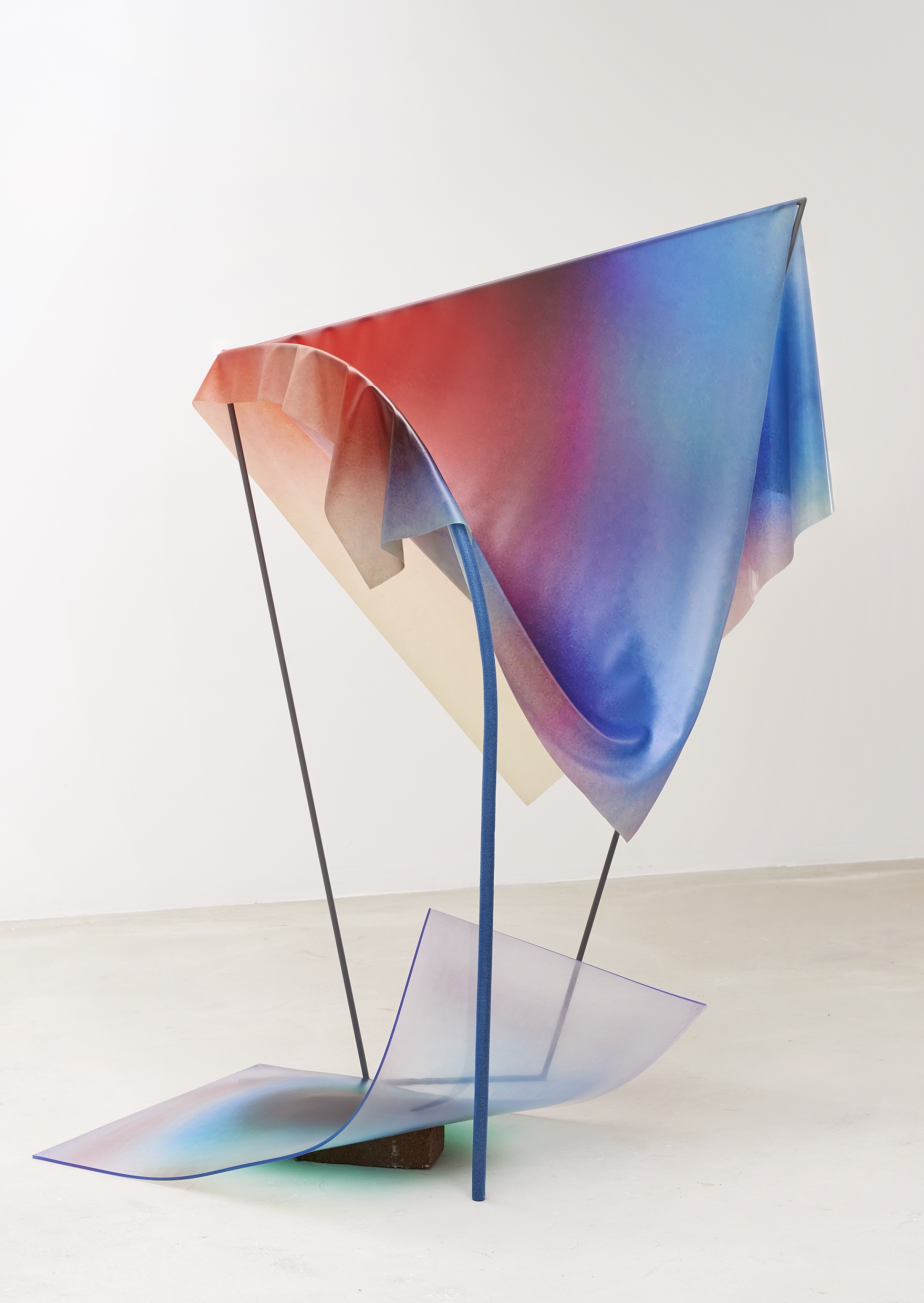
Neutral (confident)
sculpture, 105 x 46 x 80 cm, graphite grey metal construction with pipe-
isolation and 98 x 16 cm flatbed print on latex and 55 x 87 cm flatbed print on vinyl.
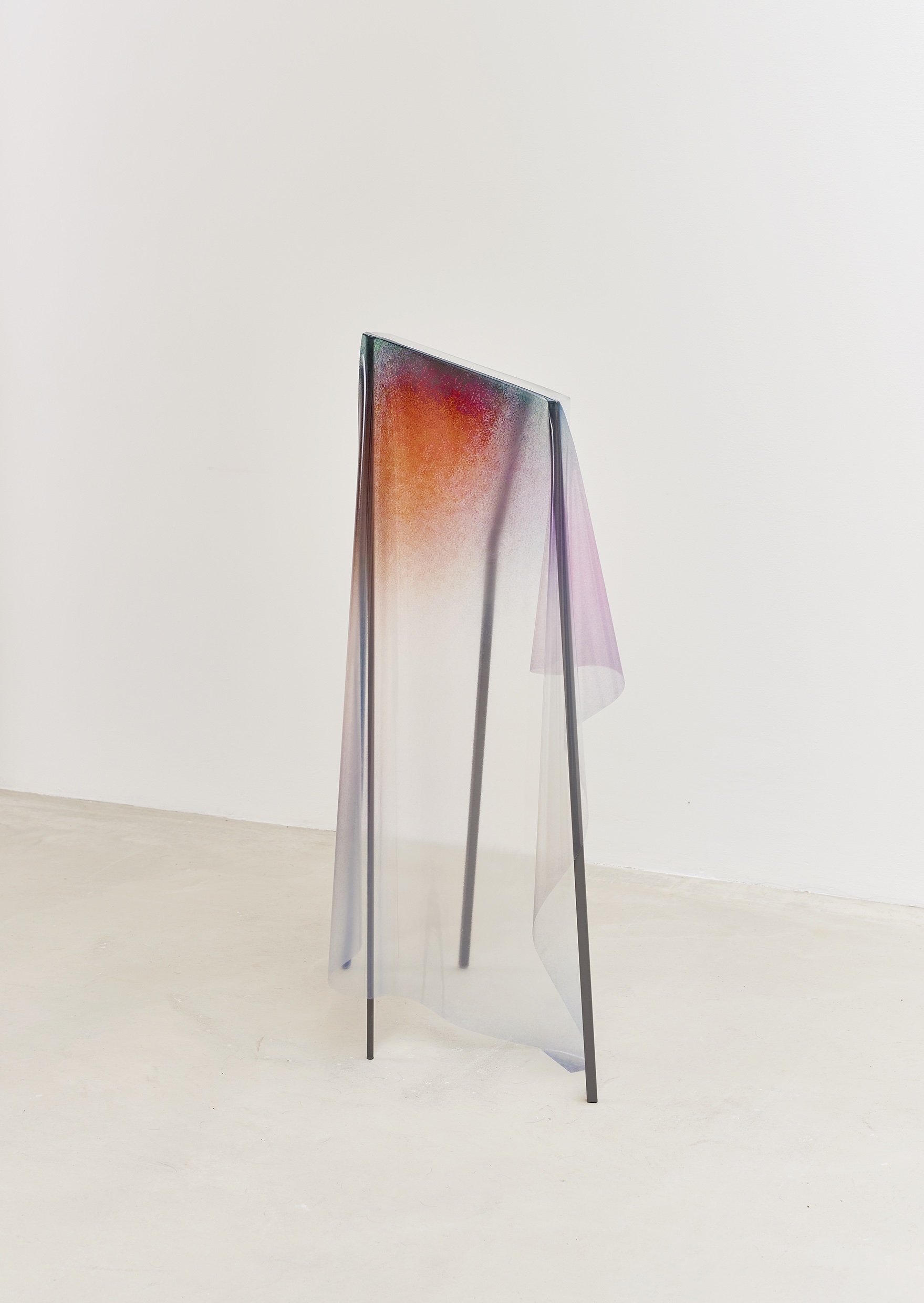
Neutral (mellow)
sculpture, 110 x 40 x 40 cm, graphite grey metal construction with pipe-
isolation and 125 x 71 cm flatbed print on thin plastic (PVC 0.5 mm).
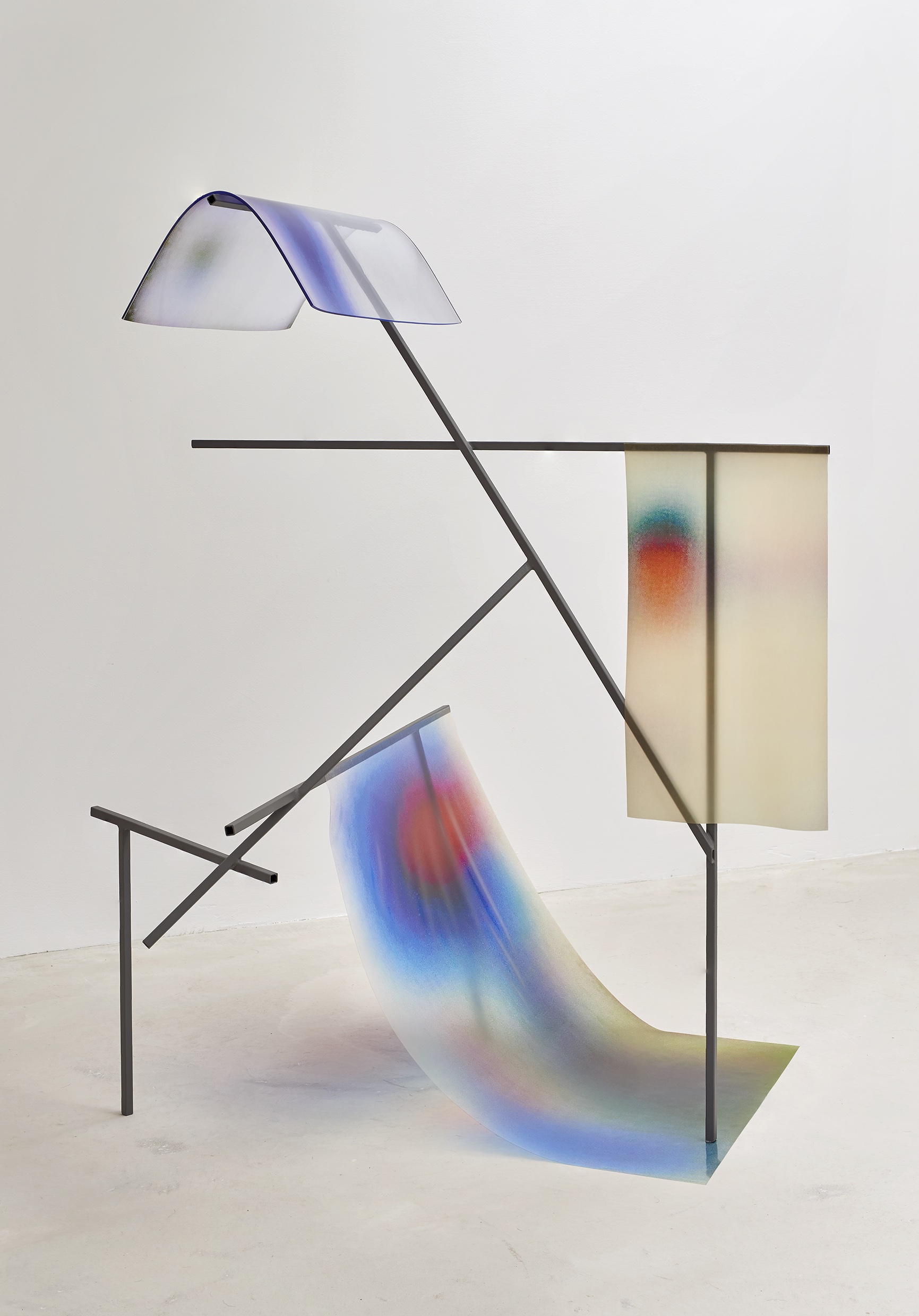
Neutral (puzzled)
sculpture, 154 x 120 x 110 cm graphite grey metal construction and flatbed
print on latex, thin plastic and vinyl.

Neutral (openhearted)
sculpture, 178 x 123 x 30 cm, graphite grey metal construction and 87 x 61 cm
flatbed print on vinyl and black rubber band.
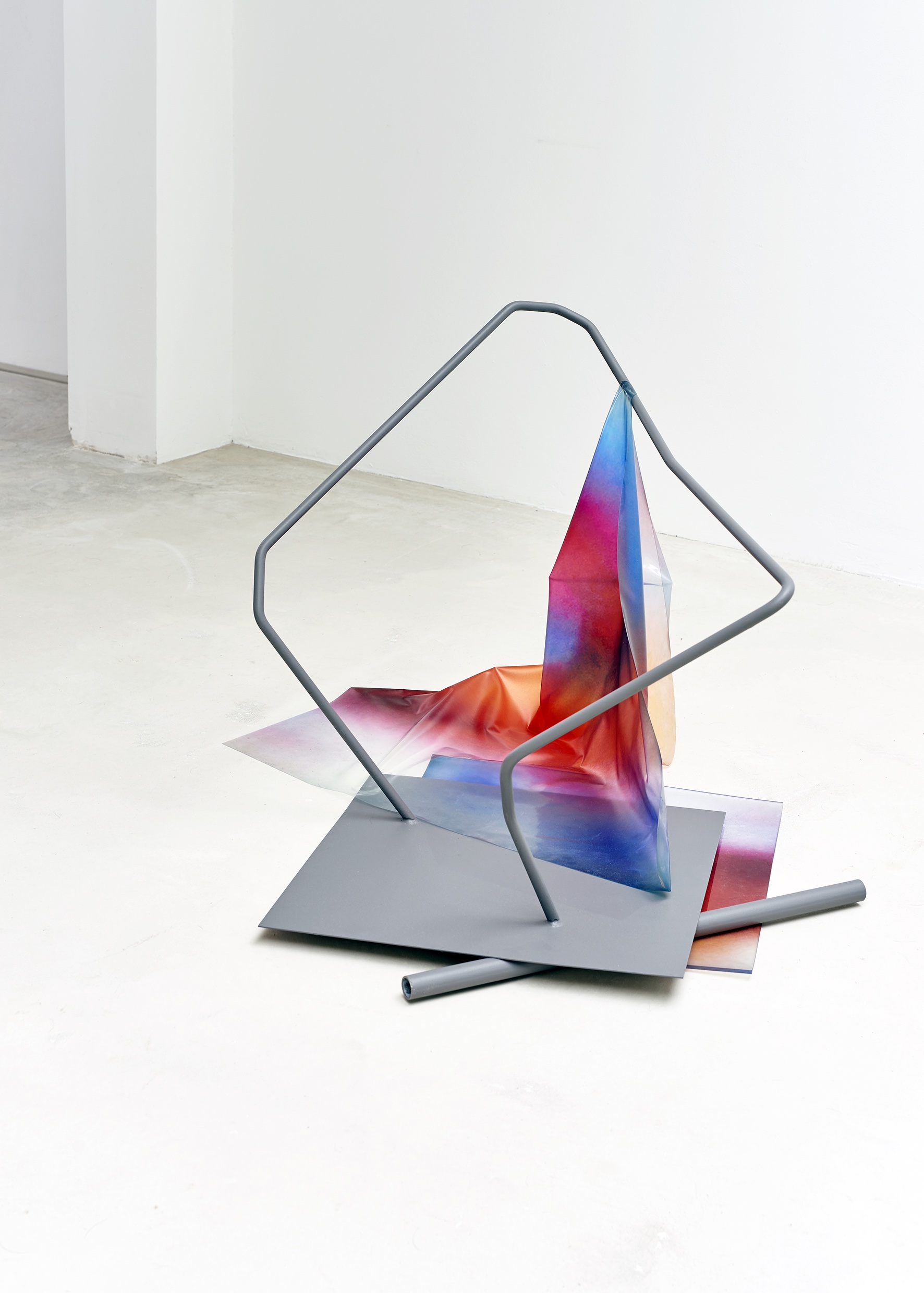
Neutral (psyched)
sculpture, 65 x 100 x 65 cm, graphite grey metal construction and 80 x 76
cm flatbed print on thin plastic (PVC 0.5 mm) and 50 x 47.5 cm flatbed print on vinyl.
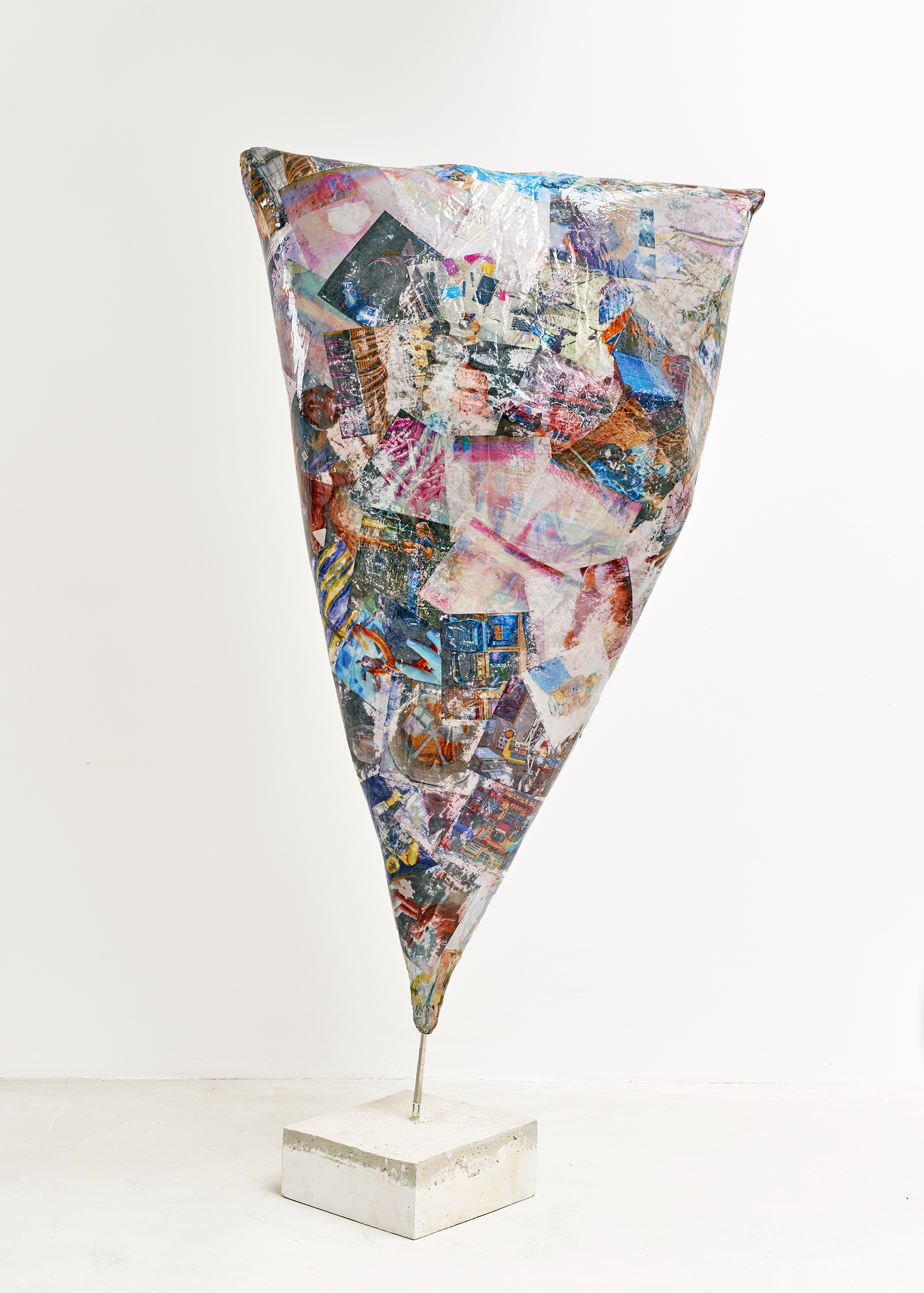
Sorry, no definitions found…
sculpture 207 x 103 x 60 cm, Selfie-stick in concrete and papier-mâché with
resin and + 150 inkjet prints 20 x 20 cm each.
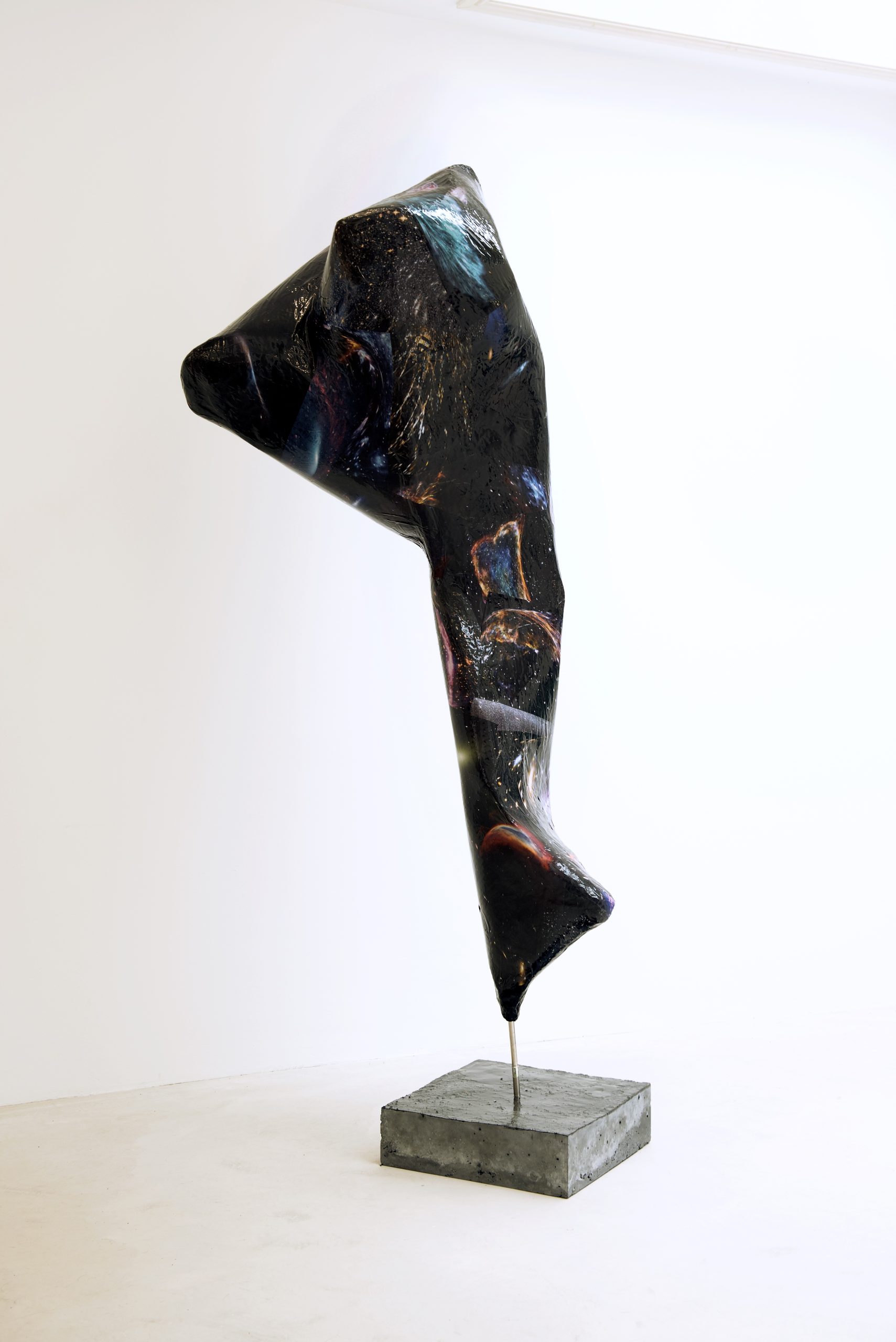
Another Universe
sculpture, 230 x 95 x 80 cm, Selfie-stick in concrete and papier-mâché with
resin and + 200 laser prints 28 x 40 cm each.
In Neutral, the source images are the blurred-out ID cards that accompany confiscated items (mainly weapons) from screenshots of the TSA’s (Transportation Security Administration) Instagram feed. Sorry, no definitions found… comprises a mix of high-tech-curiosity filled imagery taken from all the different researched Instagram accounts. In Another Universe, screenshots from NASA’s (National Aeronautics and Space Administration) Instagram feed are deliberately twisted in Photoshop to create a misleading universe.
Kedsuda Loogthong
Songkhla, Thailand.
The x-ray film reveals an abnormality of blood vessels found in my mother’s brain — lines of veins crossing and overlapping without beginning or end. These vessels have inspired an exploration of abstraction in line, colour, and space that form and recall the web and bonds of blood, in kinship and, even, gift.
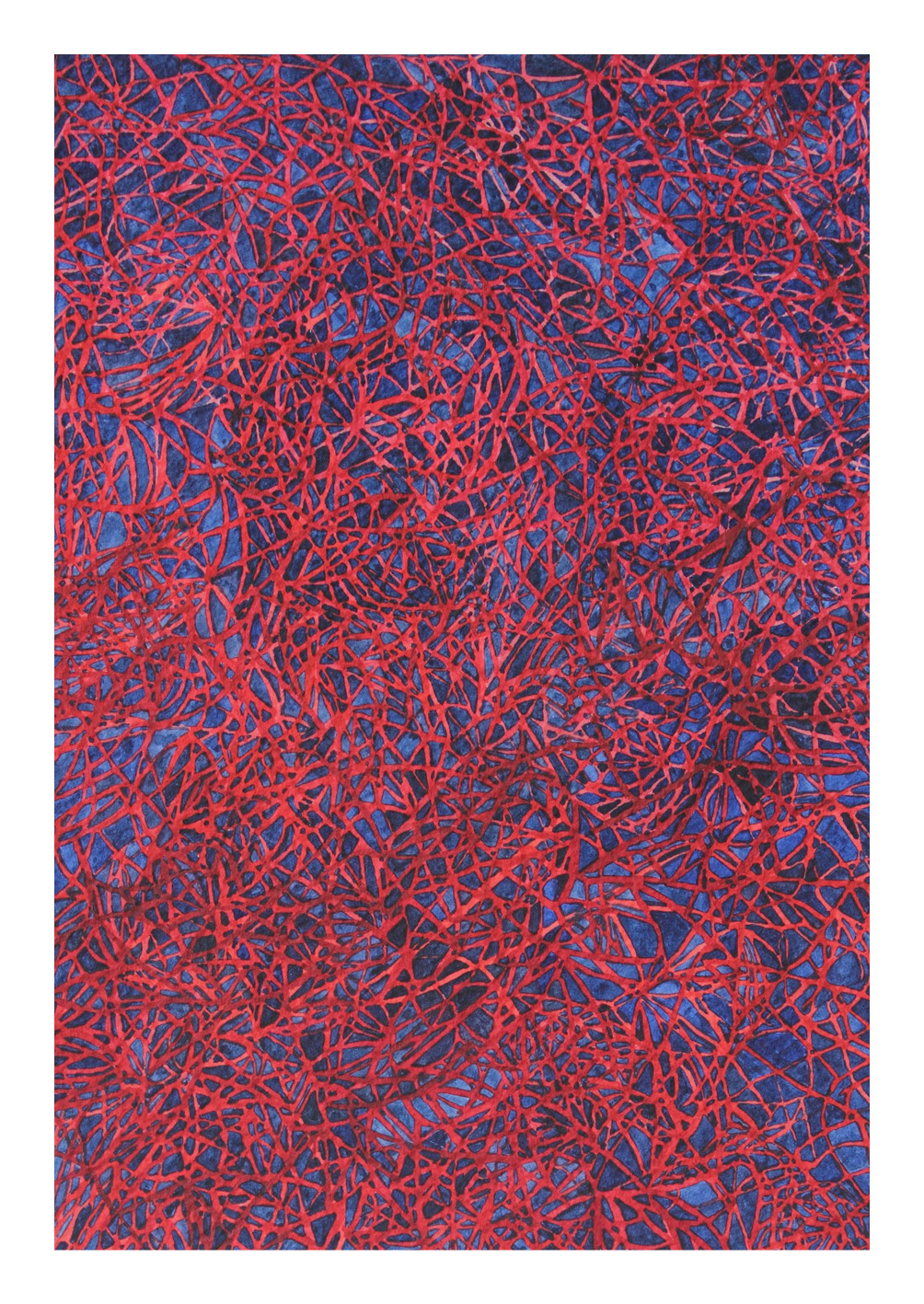
Spiderweb of Spirit
watercolour on paper, 25 x 17 cm, 2017.
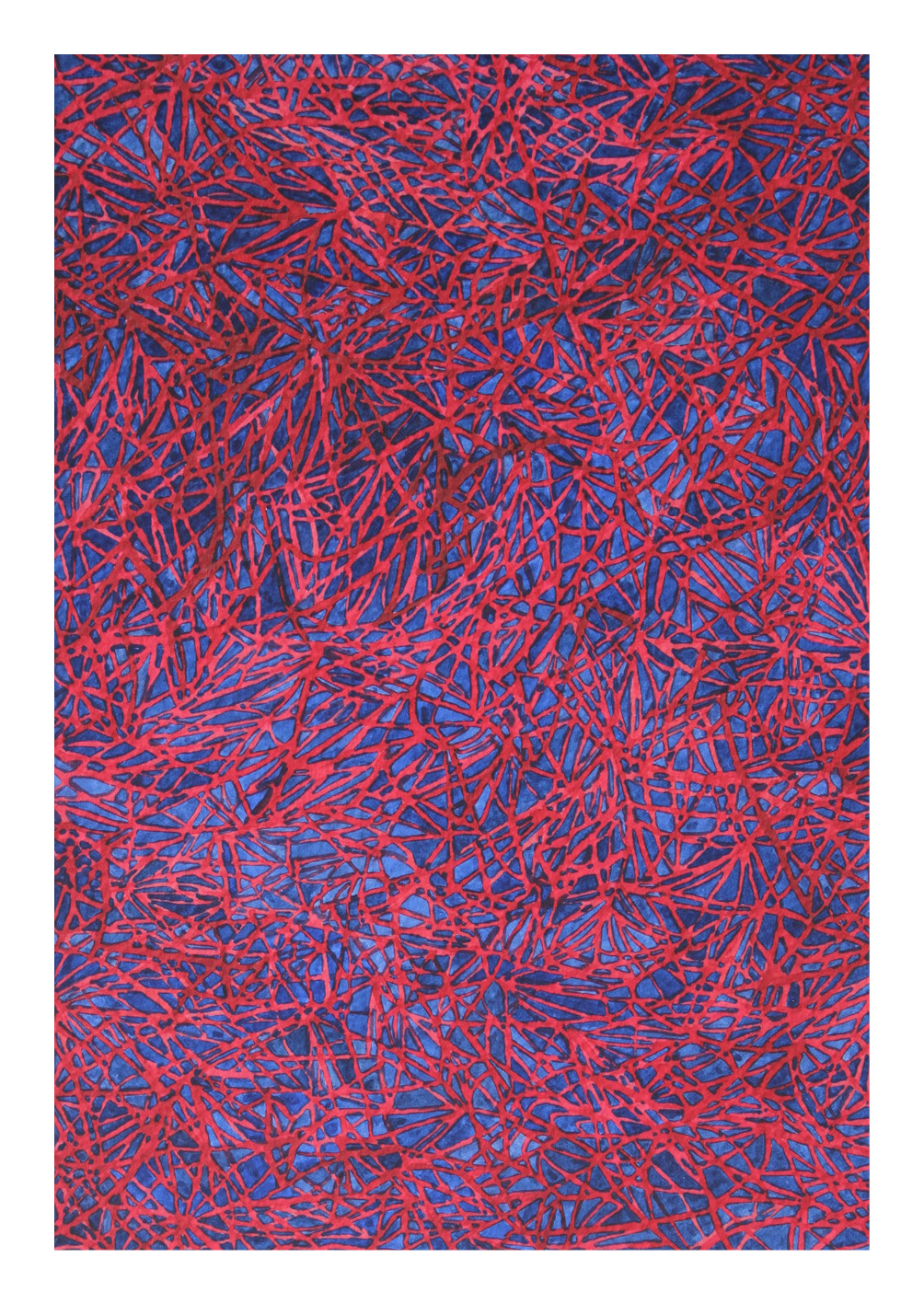
The Boomerang of Red
watercolour on paper, 25 x 17 cm, 2017.
Hajnal Németh
Born Szőny, Hungary. Lives and works in Berlin, Germany.
WHITE SONG – Among Others (Race Abstraction)
photo series, 2016
The verses on the four photos are taken from Roy Harper’s song
“I Hate The White Man,” 1970.
I abstracted single parts from the refrain and changed the colour to red, yellow and black.
Since I introduced a comma after the colour, I changed the meaning of the sentence as well.
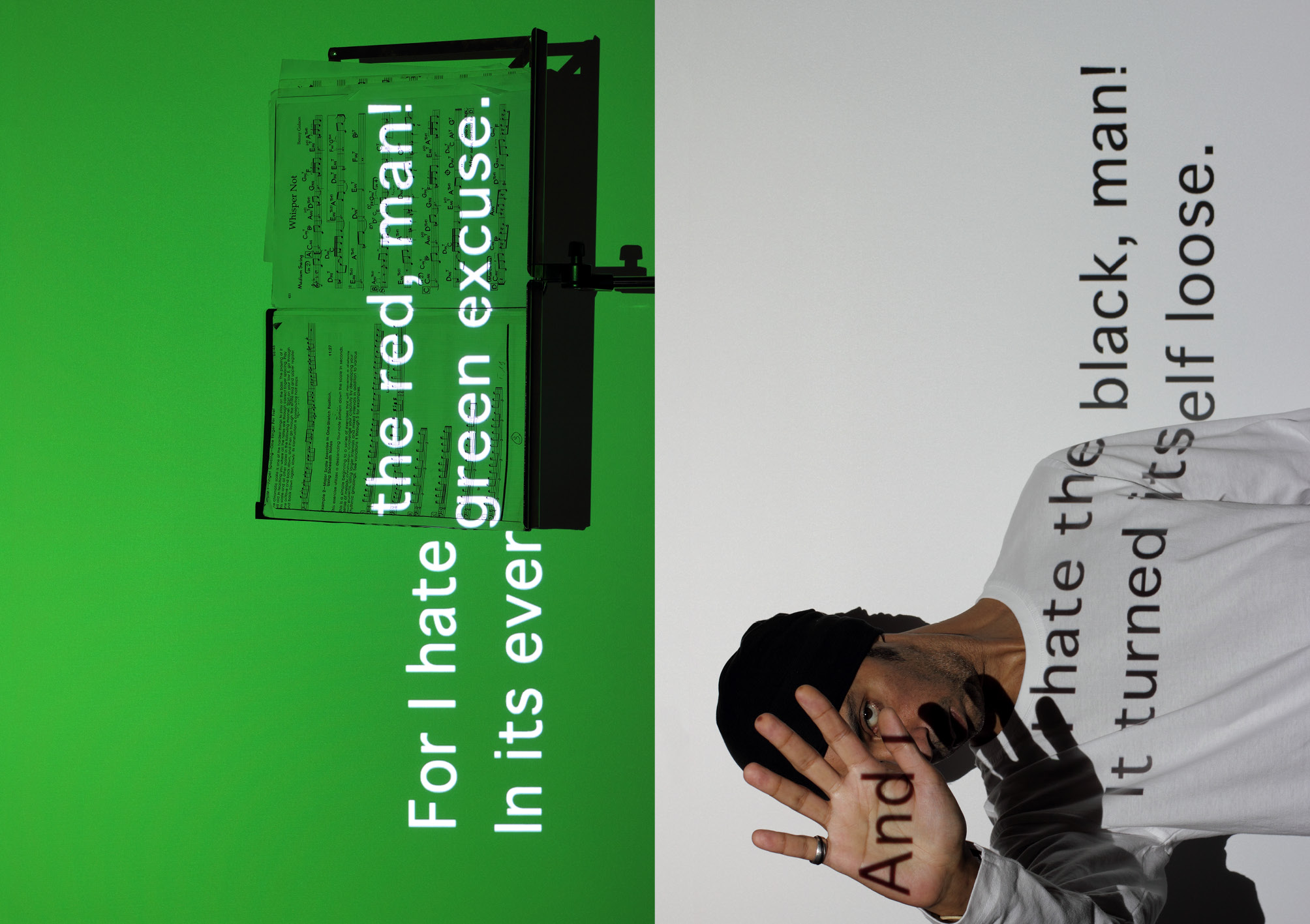
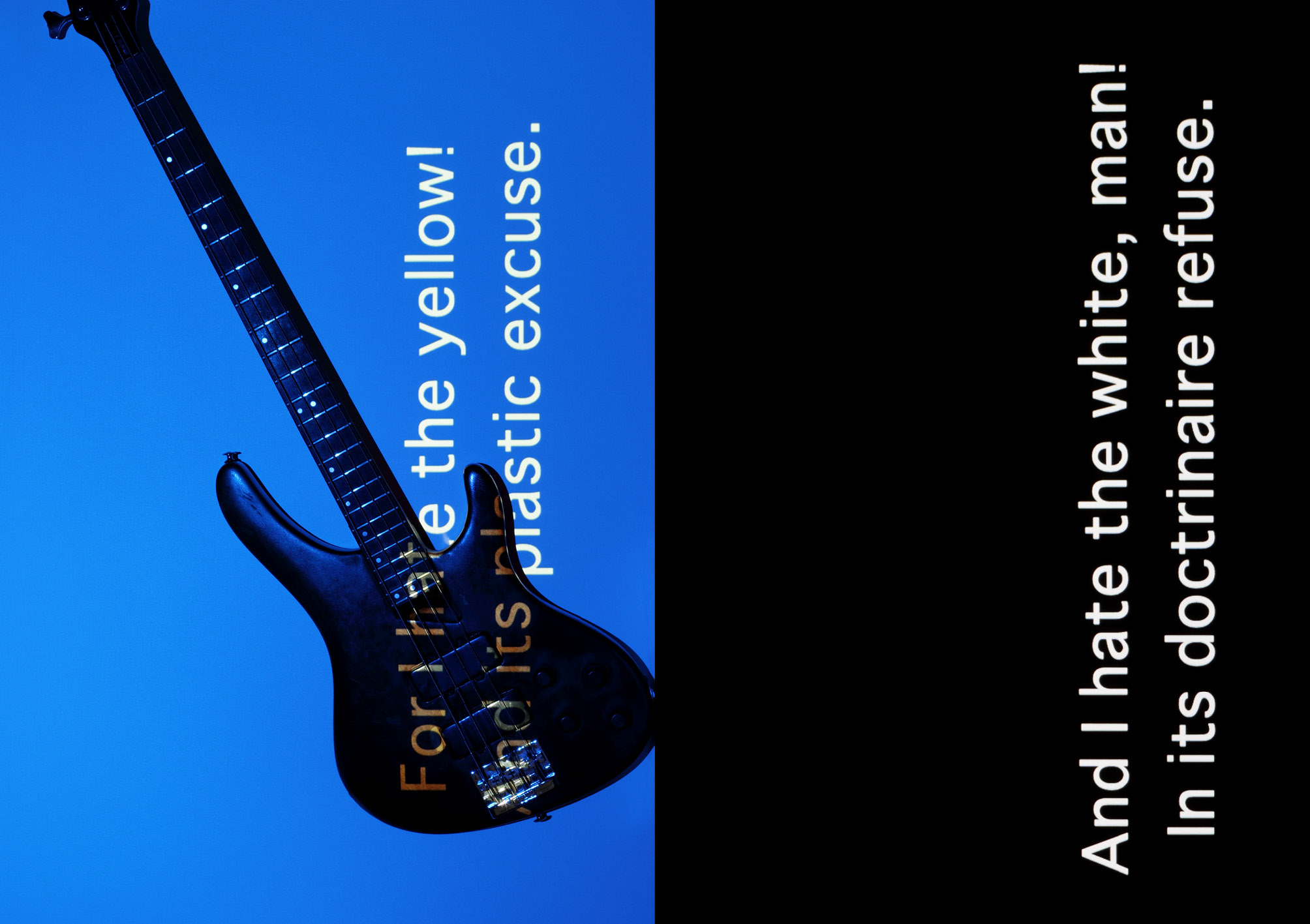
Marienne Yang
Singapore
Fast-forward 50-years - how will we be remembered, and what would we be remembered for?
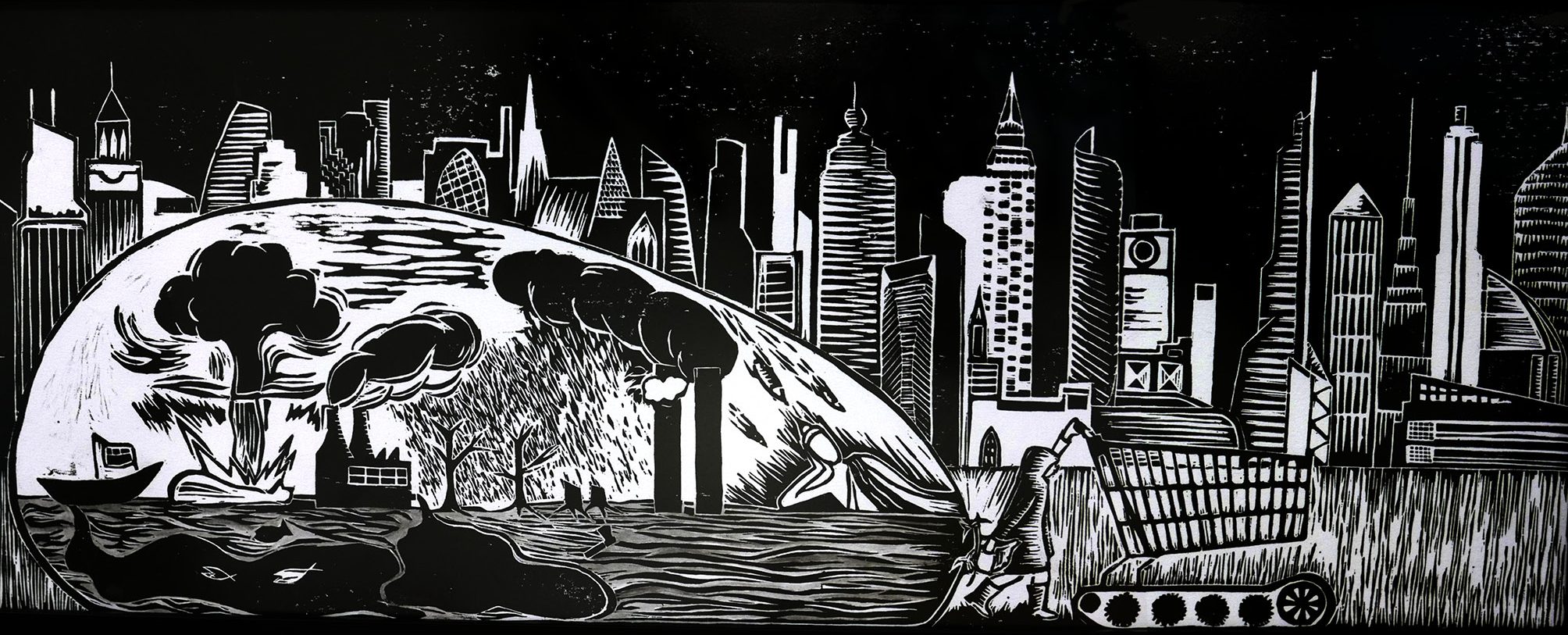
When the Children Cry I
Hand-coloured relief print, 23 x 60 cm, 2015.
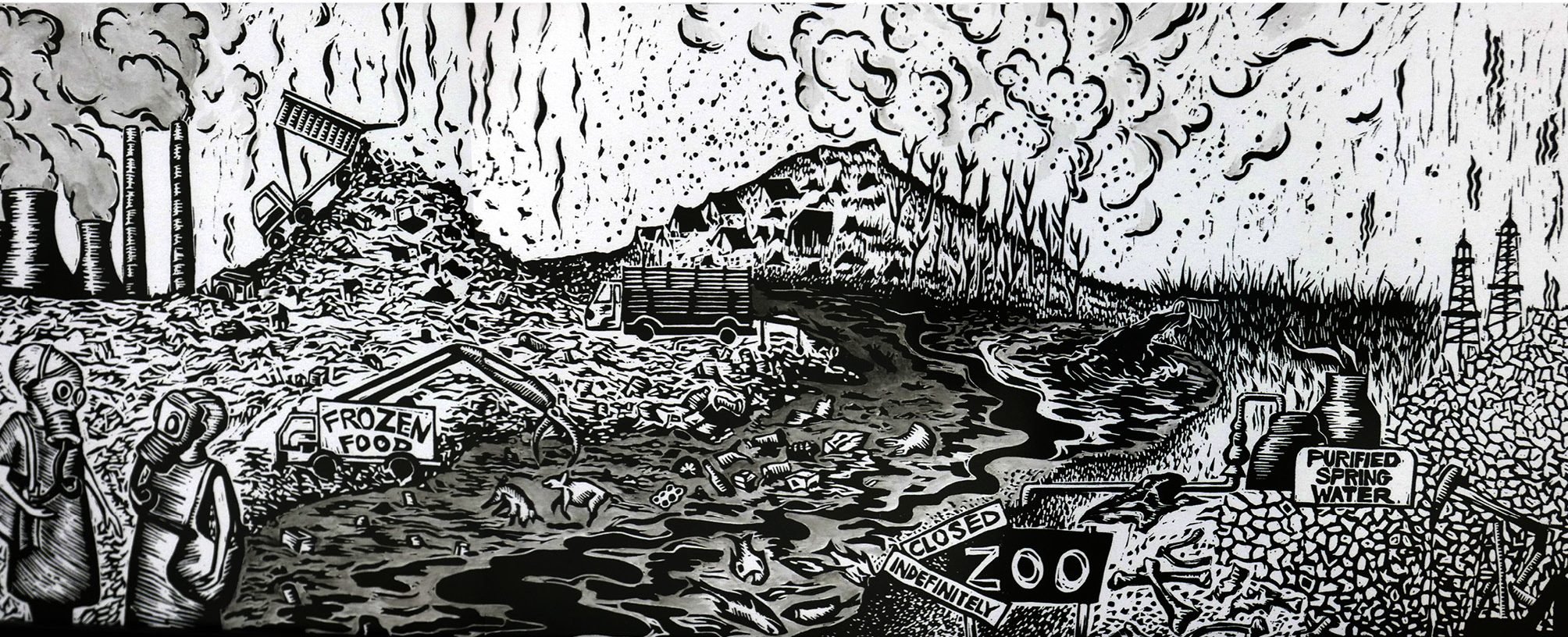
When the Children Cry II
Hand-coloured relief print, 23 x 60 cm, 2015.

When the Children Cry III
Hand-coloured relief print, 23 x 60 cm, 2015.
Au Sow Yee
Born Malaysia. Lives and works in Taipei and Kuala Lumpur.
Kris Project III: A Day Without Night in Tokyo
from the storyboard of a film to be completed in 2018.
Part of The Kris Project (which draws from filmic archives of the 1950s and 1960s to re-imagine history and ‘phantoms’ of the Malayan film industry during its heyday), A Day Without Night in Tokyo shares from the artist’s upcoming film: an intertwining tale of hidden power and memories’ construction inspired by the seemingly non-existent film, A Night in Tokyo (Malam-di-Tokyo) produced by Cathay-Keris.
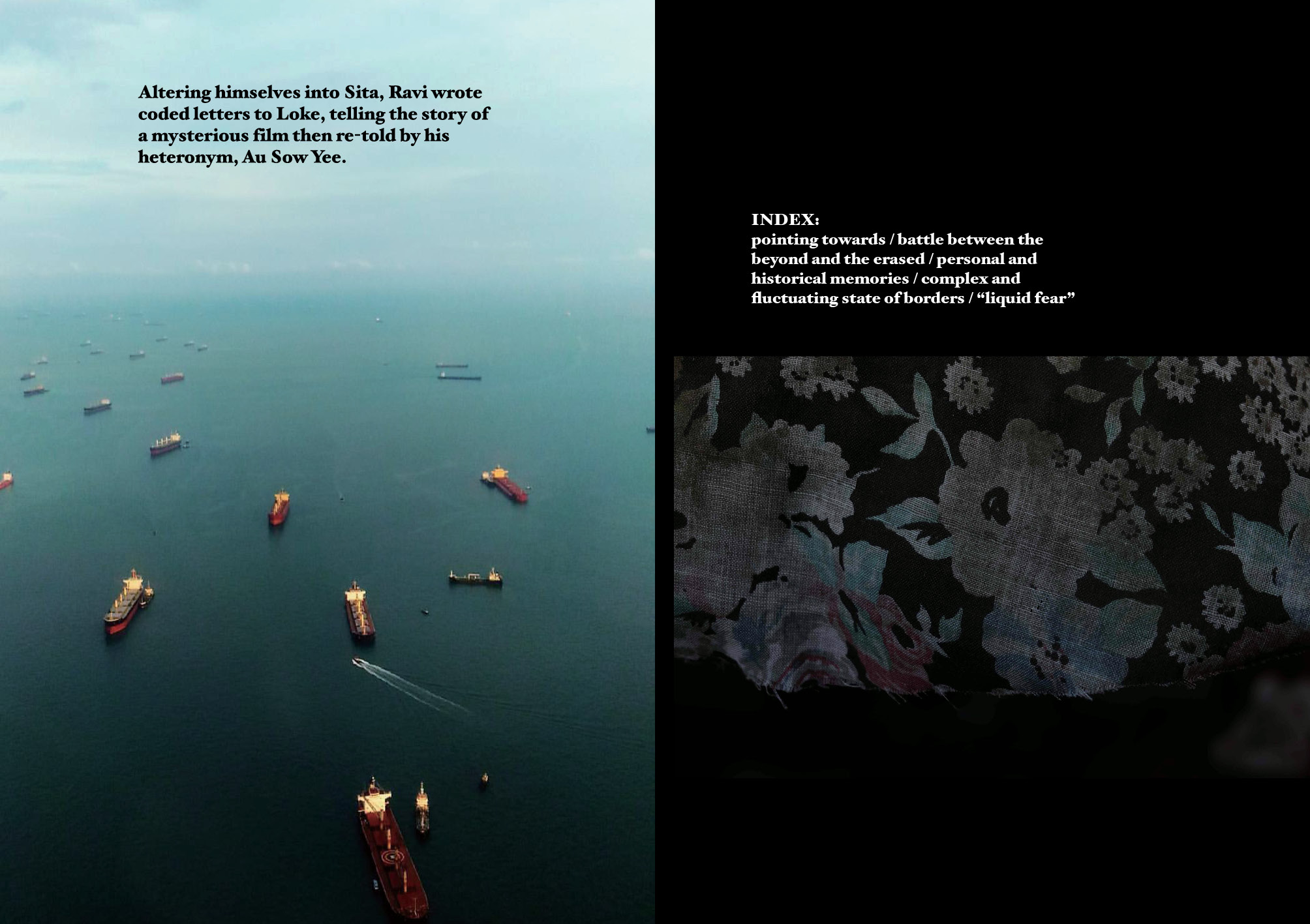
Maharani Mancanagara
Born Padang, Indonesia. Lives and works in Bandung, Indonesia.
Nurrachmat Widyasena
Bandung, Indonesia.
Rekaan Propaganda
series of six digital prints on paper, 120 x 85 cm (each), 2014.
In Rekaan Propaganda, history is used as a point of reference to recall and to realise humanity’s dream of a better world, both for ourselves and for Indonesia. Explored via historical promises, justifications, and discontinuities in the spheres of education and technology, the series presents the possibilities that the future holds.
The following translations by artist, Grace Samboh, and June Yap.
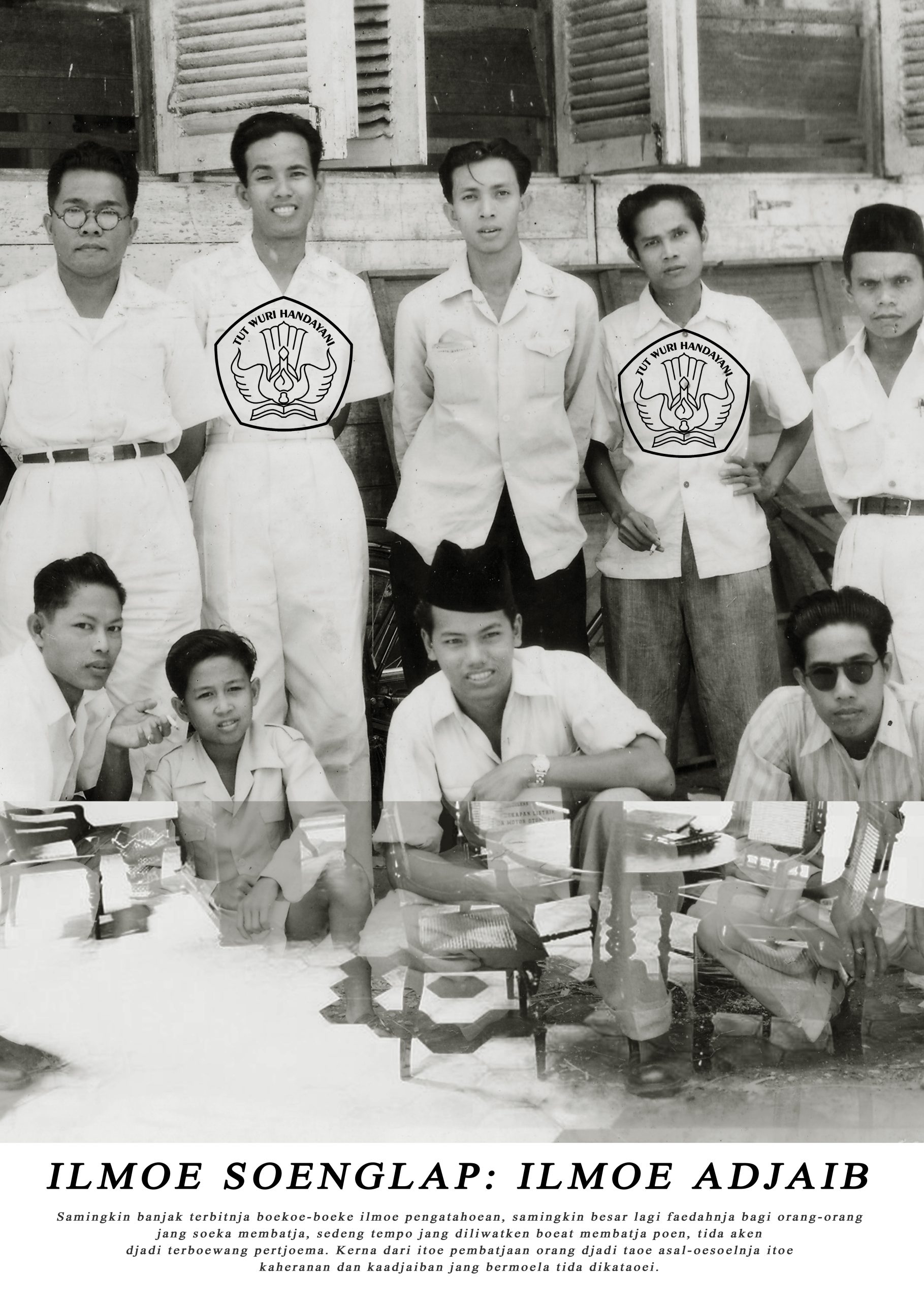
Science Magic : Science Witchcraft
The more scientific studies published, the more benefits there will be for
those who like to read them; time spent reading is never wasted. Through reading,
people will know of the origins of life and the wonders that have occurred.
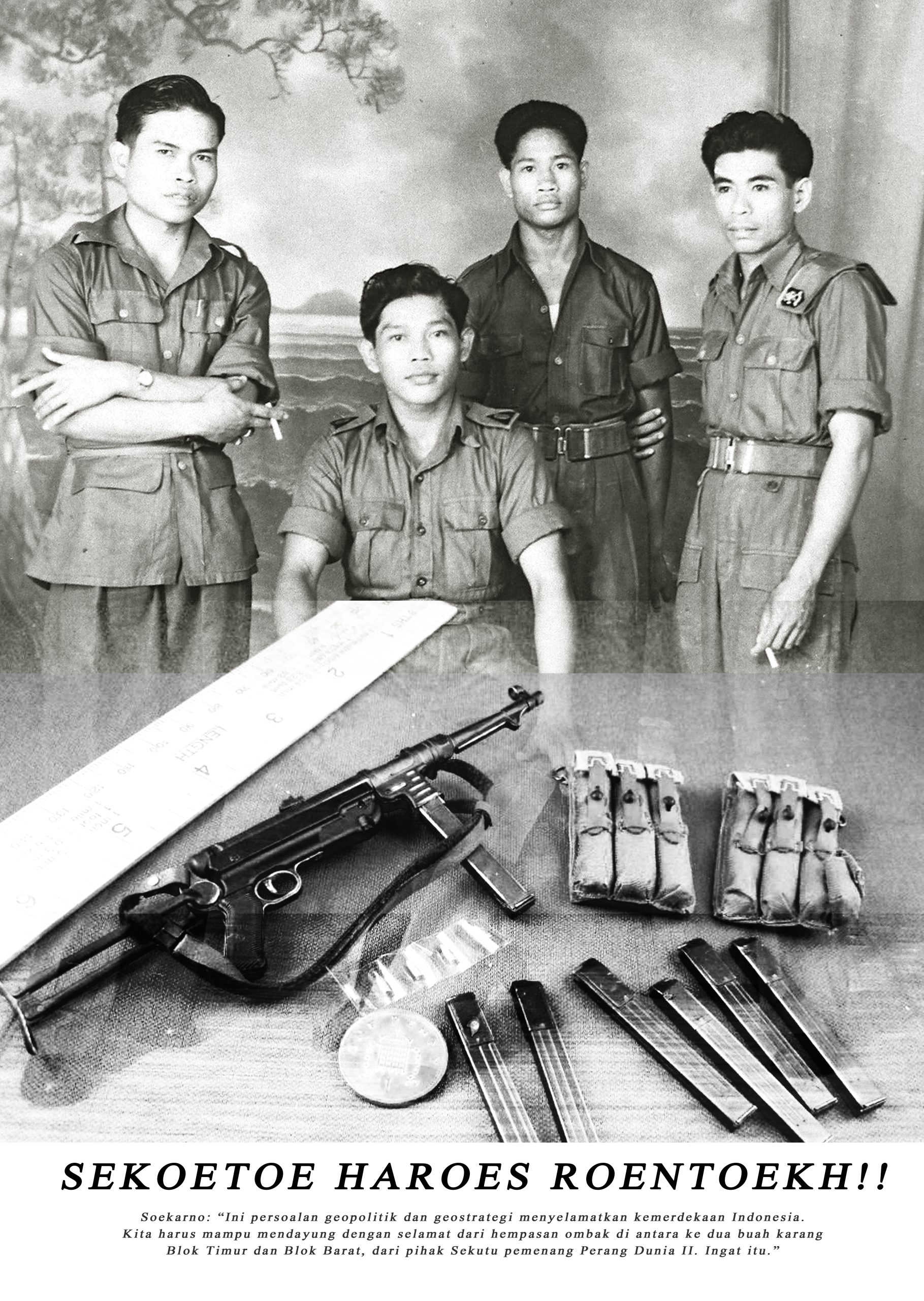
Allies Must Collapse!!
Soekarno: “The issue of geopolitics and geostrategy can come to the aid
of Indonesia’s independence. We must be able to paddle safely through
the pounding waves, between the corals of East Block and West Block,
from the Allied victors of World War II. Remember that.”
(President Soekarno’s answer to the young exponents of Menteng 31 on
the state of the post-independence cabinet).

Story of Tjonad
Prone to mischief since childhood, Tjonat (Lie A Tjip) fled to Batavia after
killing his friend. Whilst in the city, he became a Dutch servant, though he
would often take advantage of his master’s property. Subsequently, he
became a thief, and fell in love with Lie Gouw Nio (Ku Fung May). His
advances rejected, Tjonat tried to kidnap Gouw Nio. “It happened just as
such, a long, long time ago.” –F.D.J. Pangemanann.

Ignition Sequence Start!!
Rocket’s engine is its greatest characteristic; both when propelled by fuel
or by oxidants without a combusting oxidising agent. This is not something
that every jet machine can do. Satellite launches, spacecrafts, lunar craft
and other forms of space propulsion all require a rocket engine.

The Indonesian Dream
Family is the greatest treasure. Like a magnificent castle. Or like a
meaningful poem. Even the splendour of pearls cannot compare to that of
the family. Good morning, Mother. Good morning, Father. The sun shines
this beautiful day. Equally radiant are our sons and daughters, ready to be
of service.
(Lyrics from the theme song of an Indonesian popular television series
portraying a happy family.)
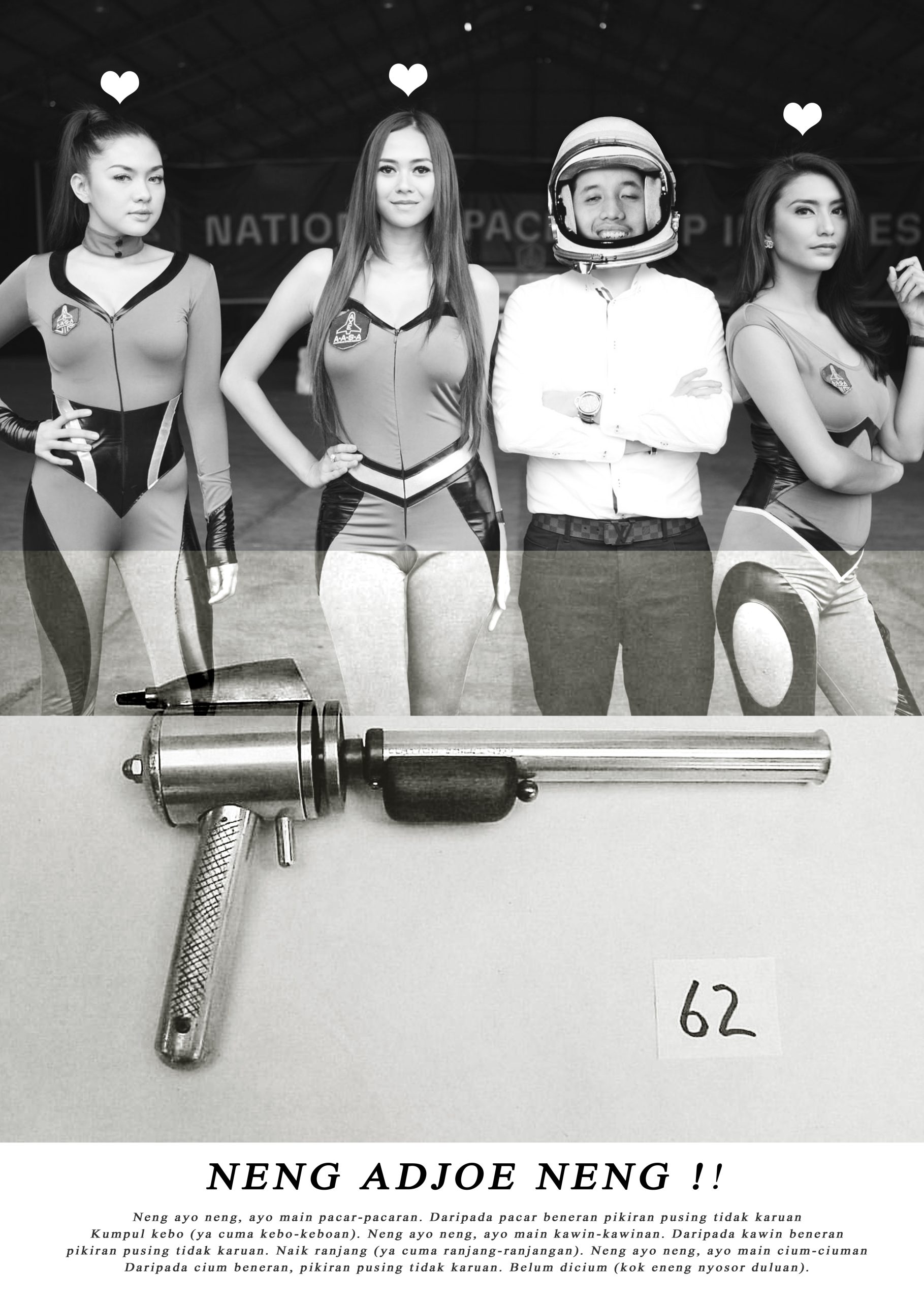
Hey Girl, C’mon Girl
Hey girl, c’mon girl, let’s play at dating. Rather than having a real
boyfriend who makes you dizzy and unhappy. Cohabiting (yes, just playing
at cohabiting, not the real thing). Hey girl, c’mon girl, come let’s
pretend to be married. Instead of a real marriage that makes you dizzy and
unhappy. Let’s go to bed (yes, just only to bed). Hey girl, c’mon girl, let’s
play at kissing. Instead of a real kiss, that makes you feel dizzy. I haven’t
kissed you yet (why are your lips already on mine).
(Excerpt from a dangdut song — popular Indonesian music that combines
traditional and local film music, and Western rock music — about a man
flirting with a girl whom he has just met)
Laura Horelli
Born Helsinki, Finland. Lives and works in Berlin, Germany.
Namibia Today
Nine of 18 billboards, inkjet and offset prints, 356 x 252 cm, 2017.
The SWAPO (South West Africa People’s Organisation) Liberation Movement fought for Namibia’s independence from South Africa from 1960 to 1990 and has governed the country since. The artist pays special attention to the period between 1980 and 1985 when the English-language journal Namibia Today was printed in the former GDR. Its editorial board was based in exile in Luanda, Angola.
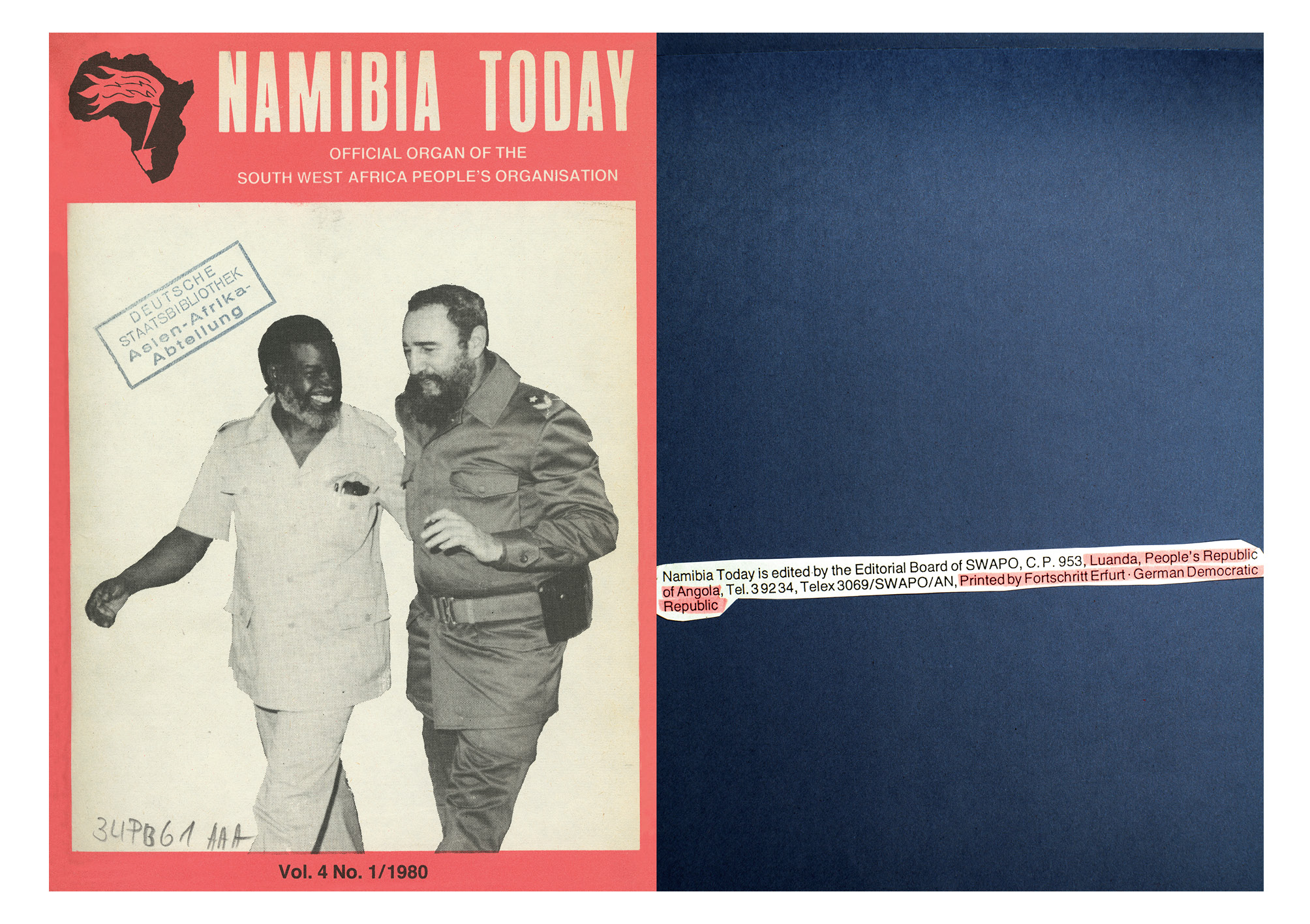
Left: Sam Nujoma and Fidel Castro, 6th Summit of Non-
Aligned Countries, Havana, Cuba, 3–7 Sept 1979.
Front page Namibia Today, Official Organ of the
South West Africa People’s Organisation (SWAPO),
Vol. 4 No. 1/1980. Berlin State Library.
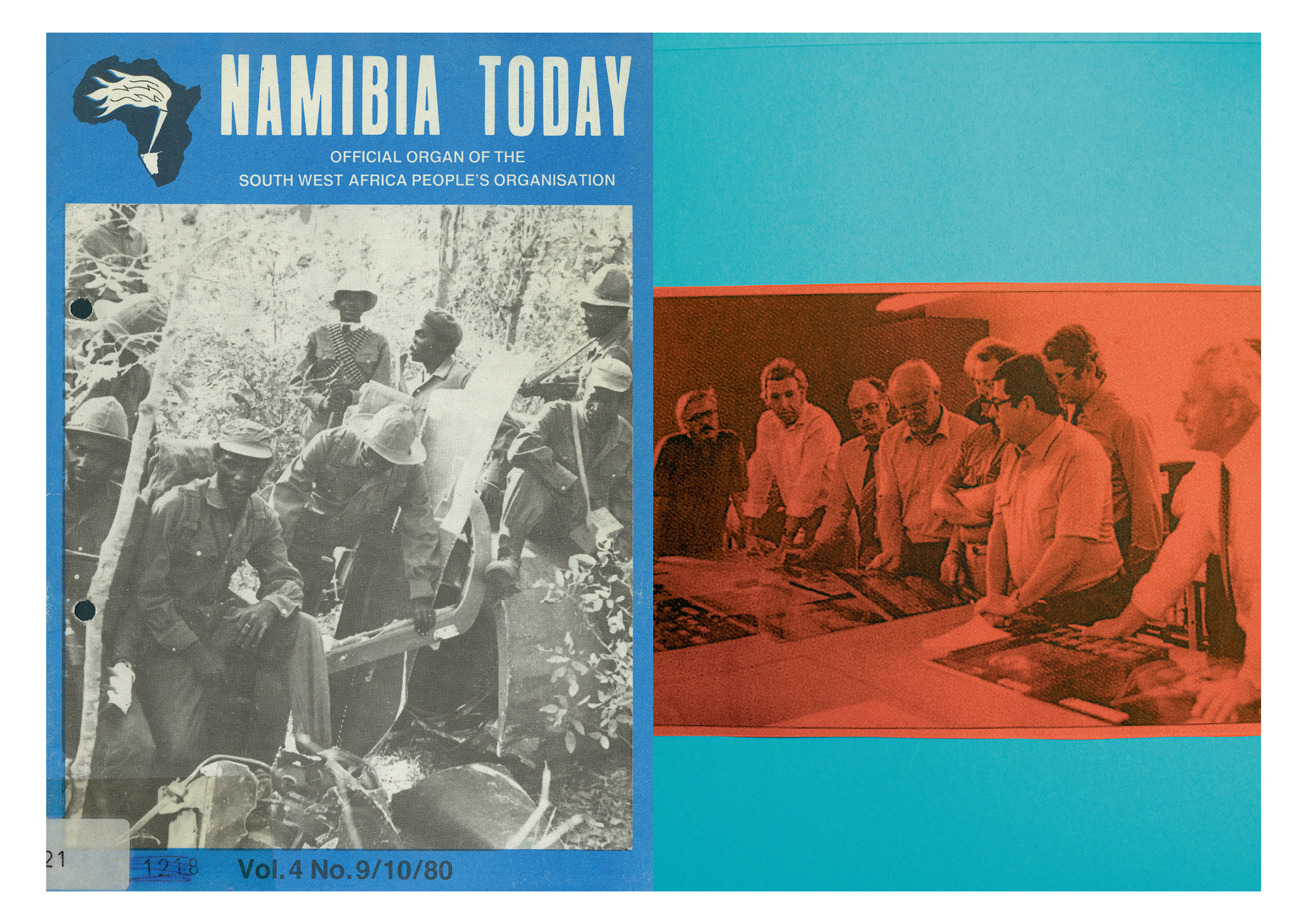
Left: Namibia Today, Vol. 4 No. 9/10/80. Library of the
Friedrich-Ebert-Stiftung.
Right: A delegation from the state printing houses informs
itself in Erfurt at the end of the 1980s about results in
consumer goods production, Dieter Schmidt, Jürgen
Taudien, Siegfried Hofmann et al. Druckhaus Gera
Archive.

Left: Colleagues Mund, Finke, Springer, Kopka, Heber
(binding collective) in “Offsetrolle“ (official political
organ of the printing house “Fortschritt” in Erfurt), Nr.
4/20.2.1980, p. 1. Erfurt City Archive.
Right: Namibia Today, Vol. 4 No. 11/12/80. Friedrich-Ebert-
Stiftung Library.
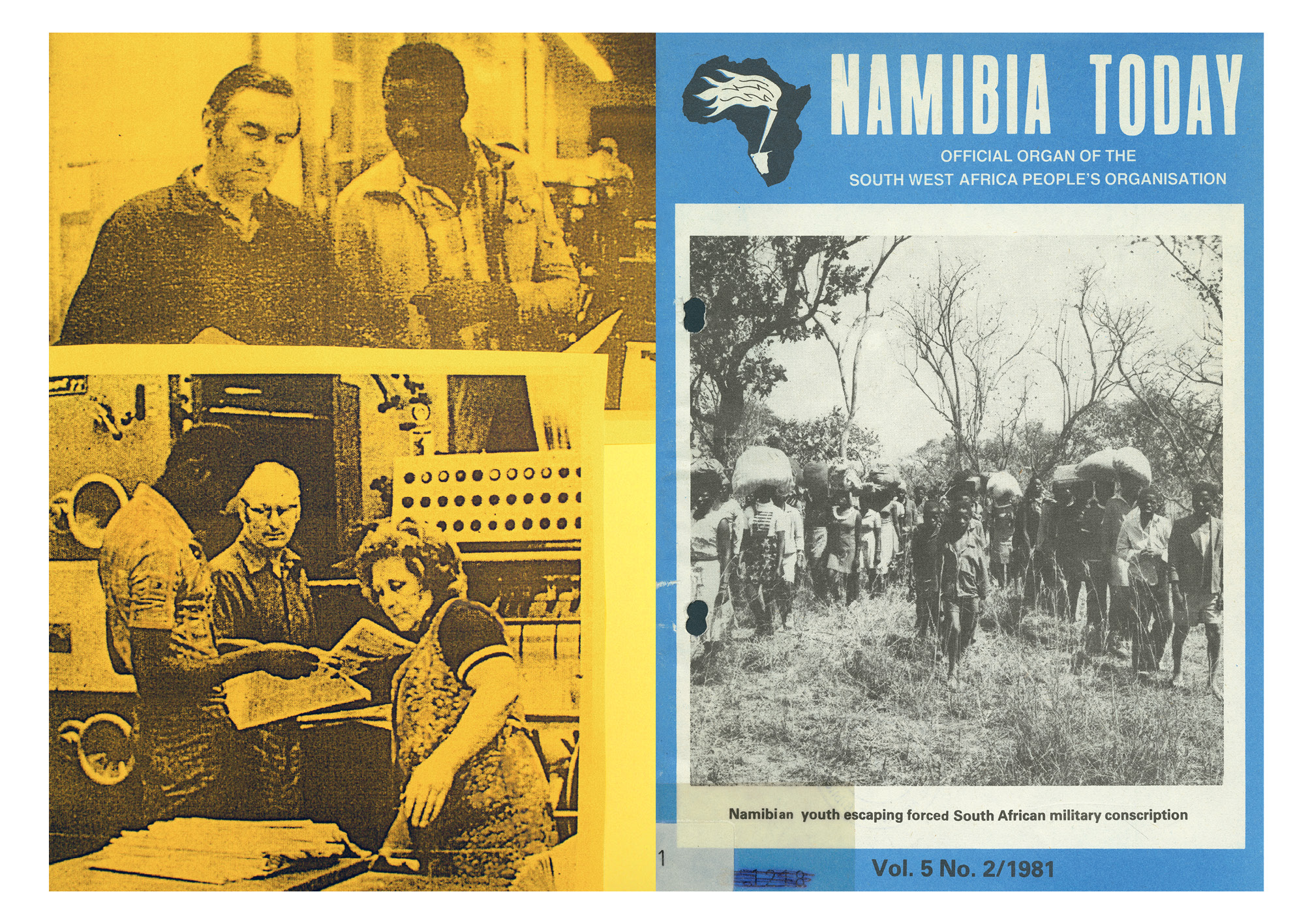
Top left: Colleagues Kaufmann, David Maseko. “Offsetrolle,”
Nr. 6/1980 (photo: Romer).
Bottom left: Colleagues David Maseko, Helmut Schade, Gisela
Stegmann. “Offsetrolle,” Nr. 10/1978. Erfurt
City Archive.
Right: Namibia Today, Vol. 5 No. 2/1981. Friedrich-Ebert-
Stiftung Library.
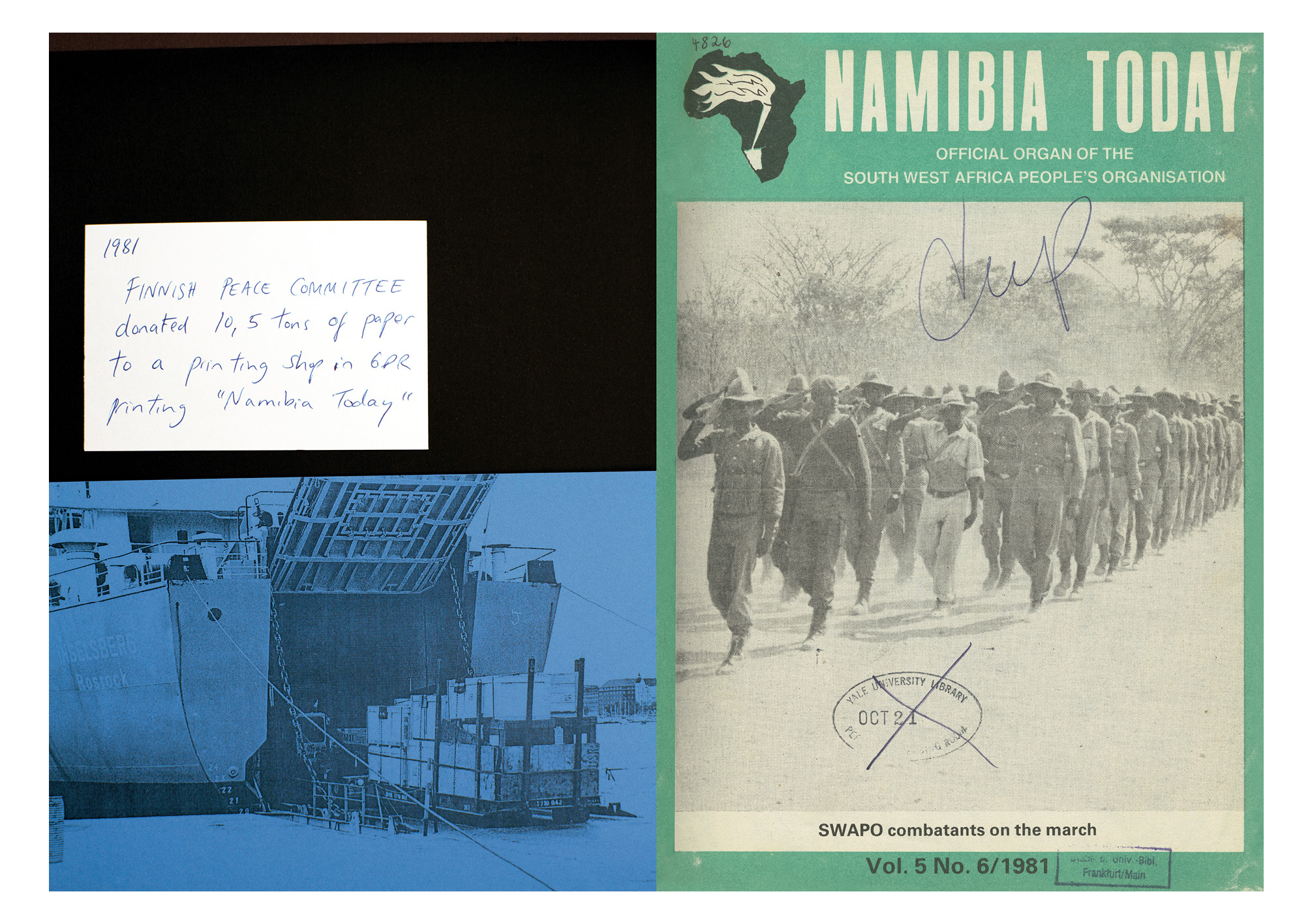
Top left: A note from Ilona Schleicher’s lecture “The GDR
Solidarity Committee and Nordic Support for the
Liberation Movements: Between Competition and Co-
operation, Cape Town and Robben Island,” 11-14 Feb 1999.
Bottom left: Solidarity cargo from Finland, 1985. SODI Archive.
Right: Namibia Today, Vol. 5 No. 6/1981. Frankfurt University
Library.
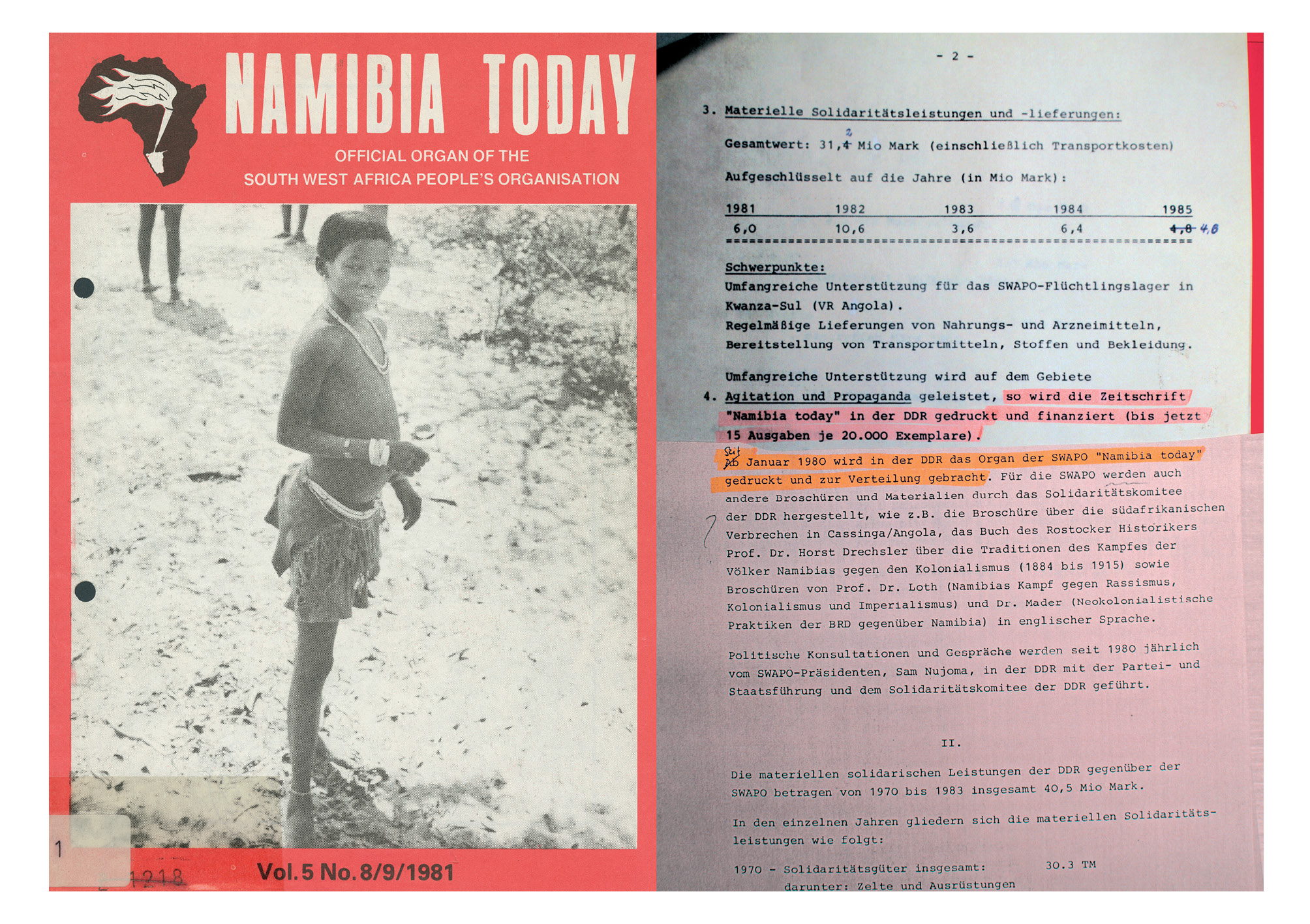
Left: Namibia Today, Vol. 5 No. 8/9/1981, Friedrich-Ebert-
Stiftung Library.
Right: German Federal Archives, BArch DZ8 522 / SWAPO.
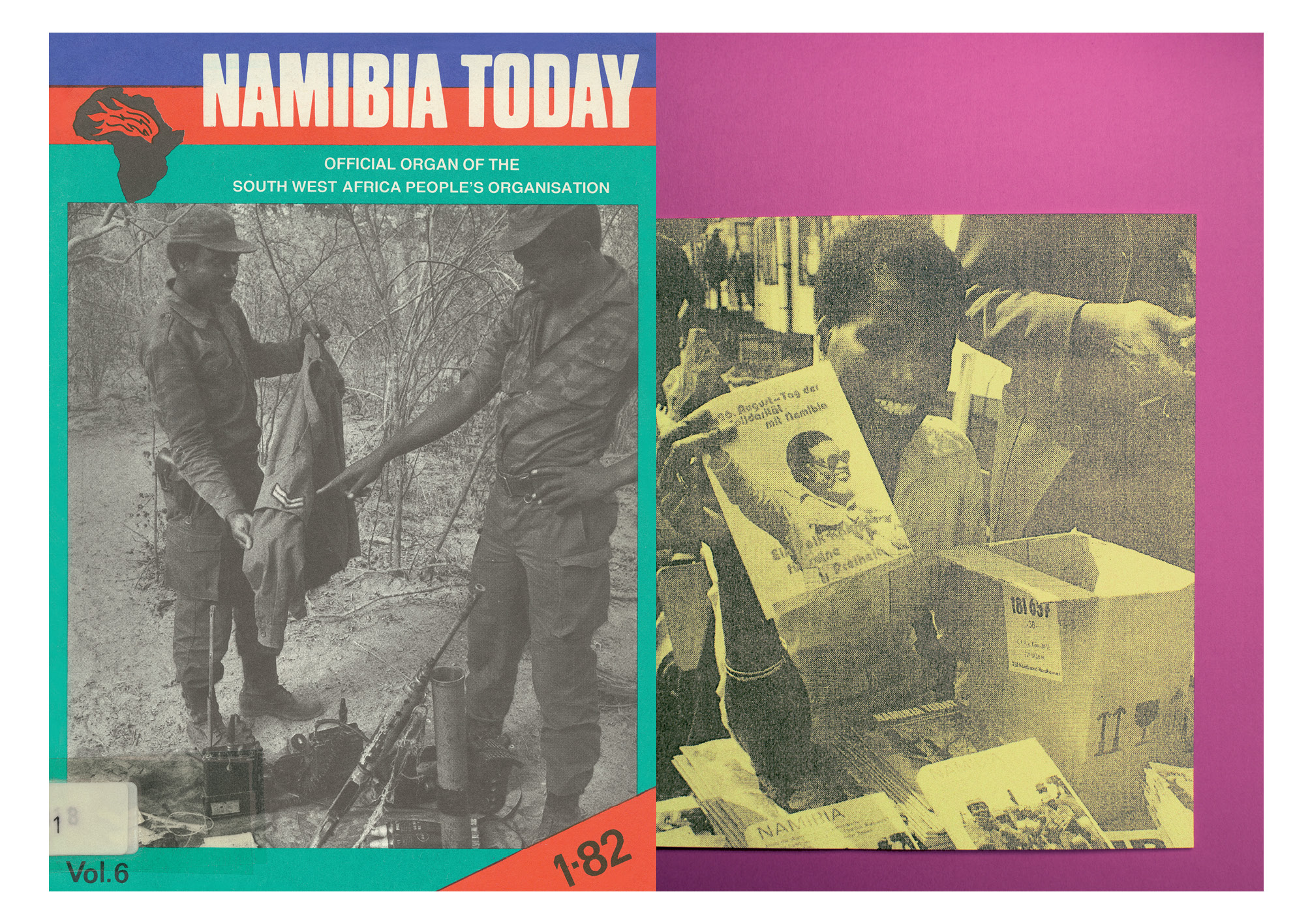
Left: Two PLAN fighters in Utapi, 75 km NW of Oshakati,
18 Jan 1982. Namibia Today, Vol. 6 No. 1/82.
Friedrich-Ebert-Stiftung Library.
Right: A Namibian student selling SWAPO information
material at a solidarity bazaar at Alexanderplatz,
Berlin (GDR), Namibia Today, Vol. 6 No. 3/82
Friedrich-Ebert-Stiftung Library.
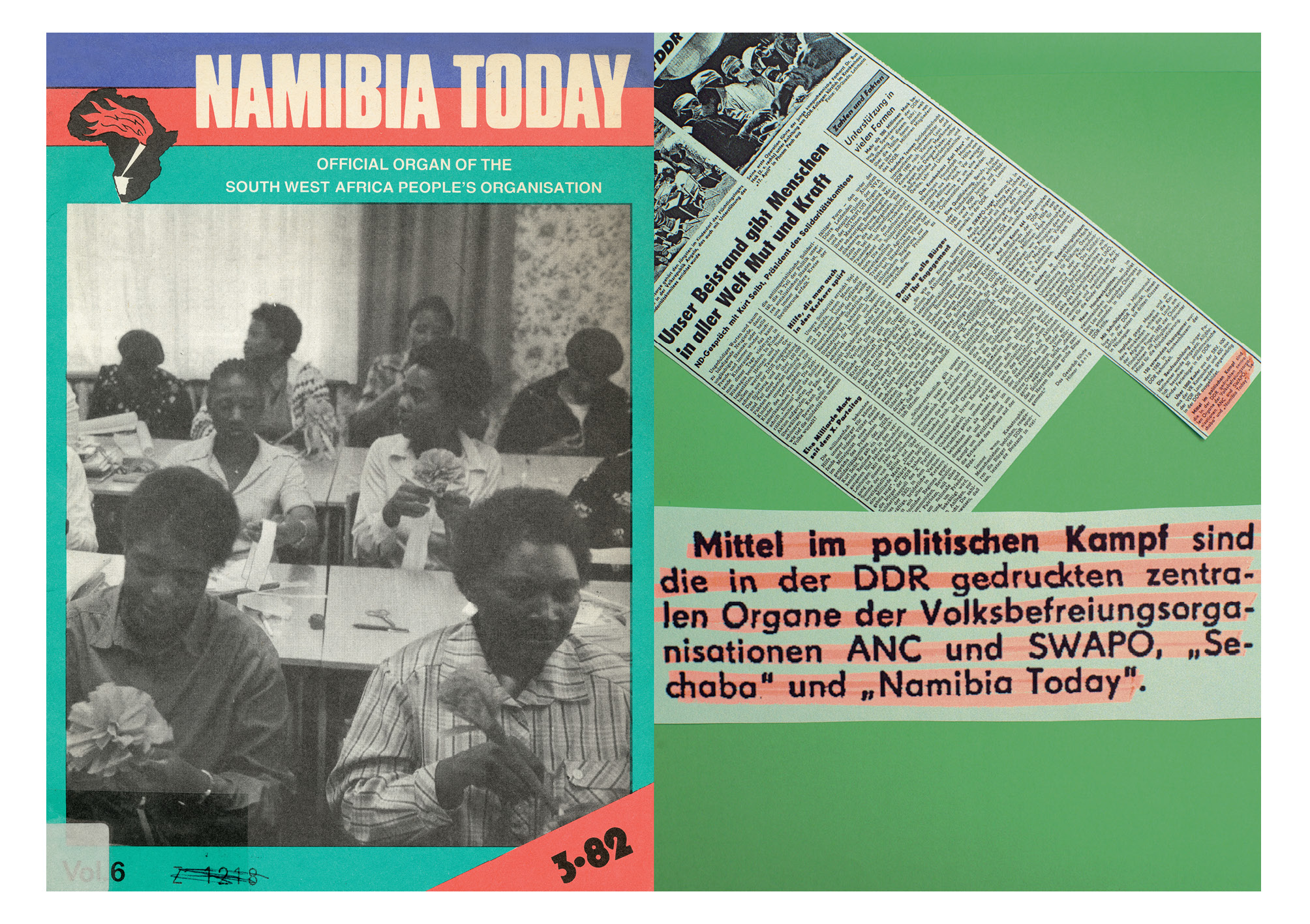
Left: Kindergarten teachers learning to make artificial
flowers. Namibia Today, Vol. 6 No. 3/82.
Friedrich-Ebert-Stiftung Library.
Right: Cuttings from Neues Deutschland, 20 Dec 1985, p. 6.
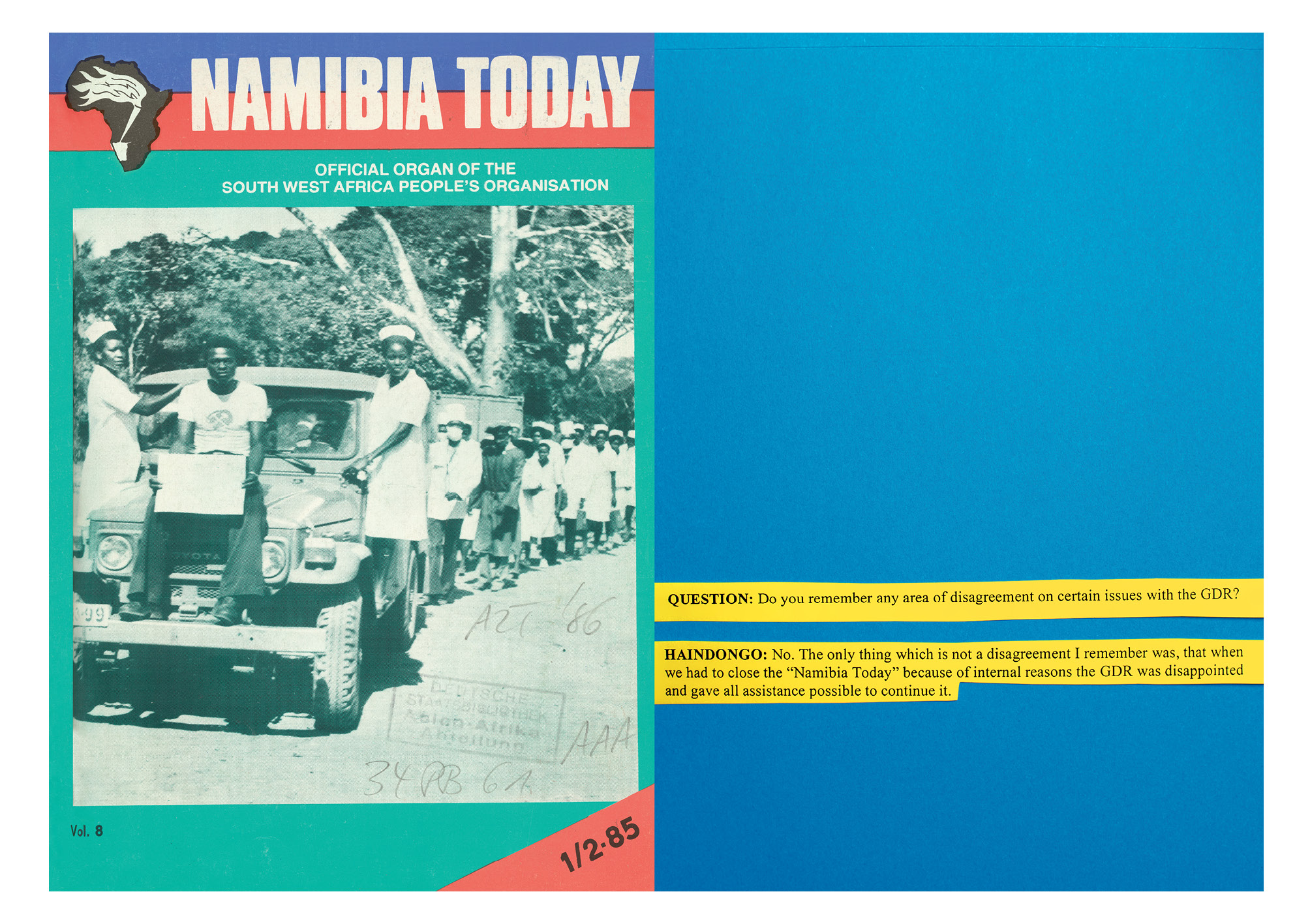
Left: Medical workers at the SWAPO Education and
Health Centre, Kwanza-Sul (Angola). Namibia
Today, Vol. 8 No. 1/2/85. Berlin State Library.
Right: Cuttings from a collection of interviews by Hans-Georg
Schleicher about the Liberation Struggle and the
Independence Process of Namibia. German Federal
Archives, BArch, SgY 46/6, p. 42–43.
Artists’ Bios
Au Sow Yee (b. 1978, Malaysia) is currently based in Taipei and Kuala Lumpur. Through hybrid forms that primarily involve videos, conceptual and installation art, Au Sow Yee’s works explore the relationship between the moving image and its production, as well as larger questions of history, politics and power. Au’s recent works focus on the liberation of history from Cold War influences, reexamine its remnants in contemporary society, and re-envision the awareness of historical issues in Malaysia and Southeast Asia at large.
Weixin Quek Chong (b. 1988, Singapore) has exhibited in London, Paris, Seoul, Singapore and Vienna among other places. Chong holds an MA in Fine Arts from the Royal College of Art, London and a BA in Fine Art from LASALLE College of the Arts, Singapore. She is fascinated by the relationships between the digital and organic, stylisation and nature, as well as surface and perceived superficiality. She is interested in material metaphors for human relationships and the psychology behind structures and projections of power, value and desire.
Laura Horelli (b. 1976, Helsinki, Finland) lives and works in Berlin, Germany. Horelli’s work has been exhibited internationally at the 49th and 53rd Venice Biennales; Manifesta 5, San Sebastian; Gwangju Biennale; Kiasma, Helsinki; n.b.k., Berlin and Goethe-Institut Nairobi. Her films have been screened at festivals like the Berlinale, IndieLisboa and CPH:DOX. In 2011 she received the Hannah Höch Prize for Young Artists from the City of Berlin. She was awarded a five-year working grant by the Arts Promotion Centre Finland in 2012. Horelli is represented by Galerie Barbara Weiss, Berlin. Namibia Today was produced for Art in the Underground, nGbK, Berlin.
Anouk Kruithof (b. 1981, Dordrecht, the Netherlands) is an artist working in Mexico City, New York and Amsterdam. Her multilayered, interdisciplinary approach encompasses photography, sculpture, installation, artist-books, text, performance, video and interventions in the public domain. Her work has been exhibited internationally at Museum of Modern Art, New York; The Stedelijk Museum, Amsterdam; MBAL Switzerland; The Xiangning Art Museum, Shenzhen China; Daegu Culture and Arts Center, Korea; Multimedia Art Museum in Moscow, among others. Kruithof received the public prize of the Volkskrant Beeldende Kunstprijs in 2016, The Meijburg Art Commission in 2015 and won the Charlotte Köhler Prize in the Netherlands in 2014.
Kedsuda Loogthong (b. 1983, Songkhla, Thailand) graduated from the Faculty of Fine and Applied Arts at Bangkok University, Thailand in 2006. Loogthong’s early works examine the urbanisation of her rural landscape and society, and how consumerism has affected the lives of country folk. Her recent works explore the materiality and symbolism of books as icons and nostalgic objects of reverence. Loogthong has participated in solo and group exhibitions including: Tomorrow and Unknown Silence (2014) at Richard Koh, Singapore; The Book of Silence (2013) at Finale Art File, Philippines; and in South Korea and Finland. Her works are part of the collection in Singapore Art Museum and in private collections in Thailand, Singapore, Malaysia and Philippines.
Maharani Mancanagara (b. 1990, Padang, Indonesia) graduated from Institut Teknologi Bandung, Faculty of Art and Design, with a major in printmaking. In 2013, she received the Soemardja Award #3 from Soemardja Gallery, and was nominated for the Indonesia Art Award. In 2014, she was nominated for the Young Artist Award from Art Show Busan, South Korea. Her works explore Indonesia’s history, from ancient times to the present, through her personal and family experiences, as well as through artefacts that belonged to her late grandfather. Maharan primarily works with printmaking, mixed media and drawing.
Hajnal Németh (b. 1972, Szőny, Hungary) creates musicals, operas, performances, films, photographs, as well as modifications of poems, songs and texts that encourage political statements. Németh has participated in solo and group exhibitions in Europe, America and Asia, including MUMOK, Vienna; Martin-Gropius-Bau, Berlin; The Kitchen, New York; Renaissance Society, Chicago; Tate Modern, London; Singapore Art Museum, Singapore; Ludwig-Museum, Budapest; TENT, Rotterdam; KW Berlin; Casino Luxembourg; Moderna Museet, Stockholm; Picasso Museum, Barcelona; Palais de Tokyo, Paris. She represented Hungary at the Venice Biennale 2011.
Nurrachmat Widyasena (b. 1990, Bandung, Indonesia) majored in printmaking at Institut Teknologi Bandung, Faculty of Art and Design. He works primarily with the applied techniques of printmaking, installation and drawing. His works explore retro-futurism and the crossroads between reality and fantasy.
Marienne Yang (b. 1983, Singapore) holds a BFA from the School of Fine Arts, The University of Tasmania, Australia, and was a recipient of the Dean’s Roll of Excellence in 2004. She completed her MA in Contemporary Practice from the University of Huddersfield in 2009, and her Postgraduate Diploma in Higher Education with the National Institute of Education in 2011. Yang’s works often depict near-pain situations that are dealt with dispassionately and from a distance. Over the years, this process has led her across disciplines: from painting to installation, photography, etchings and embroideries.
Conversation
Rirkrit Tiravanija is an artist who can easily pass through different fields of cultural knowledge. Born in Rio de Janeiro, and based in New York and Chiang Mai, he speaks of being Thai, of Buddhistic culture, of activism, democracy, being a host or not being a host, making dinner, friends, strangers, an artist making Art and not making Art, a nomad.
In recent years, Rirkrit’s work have poked holes in our beliefs in epistemological realms. Some say one approach to achieve that is through science fiction. And perhaps this begins with H. G. Wells’ The Time Machine, an idea that time is not necessarily linear, expressed as far back as 1895.
Inspired by this, Rirkrit produced in a 2014 exhibition, Time Travelers Chronicle (Doubt): 2014 – 802,701 A.D., at STPI Singapore. His work centred on investigative and fictional logs of time travel chronicles – travelling through space measured by time. In a sense, these works (as well as in his 2017 exhibition Exquisite Trust) are akin to ‘maps’ (“the vastness of time collapsed into a single encounter”)1 cluttered with insignas of pop culture (and today all culture is pop). Whether in monotype print, or created with the cast paper, or 3D printed, there is a tortoise, a hummingbird, SpongeBob, bonsai plants and yes, a martini glass – with an olive on a stick. There are unfathomed lines of connections between and among the many signs, and we may have to wear a helmet (created by future technologies) to help us decode them.
Or eschew the syntax of things.2 We are in SpongeBob’s “surreal realm of Nothingness.”3 And in that surrealness, that dream, “To wake up under the tree. Again.”4 A prediction and predilection of SpongeBob. Again. A déjà vu. A Time cycle. A repetitive blip on the radar.
Until then, according to Rirkrit, the present Utopia is chaos. “The further one travels, the closer one returns to doubt.”5
To be a traveller, to leave, to roam, to arrive (maybe), to be a nomad and, as such, exist outside philosophical thought.6 The ‘math compass’ or ‘sextant’ are relegated to the role of relics to be displayed as artefacts in a museum of the traveller’s chronicles: a déjà vu of a past encounter.
The chronicling cannot be separated from the chronicler – positionalities in the web of experience. Self-conscious, the chronicler safeguards the quest for meaning; is there an ‘I’ in the ‘who am I?’ The quest is in constant calibration either with or against the politics of vision.7
His work punctures comfortable force fields of epistemes, attempts to break free of them; introducing the familiar with the unfamiliar making it familiar again. ‘Citing’ cultural practices and imageries, and giving them these strange new contexts, inciting us to calibrate and recalibrate, so as to extend beyond or even recreate what we ‘know.’ Never settling into any field, which perplexes us, because it recalls ‘The Truth is out there,’ pulled into tension with ‘I want to Believe,’ X-filean8 clichés that dog us as we manoeuvre and fumble through our existence. The pull of the Utopian, the unfamiliar, strangeness effected by a sense of déjà vu.
The following interview9 gives an insight into Rirkrit’s thoughts, though it can only serve as oblique references to his work, as ‘dreaming’ and déjà vu can only be shadows or echoes, uncertain.
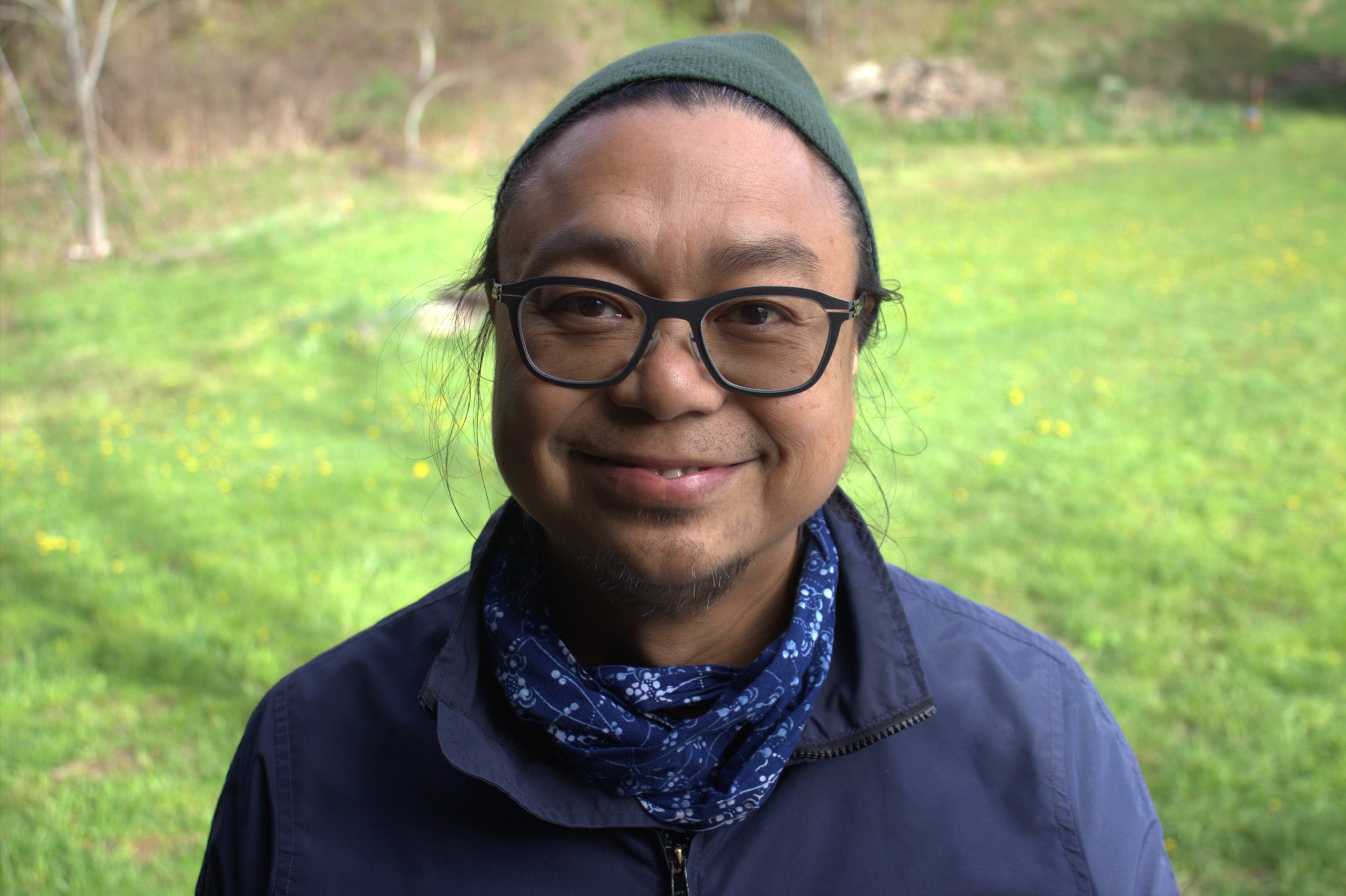
Rirkrit Tiravanija (b. Buenos Aires, Argentina) is a Thai artist, based in New York, Berlin and Chiang Mai, and is widely recognised as one of the most influential artists of his generation. His work defies media-based description, as his practice combines traditional object-making, public and private performances, teaching, and other forms of public service and social action. He is often cited as lending to critic Nicolas Bourriaud’s observations on and definition of Relational Aesthetics (Paris: Les Presses du réel, 2002).
Tiravanija is on the faculty of the School of the Arts at Columbia University, and is a founding member and curator of Utopia Station, a collective project of artists, art historians, and curators, which was seeded in Venice Biennale in 2003. Tiravanija is also President of an educational-ecological project known as ‘the land foundation,’ located in Chiang Mai, Thailand.
In recent years, he had exhibited twice in Singapore at the Singapore Tyler Print Institute (STPI): in 2014 with Time Travelers Chronicle (Doubt): 2014 – 802,701 A.D. and in 2017, in a group exhibition Exquisite Trust.
Susie
In your food events, what does the preparation and serving of food facilitate? I recall how you and my M.A. classmates took over the preparation — including the marketing — of food that you served at my place way back in 2006 or 2007 in Singapore. All I could do was enjoy the process and the food. What you did then was circumnavigate through all the classmates’ homes to engage in this process which involved, at times, family and cats.
This was obviously very different from enacting this event in the “gallery.”
Rirkrit
Well, my initial interest in food and the circumstances surrounding cooking—the preparation of food and the social relationship—[stemmed from] my interest in questioning Western colonialist hegemonic prescription of otherness. I was looking at encyclopaedic collections of museums in the West, i.e. the Metropolitan Museum in New York; the Museum of Natural History in New York; the Field Museum in Chicago; the Art Institute of Chicago (where there is a large holding of Thai artefacts), [and] finding myself asking, “What are ‘they’ thinking of me, when ‘they’ look at these artefacts, and am I in that position?” The position of otherness, the position of the object, of the process without knowing. How is the centre circumscribing the periphery and assigning positions, assigning values, naming, categorising, making representations of the unknown; and pressing their language into knowledge, into history, into cultures?
I was interested in, what I assigned to myself, the need to retrieve culture, to retrieve my identity, from the assigned hegemony; and in [using] the process of making dinner, making cuisine, making (in my own image) my daily circumstances, as ways to make different readings, different meaning, differentness as the otherness.
Of course in my culture (Thai), and perhaps in many cultures, the situation of living, the conditions prescribed in the living condition are visibly (have been, and perhaps now in flux) prioritised over the objectness of life. In Thai culture, togetherness is practised without much apprehension, without much negotiation, as our values are not assigned to the external (objectness) but rather to the internal. The spatial value of private and public are [neither] assigned nor given, property (was) not demarcated with centres and peripheries. We enter into the spaces of otherness without feeling the others apart, but rather we enter into togetherness. We give what we have without the expectation of reciprocity, without return, as the return will always come in the future (afterlife, or next life, perhaps).
So, it was not about making Art; it was not about having to act or make or produce Art, but rather to act and be in the moment, to do and be in the nature. Perhaps, in the West, making and being and doing and living in a particular context, all those movements can be circumscribed as Art. The everyday as I live it becomes my retrieval (of culture) of myself within the hegemony forced upon my existence; to live in the everyday, the normal, the ordinary, the unspectacular, is the resistance to become commodified.
Susie
There are many ways of looking at this as an “art event,” and yet not. What are you thoughts about this?

At the land foundation
Courtesy of the artist
Photo: Francesca Grassi, 2004.
Rirkrit
So, yes, I’d rather be eating and drinking with students, with friends, with strangers, than [making] Art.
Susie
Could you speak about the role of the host in some of your projects?
Rirkrit
I am not at all interested in [being] a host, I think we are all hosts and we are all guests. Hosting implies one giving and another receiving; as I have mentioned above, I am interested in togetherness and, in that, there cannot be hierarchy, there cannot be the other. But I like the biological host, which implies carrying parasites, carrying otherness within, making a destabilised whole.
Susie
From social practice to civil protests, based on images that are culled from mass media, can you speak about the protest drawings and how it relates to your other projects –Demonstration Drawings (2006) for instance?
Rirkri
As mentioned, I am interested in destabilised centres, it’s an interest in representation, [interest] in the known versus the unknown, the mass versus the few, the receiver and the transmitter. Perhaps it is [because of the] confluence of circumstances that people (the mass) are becoming more visible. The faceless now have Facebook, that one is instantly “liked,” the confluences of the private becoming public. Perhaps the language (usage) needs to also become more resistant, more poetic and less self-centred. The condition of a demonstration is about the poetics of representation, of voices, of refusing to be identified and named by the centre, by the hegemony.
Susie
Your practice feels very democratic and non-hierarchical, how did this kind of practice come about?
Rirkrit
Perhaps growing up in a Buddhistic culture, and I mean culture rather than religion. The religion is still hierarchical and the assignment of power is important to those in the religion when, in fact, it is only a practice. It is about circumstances and how one can live best under those circumstances, to practice (what is that anyway?) and raise oneself beyond oneself. Democracy is (presently) like [any other] religion. We are all asked to conform to the ideal of such an idea, as it is used and interpreted by the hierarchy, the hegemony; as an alibi to circumscribe us and corral us into believing that we are living without hierarchy, without hegemony; that we have a voice and that we are entrusted with the rights to speak and be heard. But who is listening and who is speaking? We can see and hear that we are living in the delusional sea of Democracy. Access to speech is meaningless when that speech is just a tweet of abbreviated thoughts.
Susie
Tell us about the land foundation project and your community activism. What is the current status? Unfortunately the online website is rather limited.
Rirkrit
The land foundation is ongoing; the rice is growing and mangoes ripen on the trees, everyone around is active and projects are in the process of being realised. It’s difficult to describe a process, or a length of time which we have no interest [in measuring], or [defining]. I suppose, we would like it to be itself, have its own life, perhaps the land (always without capitals, purposefully) is a good example of a host. It is a host of others, a host of organisms which coexist without hierarchy, without order. It hosts parasites without the fear of losing itself, it does not intend to represent but is, in itself, a representation. The lack of information is as intentional as it is unnamed or uncapitalised. It is and can be what we want it to be [as a collective], and what we want it to be for ourselves. Perhaps it is a state of being everything and nothingness.
Susie
For your work, DO WE DREAM UNDER THE SAME SKY, what is the “same sky?” and how do you posit the question of difference?
Rirkrit
Right now in the world we have a problem with difference. [The] reason why we are not in a better world is [because we are] not understanding difference in a big way. If we think we are supposed to be in better place because we have gone through civilisation and nightmares; if we [should] be in a better place and we are not, we have to ask why and the ‘why’ can be answered by Donald Trump. Because we are still voting for people like Donald Trump. Giving power to people who don’t really care about [a] better world. They only care about themselves. That’s everywhere. It makes problems in Thailand look small. We thought Populism is such a huge problem; it really divided the country. Now the [world’s] Number One Democracy is being shredded by stupid idiotic ideas. Humanity is incapable of betterment. Consciousness doesn’t go further.
Susie
What is Utopia to you?

DO WE DREAM UNDER THE SAME SKY
Art Basel in Basel 2015
© Art Basel
Rirkrit
– Chaos.
Susie
Not the reverse?
Rirkrit
Western [ideas] of order and sameness, and maybe Singapore’s as well, is wrong. It is not possible to make [humans] conform to structure. That’s not Utopia. Utopia is everybody being different and being able to live together. Chaos; living in chaos and not blowing up and killing everyone – that’s Utopia.
Susie
This idea of living together and this idea of sharing…
Rirkrit
It’s not about sharing.
Susie
We do share the sky?
Rirkrit
With Donald Trump there won’t be a sky, there will be a big ozone hole. We will all burn to death. [For him] to be put in a position of a world leader and to have no compassion… if there was any inkling of it, it is all pretence. [That’s] how world war starts. They do not see a future, the future is false. To say I am doing this so that America becomes great again. What kind of reality is that? To be ‘great’ over whom?
We need to reconsider what is the sky we are living under, and there will be [oppositions]; there will be people coming together. For the people coming together, they have to understand why it’s not just a reaction, not just ‘against’ something. It has to be ‘for’ something. That’s what [we have to] make sure we understand. Everyone has different issues they are concerned [about], everyone has different realities, but in the end we all have to think about each other.
So, if you thought that we could make a dinner, and everyone could come and sit and eat together, and talk to each other, and that would change the world; and well, it hasn’t really changed the world, [then] what does it mean? It means we have to keep going, we have to keep doing it—keep pounding into their heads that we have to sit with other people, understand that difference and respect that difference, and smells and sounds and – codes.

DO WE DREAM UNDER THE SAME SKY
Art Basel in Basel 2015
© Art Basel
Susie
Do you think success [is also dependent on privilege]? When you say making dinner and all that – who is able to do that?
Rirkrit
To have time to think is a privilege. A lot of people do not have time to think because they have to survive. That’s what I am saying—because everyone is coming out, reacting, and trying to resist. But one has to understand that, maybe, it’s not about resistance but more about understanding the other. You are not there to think for someone else.
Susie
As an artist what is your role?
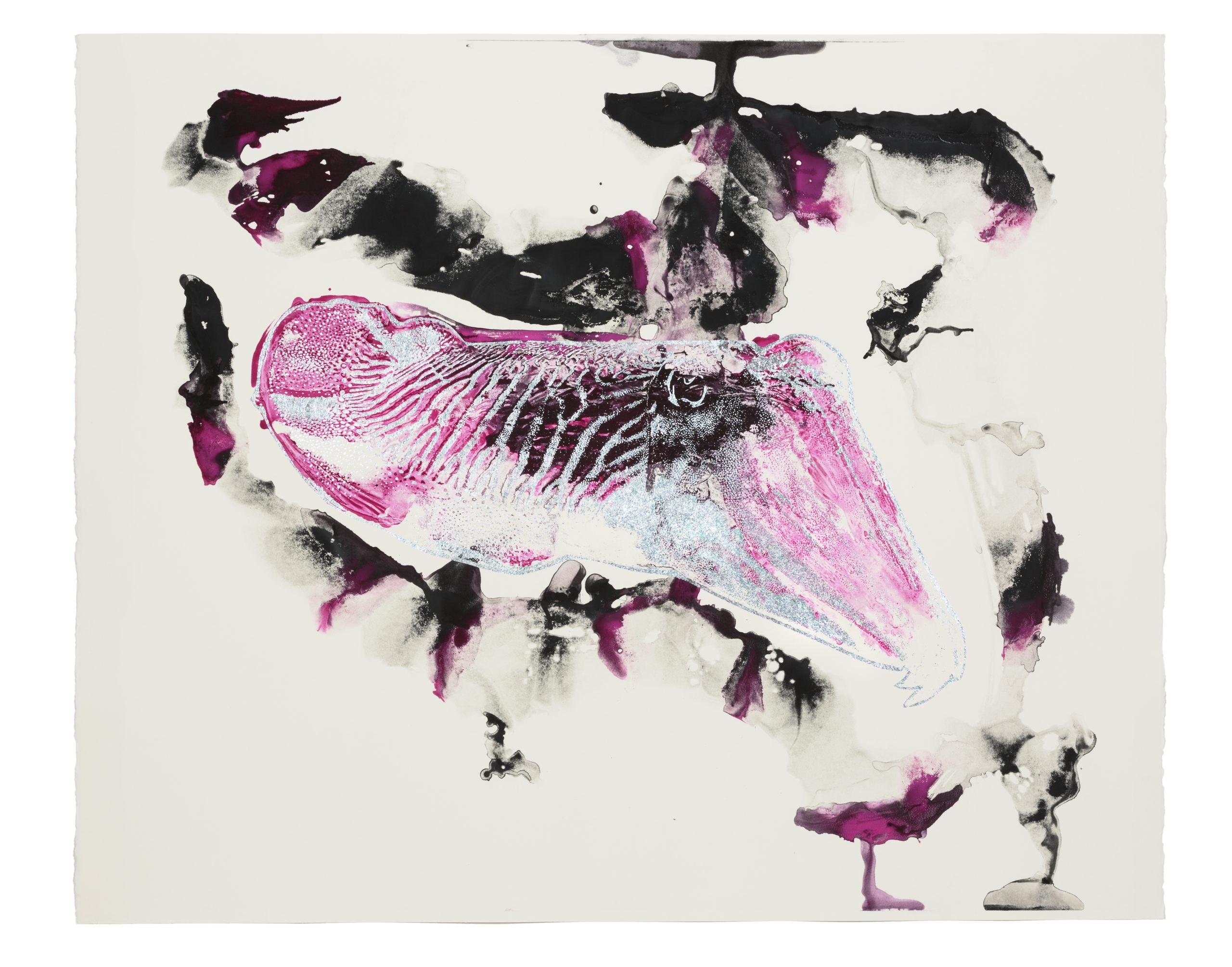
Untitled 2017, (bodhisattva appears in crimson tide), 2016.
Water-based monotype, metal foil on Saunder’s paper, 114 x 140 cm.
Artwork produced at STPI - Creative Workshop & Gallery, Singapore
© Rirkrit Tiravanija/STPI.
Installation images of “Exquisite Trust (Blindly Collective Collaborations)”, STPI Gallery, 2017.
Courtesy of STPI. Photo: Katariina Traeskelin

Untitled 2017, (bodhisattva reflections in the silver seas), 2016.
Water-based monotype, metal foil on Saunders paper, 114 x 140 cm.
Artwork produced at STPI - Creative Workshop & Gallery, Singapore
© Rirkrit Tiravanija/STPI.
Installation images of “Exquisite Trust (Blindly Collective Collaborations)”, STPI Gallery, 2017.
Courtesy of STPI. Photo: Katariina Traeskelin
Rirkrit
My role is to sit here and make statements that will get into the magazine [laughs]. And hopefully more people will read it. [The] life of an artist is to live [out those statements] and maybe, one day, people will look at it and realise that it’s possible. I always think one has to…I’d like say I’m living the way I talk. Because a lot of people are not living the way they talk. So that is my concern.
Susie
Let’s get back to food as metaphor, in this case - your relational work. At the last we touched on non-hierarchical and democratic ideas.
Rirkrit
I’d rather say ‘open.’ Those words are understood as if they mean more, and actually they are just words. What I’m trying to say is it’s more about accepting. Accepting the other.
Susie
In terms of the gallery, and in terms of practising art in the gallery system, who is the other?
Rirkrit
I’m in every other system; I don’t think I’m in one system. The gallery is one system to use, to put things out. I don’t think of it that way. The ‘other’ is everybody like myself. It’s not about [the] gallery or not [the] gallery or street or museum. Everything is the same. [I work with a gallery] and, actually, galleries support a lot that is not supported outside of it. A lot of ideas come out of [the] gallery, a lot of art comes out of people being supported by galleries, so I don’t see it as being you know… it’s how you use it. But I don’t see the point [of it being] the only system. I do many things that nobody sees; it doesn’t mean I have to make it visible.
Susie
At the beginning of this interview you were saying, “making normal again.” Does that mean not having the (and this is my word) trappings of the gallery?
Rirkrit
You are only trapped by yourself; it’s not the gallery, it’s not anything, it is just yourself.
Susie
Bodhisattva coming out here [laughs].
Rirkrit
You are the trap, not the gallery and, again, it’s about how you use it. [There are] galleries who try to do very good things and promote very good things but, of course, it’s not the only way.
Susie
What are the other ways?
Rirkrit
The other ways, for me, are to do everything you can do, if possible; or not do anything at all. There are reasons to do things and reasons to not do things. That’s all the other ways.
Susie
With you, is everything so well considered?
Rirkrit
No, I am not enlightened [laughs]. We are always trying to figure things out. Some people try to figure different things. I’d like more balanced things, a more balanced life. On the other hand, if I get to say things because people want to have someone say something, then I would say it. I mean, personally, I would like to sit under a tree and not speak to anyone. But at the same time, if there are things to be said and to be done, and you can do it without killing yourself, then you should do it.
Susie
The point I’m trying to get at, is whether there is an inside and outside of [the] gallery for your practice.
Rirkrit
Why would you want to have an inside and outside? No, I mean there is always an inside and [an] outside, but it does not mean that it’s divided. You live a life; you can’t split your life. If I’m making dinner for 100 people, it doesn’t mean I’m making a show; I’m just making dinner for 100 people. Actually it’s easier to make dinner for 100 than dinner for two. [If] you are going to make something, you might as well make it for more. If you are going to put in energy to make something, it’s the same energy. So it’s harder to make just for two, because you use as much energy, and then there’s less. So I don’t see it, I don’t make the dichotomy. I think it’s like, the world thinks in dichotomies but that doesn’t mean one needs to.
Susie
Does it apply to your life, of being born somewhere else and being in Thailand now. Do you feel in that sense of being categorised, or demarcated? At some points, you identify yourself as a Thai national and at some points, hearing you speak, it’s as if your position is as an American.
Rirkrit
No, I don’t feel that. I criticise everything [laughs]. I speak about America because it’s what everybody is measuring up against, you know? Or Americans like to think that everyone is measuring up to them. But no, I don’t privilege it.
I’m reading Édouard Glissant. He’s talking about a kind of nomadism as a kind of creative act, and creativity being, a relational thing. So he’s coming form Martinique, a former colony [of France], and he can’t be bothered to resist speaking French, to fight the colonialist. Because for him, language can be used creatively and it’s creativity that makes the difference. At least that is how I’m interpreting it. Which means it’s true—I can be in whatever structure and I would, just say, be creative; use it in a way that is not oppressive. The book is Poetics of Relation. He’s from Martinique, the Caribbean. It’s about being Creole. It’s about creating another language out of whatever exists. And, one could say, in the context of proper language and proper structure, that it’s an abuse of language. But, rather than that, one could also say that abuse can be creative input. So language is changing.
Susie
How about Singlish, using English badly?
Rirkrit
Yes, but that’s an identity formation. It’s not about [creativity]. It’s more about what’s the attitude. If you are using [it] creatively, you are not oppressed. If you use it because you are oppressed, then you are oppressed.
Susie
Do you think we are all nomads today?
Rirkrit
We could be because we have access to everything. And I don’t mean we have to move. We can go everywhere without moving. We are trying to walk around a frame and we don’t get an answer. That is the point. We don’t want to pin everything down. You can’t. You have to understand you are always moving. [That’s] always the problem with Western philosophy: they think they can pin everything down, and then they realise it’s a mistake, it’s not true. And there’s always another truth.
Susie
Which becomes a contradiction.
Rirkrit
Not a contradiction, we are not frozen. Again this comes with creativity. If we are no longer creative, we would not have a future.
Susie
What do you think is the objective of creativity?
Rirkrit
To not be dead. To be alive.
Susie
To be alive, as in, to have a reason to be alive?
Rirkrit
To be alive means to accept change and to move through that, and that’s part of the problem of not understanding difference. If you don’t understand change, you can’t understand difference. You are changing all the time and everything else around you is changing. Therefore, they are not going to be the same.
Susie
And here, we can go back to Donald Trump.
Rirkrit
We can’t expect White and Germany to rule the world all the time and be happy with the best jobs, which is what Trump says he wants to have again. It comes from not understanding difference. And if you don’t understand difference you will never make a better world. Because [Trump] just wants to make the world a picture that [he believes] in. Which is not even true. The 50s and even 60s were not the best of times; whatever they thought was the best of times were not. It’s a fragmented [idea of] reality. They were blowing nuclear bombs on paradise. That’s not making a better world. I have to think a lot about why we are trying to do anything. Why? What for? [I] used to say, as [an artist], I would like to make people more conscious. Actually, people are not becoming more conscious. There’s more knowledge, there’s more information, but they are not becoming more conscious. They are becoming dumber. Why? I’m not blaming anyone, I’m just asking “why?” Maybe when we are thinking about a better world, we are just thinking about ourselves.
Susie
So thinking of a better world brings us back to the idea of a Utopia.
Rirkrit
Well, it’s about thinking of others, maybe it’s about thinking holistically. You can’t think in fragments, you have to think about the bigger picture.
Susie
It’s difficult to pin down something like that. It’s rhetorical.
Rirkrit
No you don’t pin it down, you just do it.
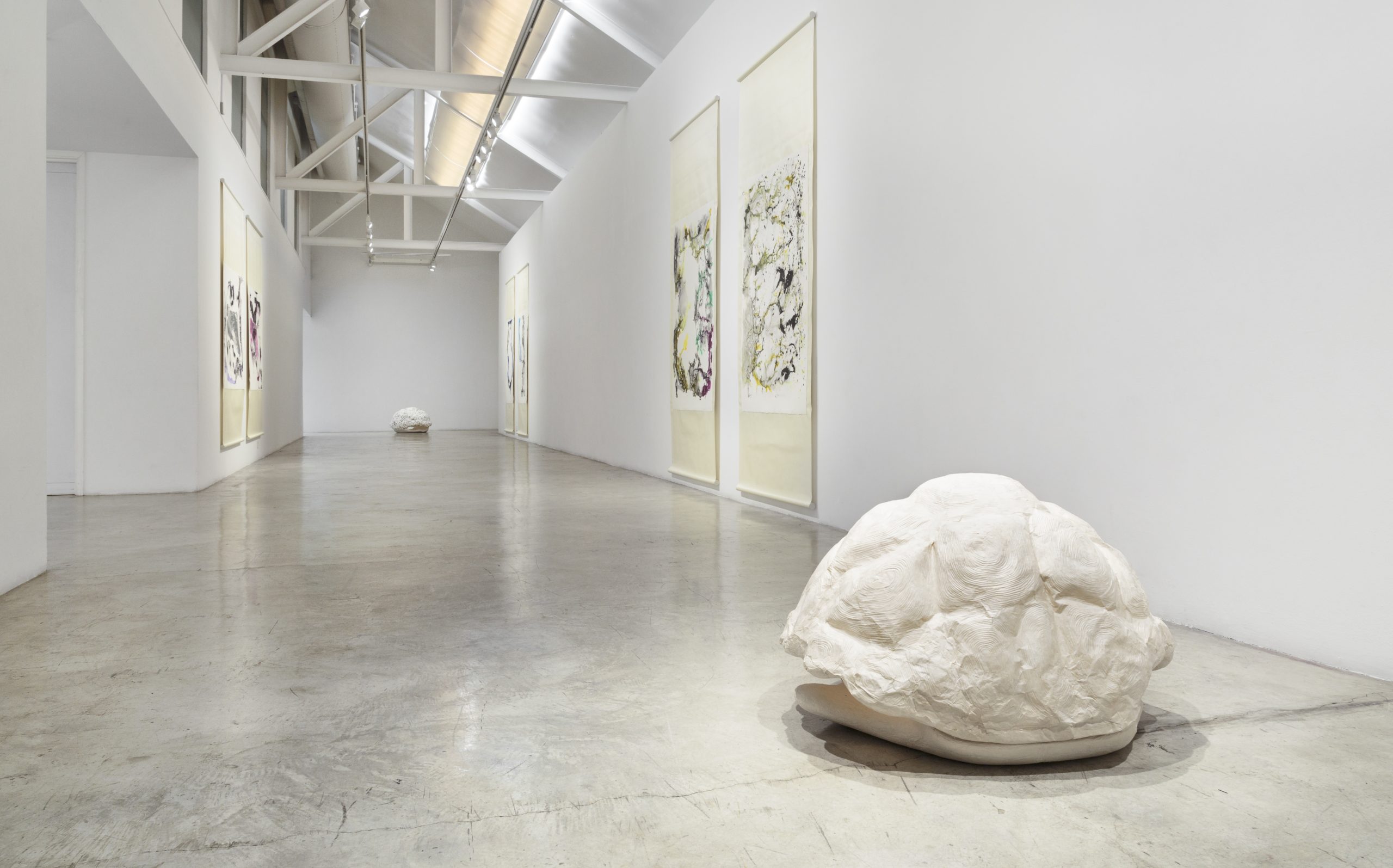
Untitled 2017, (a drop in the drain can change the ocean), 2016.
Installation view.
Casting with STPI handmade mulberry paper, 55 x 75 x 85 cm.
Artwork produced at STPI - Creative Workshop & Gallery, Singapore]
© Rirkrit Tiravanija/STPI. Installation images of “Exquisite Trust (Blindly Collective Collaborations)”, STPI Gallery, 2017.
Courtesy of STPI. Photo: Katariina Traeskelin
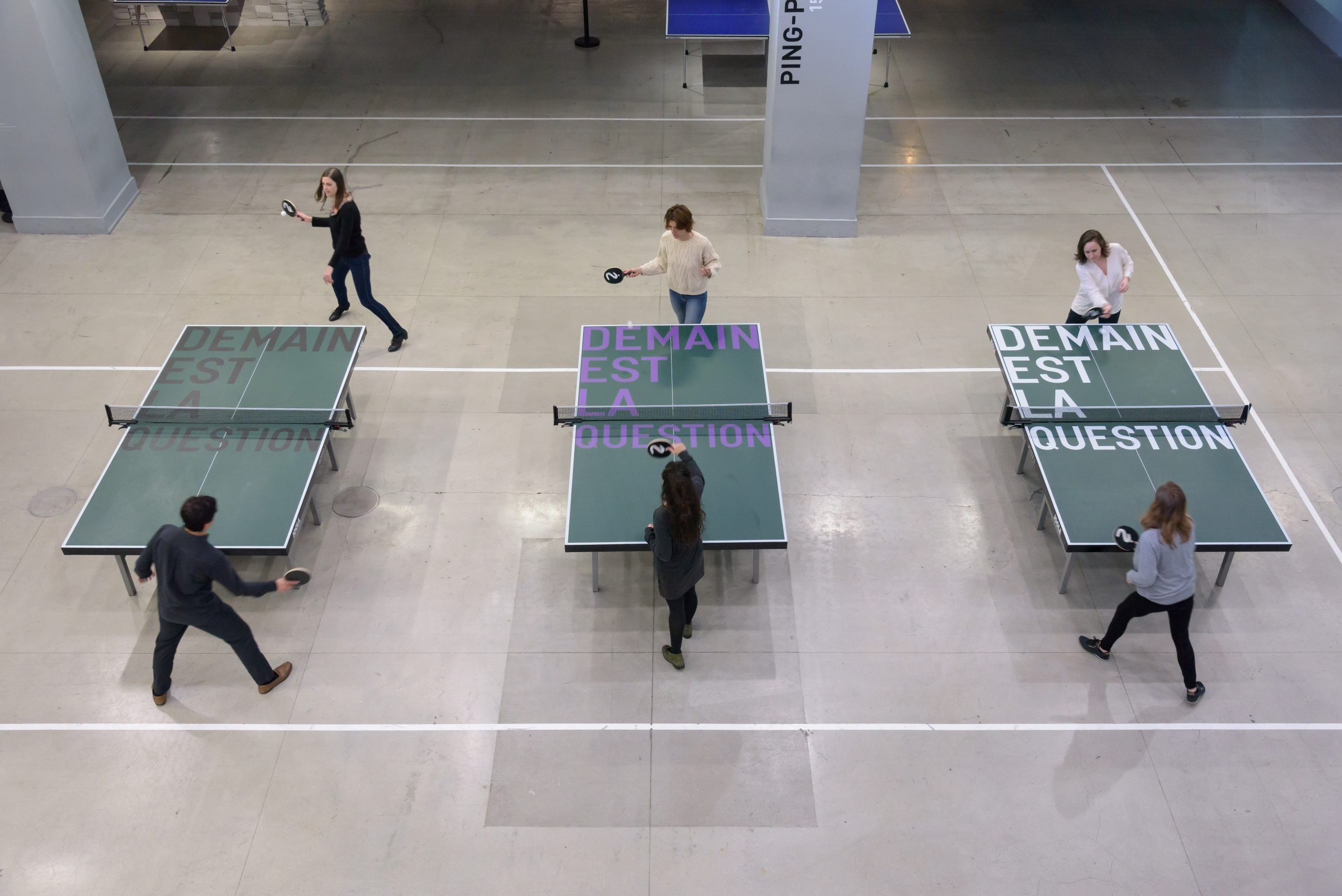
untitled (demain est la question), 2015
Courtesy of the artist and Galerie Chantal Crousel, Paris
Photo: Florian Kleinefenn, 2015.
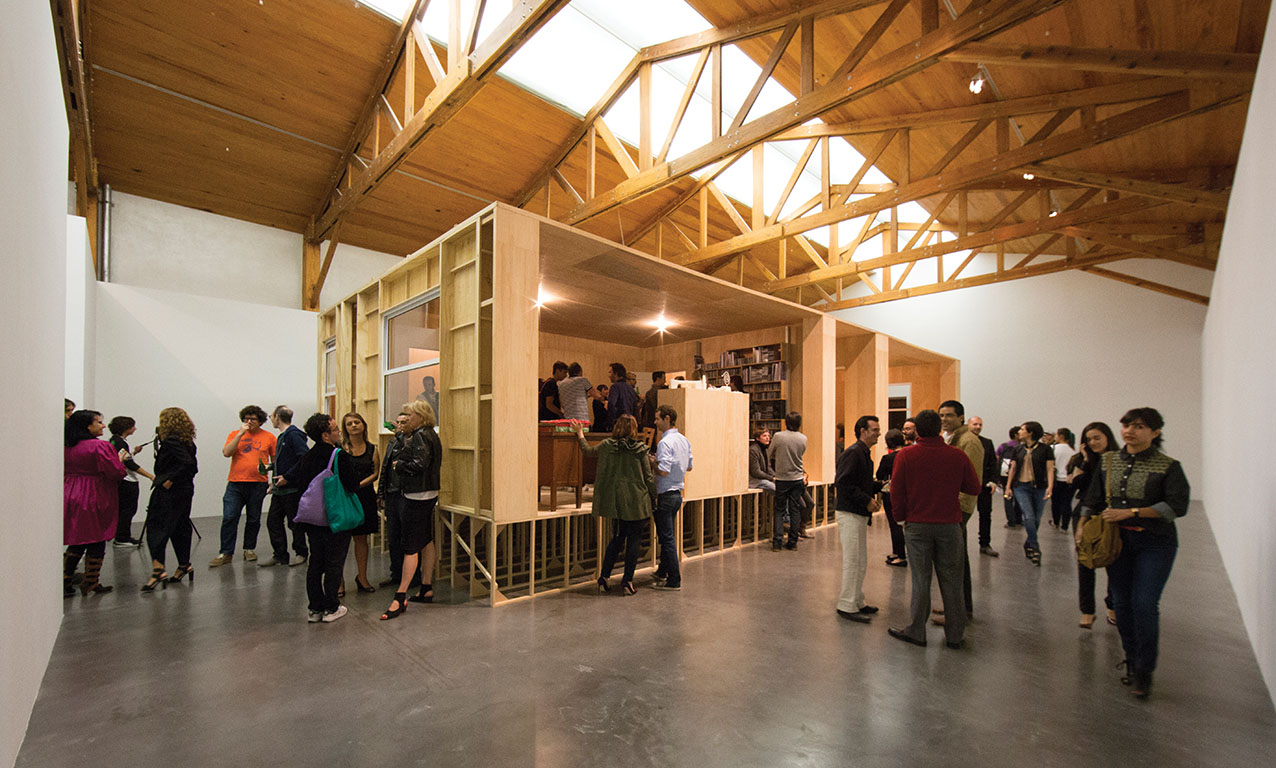
untitled (all those years at no. 17e london terrace), 2012.
Courtesy of the artist and kurimanzutto, Mexico City
Photo: Estudio Michel Zabé, 2012.
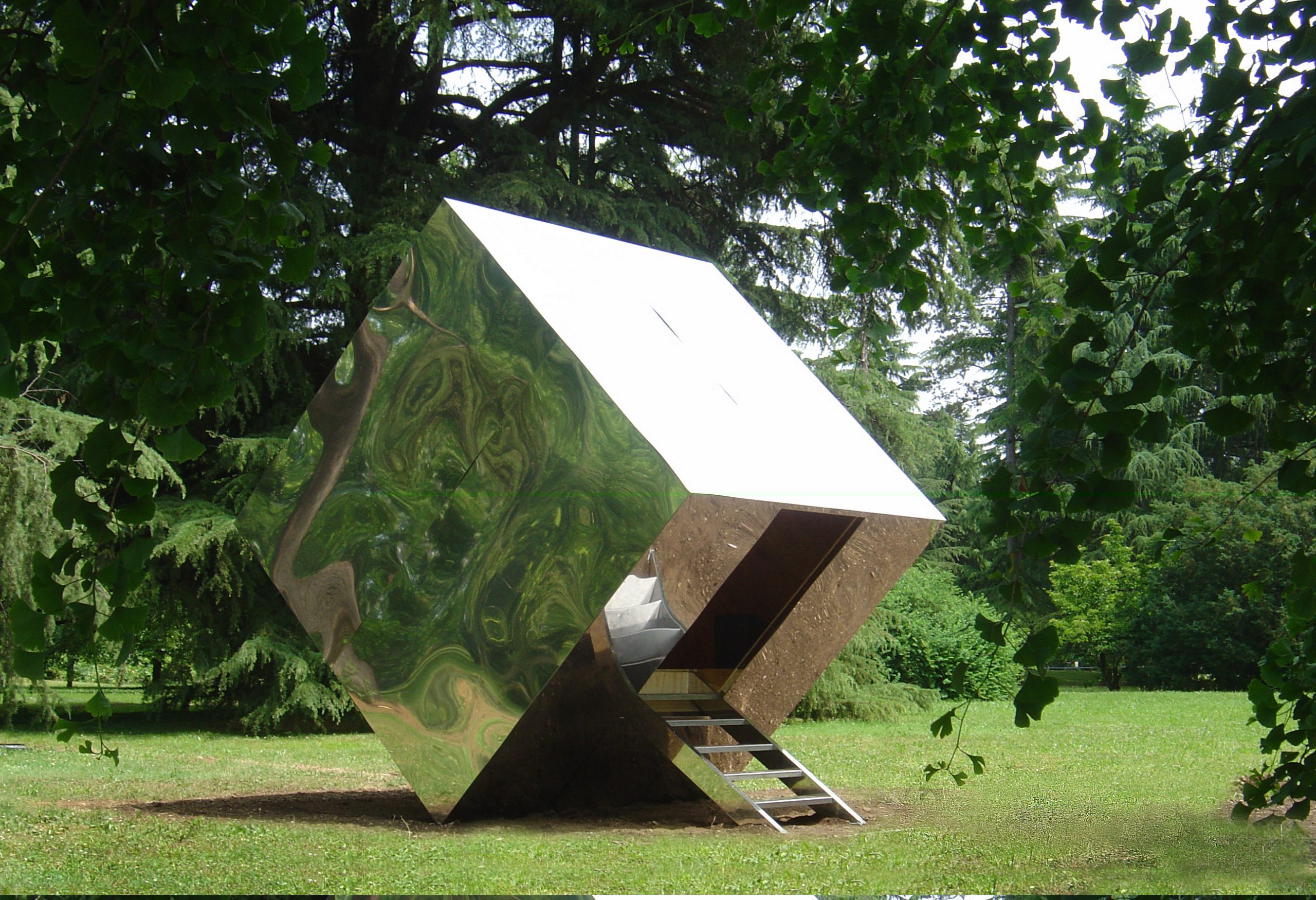
untitled (tilted teahouse with coffeemachine), 2005
Courtesy of the artist and neugerriemschneider, Berlin
Photo: Sillani, 2005.
© Rirkrit Tiravanija
Footnotes
1 Text from Time Travelers.
2 E. E Cummings, “Since Feeling is First.” is 5 (NY, London: Liveright, 1985) 93.
3 Text from Time Travelers.
4 Text from Time Travelers.
5 Text from Time Travelers.
6 “Nomad thought is not confined to philosophy,” writes Brian Massumi, in the foreword, Thousand Plateaus, Capitalism and Schizophrenia by Gilles Deleuze and Félix Guattari, trans. by Brian Massumi (NY, London: Continuum, 1987) xi.
7 Norman Bryson, “The Gaze in the Expanded Field,” Vision and Visuality, ed. by Hal Foster (Seattle: Bay Press, 1988) 107.
8 X-Files is an American science fiction TV series created by Chris Carter that aired from 1993 to 2002.
9 Interviews conducted on 7-9th July 2016 and 15th March 2017 (emails and transcriptions).
References
Bryson, Norman. “The Gaze in the Expanded field,” Vision and Visuality, edited by Hal Foster. Seattle: Bay Press, 1988.
Cummings, E. E. “Since Feeling is First,” is 5. NY, London: Liveright, 1985. Print.
Deleuze, Gilles and Guattari, Félix. Thousand Plateaus, Capitalism and Schizophrenia, translated by Brian Massumi, NY, London: Continuum, 1987. Print.
Contributors’ Bios
Contributors’ Bios
Mitha Budhyarto (b. Jakarta, Indonesia) received her PhD in Humanities and Cultural Studies from Birkbeck College, University of London in 2011 with a thesis entitled The Phenomenology of Nonplaces: Body, Memory, Aesthetics. Currently a faculty member at LASALLE College of the Arts, she lectures in Cultural and Contextual Studies at the School of Spatial and Product Design and is also the coordinating lecturer for Contextual Studies in the Diploma programmes under the Faculty of Design.
Joseph Curiale (b. 1955, Connecticut, US) is a lecturer at LASALLE College of the Arts in Singapore where he teaches Pop Music History, Music Production, Music Business and courses in popular music performance.
He is a three-time CNN Hero nominee, and an Emmy Award-nominated composer, arranger and producer of music for film, television and audio recordings. With 26 years of experience in Hollywood, Joseph Curiale has worked with more than 100 artists, such as Michael Jackson, Janet Jackson, Ray Charles, Little Richard, Santana, Frank Sinatra, Sammy Davis Jr., and opera star Kathleen Battle. Curiale has also worked, in a variety of capacities, with almost all the major Hollywood film companies. He was the first staff songwriter in Columbia Pictures’ history with an exclusive six-year contract. He also composed, arranged and produced music for nearly 100 television shows, popular recordings, and hit movies such as Steve Martin’s Roxanne. Curiale received the first of several gold and platinum records for his contribution to the #1 motion picture soundtrack, Breakin’ (Breakdance: the Movie), which introduced breakdancing to the world.
Among the number of significant works are a recording of Gates of Gold (1995) with The Royal Philharmonic Orchestra; and his symphonic compositions, Awakening (1997) and The Music of Life (2001), featuring the London Symphony and Royal Philharmonic Orchestras, as well as soloists from China and Japan. He has also authored the books, The Spirit of Creativity and The Wisdom of Creativity.
Frank DeMeglio (b. 1965, Detroit, Michigan) is a classical music teacher, lecturer and writer. He has taught part-time at LASALLE since 2003 and joined the faculty in 2009. Of particular interest to Frank is the efficient technical approach to the keyboard that aligns with sound biomechanical principals, especially with respect to injury prevention and cure. He studied piano at the University of Michigan and earned a Bachelors degree in Performance. After graduating, he taught with Randy and Nancy Faber, authors of the best-selling Piano Adventures library of piano books. He returned to the University of Michigan for an MBA in marketing in 1992, and was hired by Steinway & Sons as their New York Institutional Sales Representative. While working for Steinway & Sons, part of his duties included managing the famed Steinway Selection Room of concert and studio grand pianos. In 2000, Frank DeMeglio moved to Singapore where he wrote classical music reviews for The Business Times from 2001 to 2004. He continues to guest review (most recently for the 2007 Singapore International Piano Festival) and his interviews of international pedagogues and performers appear in print and online. DeMeglio’s modest performing career included recitals in Spain and Japan, where he recorded a special-release CD in honour of the 15th anniversary of the UNESCO chapter of Narita City, Japan.
Patrick D. Flores (b. 1969, Manila, Philippines) is professor in the department of Art Studies at the University of the Philippines, which he chaired from 1997 to 2003, and Curator of the Vargas Museum in Manila. He was one of the curators of Under Construction: New Dimensions of Asian Art in 2000 and the Gwangju Biennale (Position Papers) in 2008. He was a Visiting Fellow at the National Gallery of Art in Washington, D.C. in 1999 and an Asian Public Intellectuals Fellow in 2004. Among his publications are Painting History: Revisions in Philippine Colonial Art (1998); Remarkable Collection: Art, History, and the National Museum (2007); and Past Peripheral: Curation in Southeast Asia (2008). He was a grantee of the Asian Cultural Council (2010), a member of the Advisory Board of the exhibition The Global Contemporary. Art Worlds After 1989 (2011) organised by the Center for Art and Media in Karlsruhe, and member of the Guggenheim Museum’s Asian Art Council (2011 and 2014). He co-edited the Southeast Asian issue with Joan Kee for Third Text (2011). In 2013, for the Clark Institute and the Department of Art Studies of the University of the Philippines, he convened the conference “Histories of Art History in Southeast Asia” in Manila. He was a Guest Scholar of the Getty Research Institute in Los Angeles in 2014. He curated an exhibition of contemporary art from Southeast Asia and Southeast Europe titled South by Southeast and the Philippine Pavilion at the Venice Biennale in 2015.
Janis Jefferies (London) is an artist, writer, researcher and curator. She is Professor of Visual Arts and Research at Goldsmiths College, University of London. She is Research Fellow at the Constance Howard Resource and Research Centre in Textiles and was Creative Thinking Fellow at the University of Auckland. Trained as a painter and in woven construction, she pioneered the field of contemporary textiles within visual and material culture internationally and has exhibited and published widely. Her areas of expertise lie at the intersection of arts and technology (textiles, performance, sound, and publishing). She is one of the founding editors of Textile: The Journal of Cloth and Culture and co-editor of the first Handbook of Textile Culture.
Mischa Kuball (b. 1959, Düsseldorf, Germany) has been working in the public sphere since 1987. He uses light as a medium to explore architectual space as well as social and political discourse in his installations and photographs. Reflecting on a variety of aspects from sociocultural structures to architectural interventions, Kuball’s work emphasises or reinterprets their monumental nature and context in architectual history. Public and private space merge into an indistinguishable whole in politically-motivated participation projects, providing a platform for communication between the audience, the artist, the work, and public space.
Since 2007, Mischa Kuball has been a Professor at the Academy of Media Arts, Cologne, associate professor for media art at Hochschule für Gestaltung/ZKM, Karlsruhe, and since 2015, a member of the North Rhine-Westphalian Academy of Sciences, Humanities and the Arts, Düsseldorf. In January 2016, he was honoured with the German Light Award.
Vanessa Joan Müller (b. 1968, Hamburg) is a freelance curator. Müller graduated from the Ruhr-Universität Bochum with a degree in art history and film studies. From 2000 to 2005 she worked as a curator at the Frankfurter Kunstverein in Frankfurt, and in late 2005 became academic director of the project European Kunsthalle in Cologne, which explores different models for a potential art institution. In September 2006, she was also appointed director of the Kunstverein für die Rheinlande und Westfalen in Düsseldorf, Germany. Currently working as curator for scenography at Kunsthalle Wien in Vienna, Austria, Müller has curated exhibitions for Frankfurter Kunstverein such as non-places (2002), New Heimat (2001), and Adorno: The possibility of the impossible (co-curated with Nicolaus Schafhausen) (2004). She has also devised a programme of lectures and events entitled Under Construction for the European Kunsthalle, also with Nicolaus Schafhausen.
Tim O’Dwyer (Melbourne, Australia) is a saxophonist and composer, and has been a lecturer and Head of Music at LASALLE College of the Arts, Singapore, since 2004. As a leading figure of the avant-garde in Melbourne in the 1990s, he was one of the founding members of the infamous underground punk/free/jazz group, bucketrider, and created the improvised music series The Make It Up Club that has now been running for close to 20 years. During this time, he was awarded a grant by the Australia Council to study saxophone with the visionary improviser Evan Parker in London and composition with Richard Barrett in Amsterdam. O’Dwyer is currently a member of the two most prestigious and established contemporary music ensembles in Australia: ELISION Ensemble (since 1994) and The Australian Art Orchestra. Recently, he became one of the inaugural Fellows at the Academy of the Arts of the World, Cologne, Germany, and is currently a scholar with the creator of soundpainting, Walter Thompson. In addition, he continues to perform locally and internationally with his hybrid saxophone and electronics project: The META – SAX; the international collaborative project: The Fold, with ensembles currently based in Cologne, Germany and Singapore; and his soundpainting ensemble: Erik Satay & The Kampong Arkestra based in Singapore. O’Dwyer has performed his original works at festivals and venues throughout the world including the Montreux Jazz Festival, Switzerland; Huddersfield Contemporary Music Festival, United Kingdom; Sydney Opera House, Australia; and Radio Bremen, Germany. His recordings have been published by the seminal British label Leo Records; Ujikaji Records, Singapore; Creative Sources, Portugal; Vox Australis, Australia; and Dr Jim’s Records, Australia. Tim holds a PhD in composition and philosophy from the Queensland University of Technology with his research drawing links between the philosophy of Gilles Deleuze, composition, and improvisation.
Sava Stepanov (b. 1951, Serbia, former Yugoslavia) is a visual arts critic and gallerist. He has arranged many exhibitions in the country and abroad, participated in numerous exhibitions in Yugoslavia, Serbia, Montenegro, and elsewhere. He is the art director of several international exhibitions. He has published texts in numerous catalogues, professional magazines, and collections. He has written screenplays for television programmes and documentaries on art and photography.
A selection of his books and monographs include: Light Scripts (1981); Need for Painting (1988); Sculpture by Olga Jevric (2001); Anthology of Serbian painting of the second half of the XX century (with Đ. Kadijević and S. Bošnjak) (2004); Sculpture by Jovan Soldatović (2010); Filo Filipović (with J. Denegri, Z. Gavrić) (2011); After Memory: The Art of Milenko Prvački – 40 years (with C. Merewether) (2013); About drawing and draftsmen (2011), After 2000 (2013); Venice Reflections (2013); Art without boundaries - Serbian-Hungarian artistic connections (2014), Premonition, blood, hope, Art in Vojvodina and Serbia (1914-2014) (2014); Sculpture by Slobodan Kojić ( 2017).
Stepanov has also received numerous accolades including the following awards: for art criticism at the Pančevo Exhibition of Yugoslav Sculpture, 1985; Culture Centre of Vojvodina; Culture Spark Culture-educational Centre for Vojvodina, Novi Sad, 1994; the Society of Art Historians of Serbia for the Best Author Exhibition in Serbia, Belgrade; Lazar Trifunović (2011); Vertical for art criticism (2011).
Jessica Berlanga Taylor (b. 1979, Mexico) is an art critic and curator. She holds an MA in Art History and a specialisation in Gender Studies. She is Chief Curator at Alumnos47 Foundation, a non-profit organisation in Mexico City where she coordinates research projects and public programming such as Liminal Zones, a trans-disciplinary, collaborative project that engages with the diversity of interactions between social art practices, Critical Pedagogy and Gender Studies; Proyecto Líquido, an open-ended curatorial project committed to exploring alternative curatorial formats and commissioning new performance art; and Sincrónico, a year-long workshop with established artists for emerging artists. She has published in Frieze, Art Forum, national newspapers and magazines as well as catalogues (Hammer Museum, Vancouver Art Gallery, MUAC-Mexico) and books (Código: Art and culture from Mexico). She was the editor of the online magazine “re-d: art, visual culture and gender studies” for The National Autonomous University of Mexico (UNAM). She is interested in exploring the relationships between contemporary art and other disciplines such as gender studies, human rights, literature and public space in order to imagine and materialise the present and nearby futures, where creation and collaboration lead the way.
June Yap (Singapore) is an independent curator, previously Deputy Director and Curator of the Institute of Contemporary Arts Singapore, and curator at the Singapore Art Museum. Selected curatorial projects include Dear Painter with Sundaram Tagore Gallery; No Country: Contemporary Art for South and Southeast Asia for the Guggenheim UBS MAP Global Art Initiative; The Cloud of Unknowing at the 54th Venice Biennale, Italy; The Future of Exhibition: It Feels Like I’ve Been Here Before at the Institute of Contemporary Arts, Singapore; Das Paradies ist Anderswo / Paradise is Elsewhere at Institut für Auslandsbeziehungen, Germany; and Bound for Glory at the National University of Singapore Museum.
Milenko Prvački (b. 1951, Serbia, former Yugoslavia) graduated with a Master of Fine Arts (Painting) from the Institutul de Arte Plastice “Nicolae Grigorescu” in Bucharest, Romania. He is one of the Singapore’s foremost artists and art educators, having taught at LASALLE College of the Arts since 1994. The founder of Tropical Lab, an annual international art camp for graduate students, Prvački was Dean of the Faculty of Fine Arts for 10 years, and is currently Senior Fellow, Office of the President at the College.
He has exhibited extensively in Europe since 1971, and in Singapore and the region since 1993 and had participated in major exhibitions, most notably the Biennale of Sydney in 2006. He has also participated in numerous symposiums and art workshops worldwide, and acted as visiting professor at Musashino Art University in Japan, Sabanci University in Turkey and University of Washington School of Art, USA. He is Adjunct Professor at RMIT University, Melbourne, Australia.
He was awarded the Chevalier de l’Ordre des Arts et des Lettres by the French government in 2011, and Singapore’s Cultural Medallion for Visual Arts in 2012.
Venka Purushothaman (Singapore) is an art writer, academic, and arts and cultural manager. He is currently Vice-President (Academic) and Provost at LASALLE College of the Arts, Singapore.
He has researched and written extensively on visual arts, performing arts and arts management with an interest in contemporary art. He has written essays on numerous artists including Pierre & Gilles (France), Nathalie Junod Ponsard (France), Parvati Nayar (India), Salleh Japar (Singapore). His artist monographs include: The Art of Sukumar Bose: Reflections on South and Southeast Asia (2013); Dance Me through the Dark: The Photography of Tan Ngiap Heng (2008); and Salleh Japar: Gurindam dan Igauan (2004). His books on arts and culture include Making Visible the Invisible: Three Decades of the Singapore Arts Festival (2007) and Narratives: Notes on a Cultural Journey, Cultural Medallion Recipients, 1979-2002 (2002).
Susie Wong (Singapore) is an art writer, curator and artist.
She contributes to several publications in Singapore: she was a regular art reviewer in the 1990s for The Straits Times, Life! Singapore; and a regular art feature writer for magazines such as The Arts Magazine (publ. The Esplanade); ID; and d+a in architecture and design, and has written for artists’ monographs. She has written for publications such as Southeast Asia Today (publ. Roeder, 1995); Liu Kang: Colourful Modernist (publ. The National Art Gallery Singapore, 2011); and Histories, Practices, Interventions (publ. Institute of Contemporary Arts Singapore, 2016). She is a member of AICA (International Association of Art Critics - Singapore Chapter). She has published two special edition art books: Trace (2008) and Tracing Land (2014). In 2014, she also edited and published [The Machine] Contemplating the Body after a group exhibition she curated at Singapore General Hospital (SGH) Museum.

